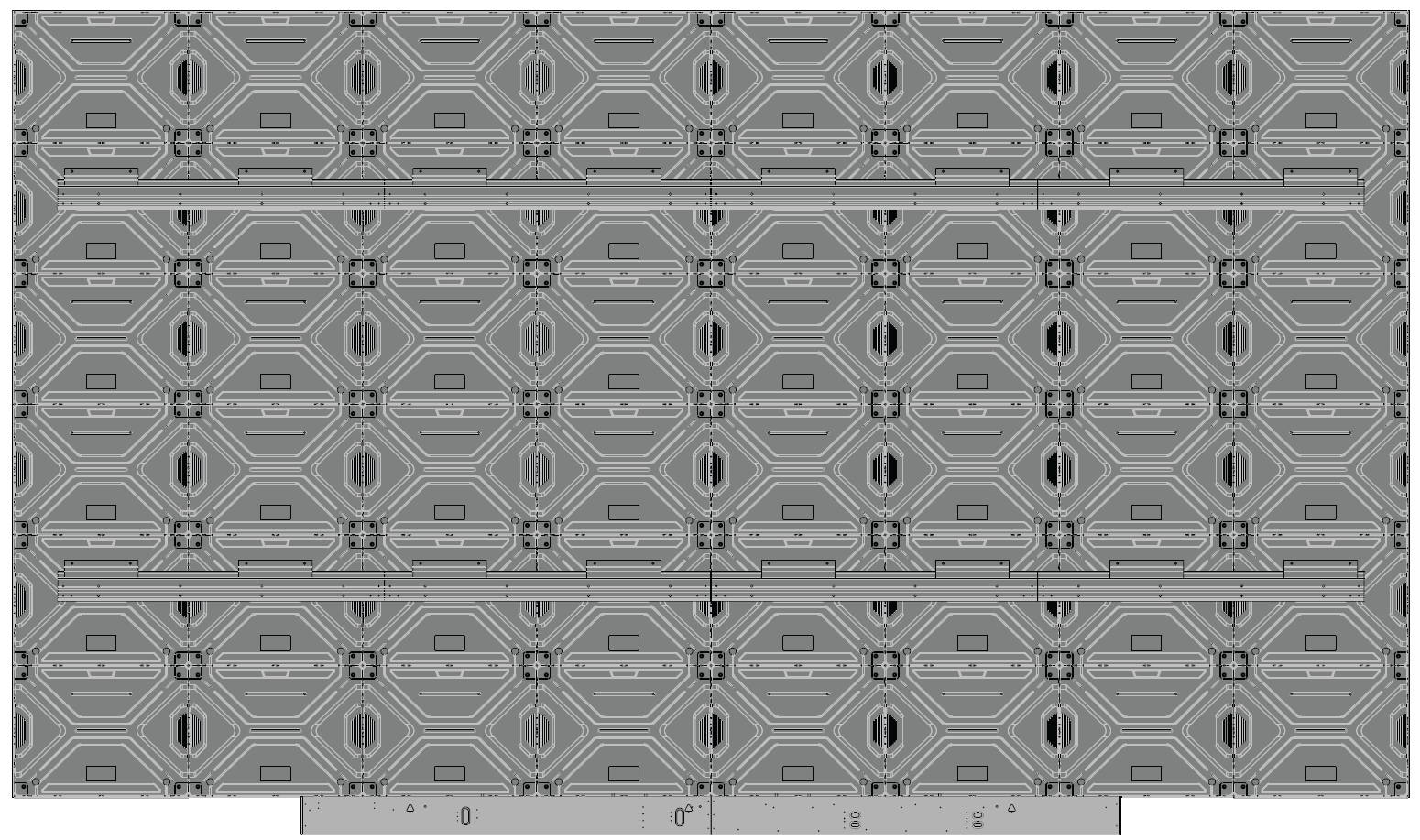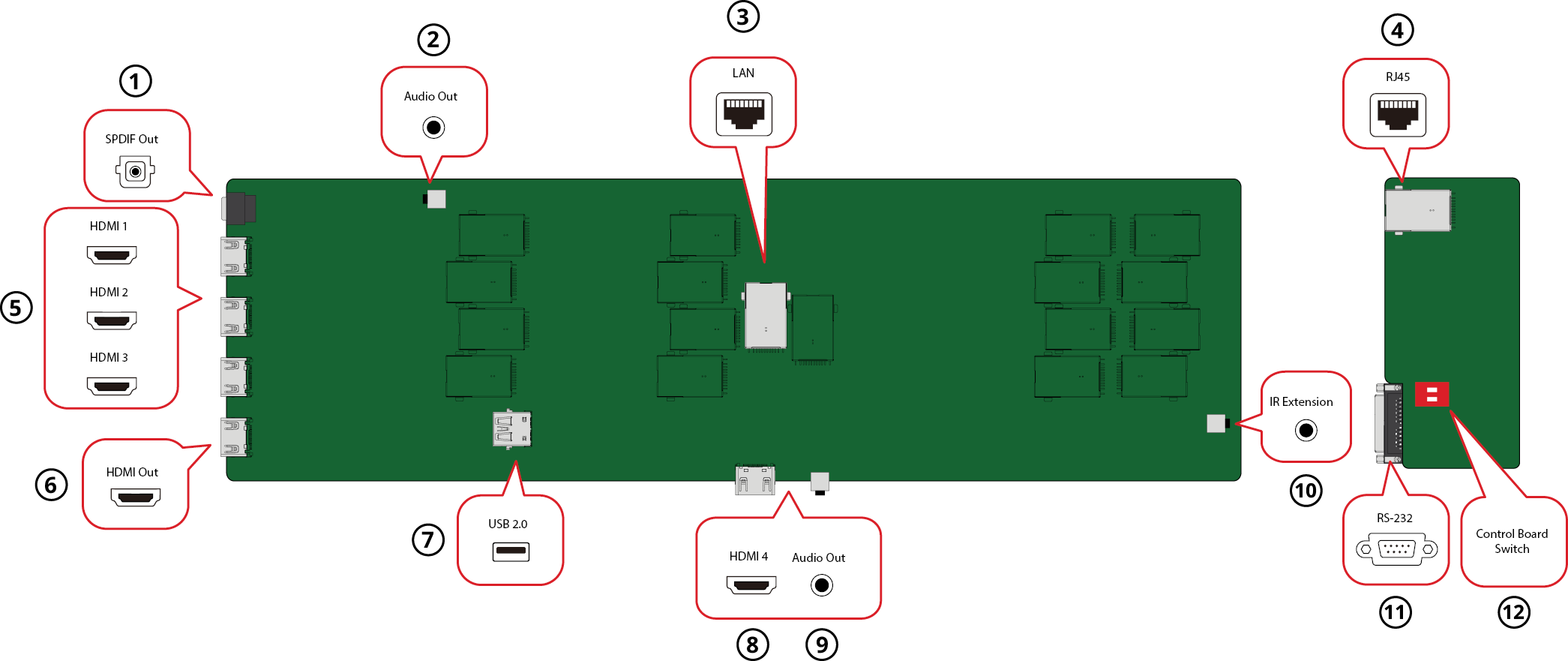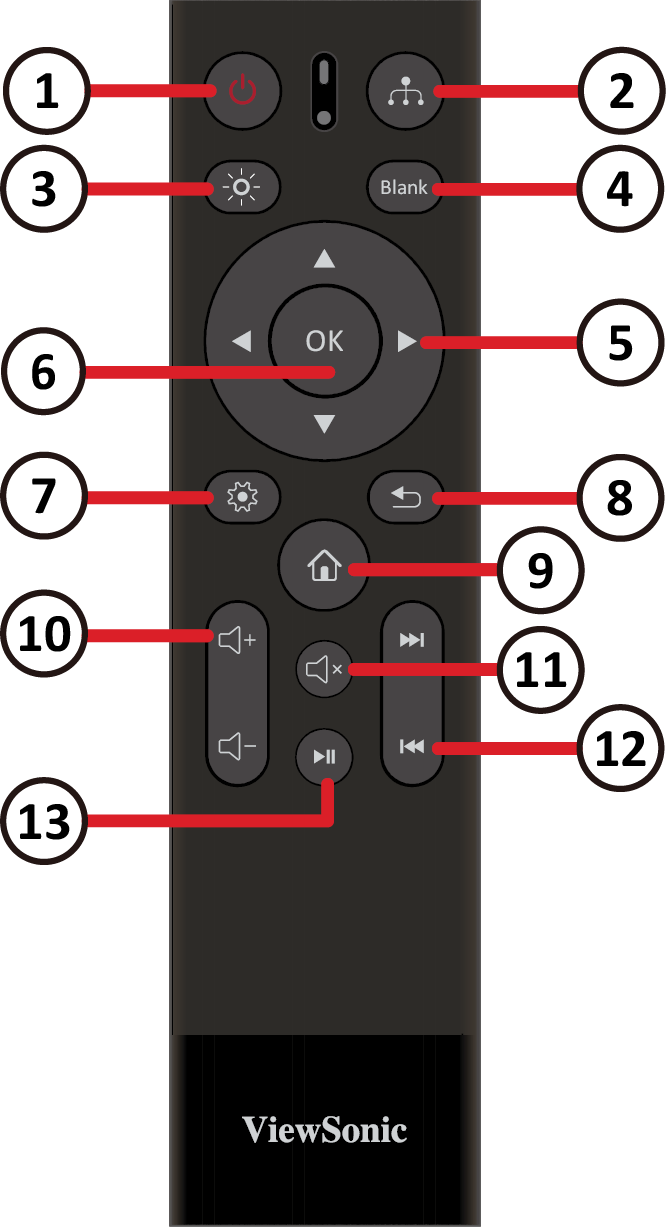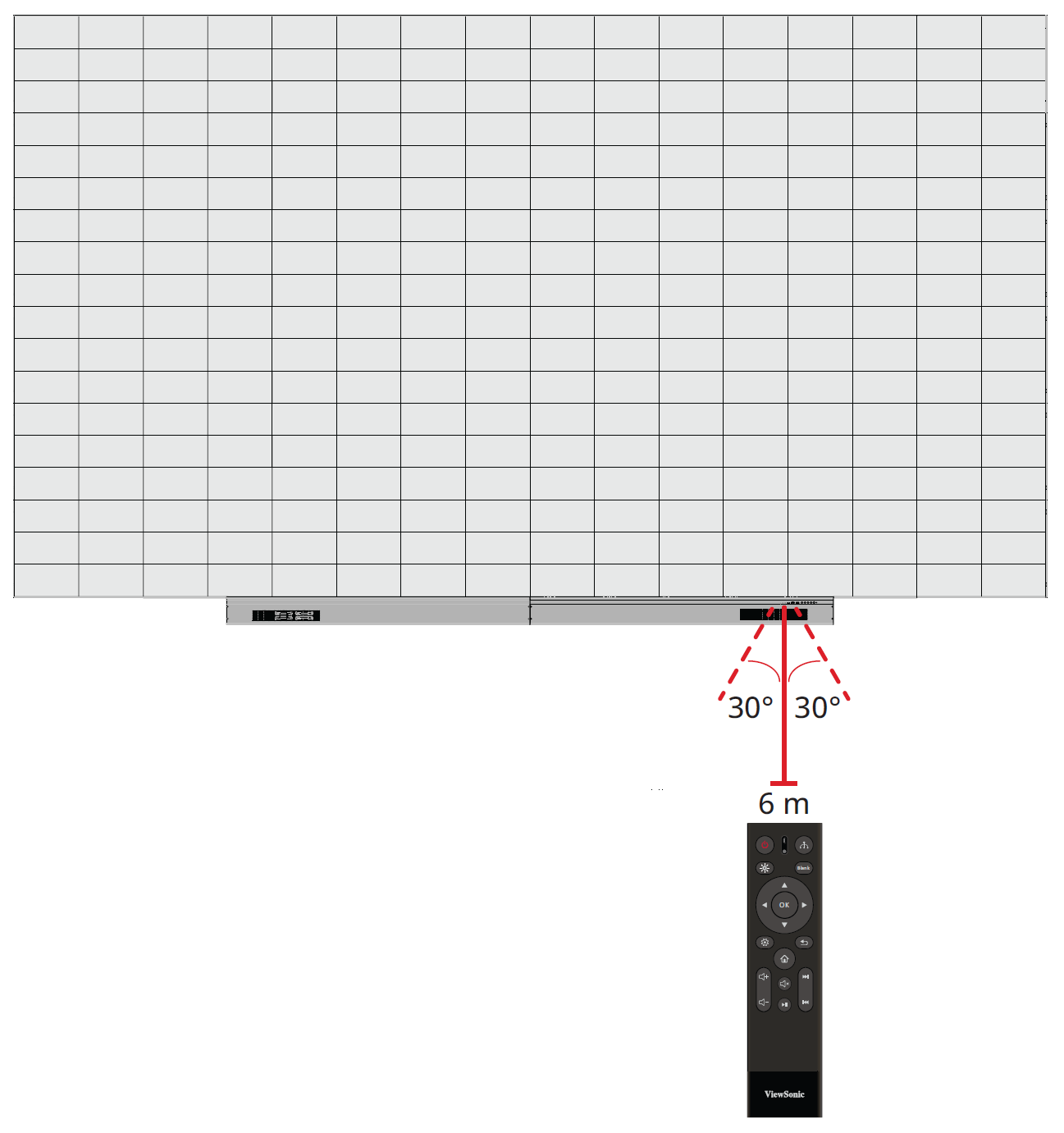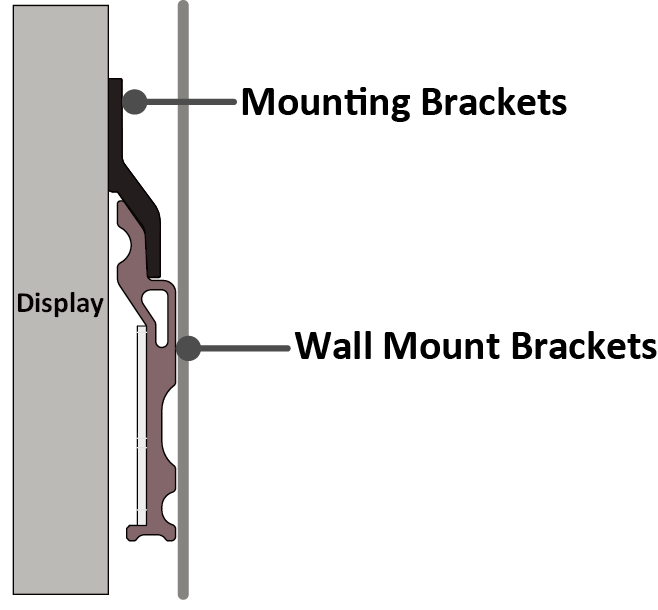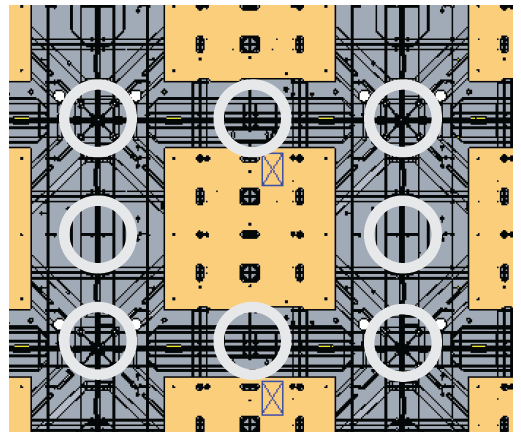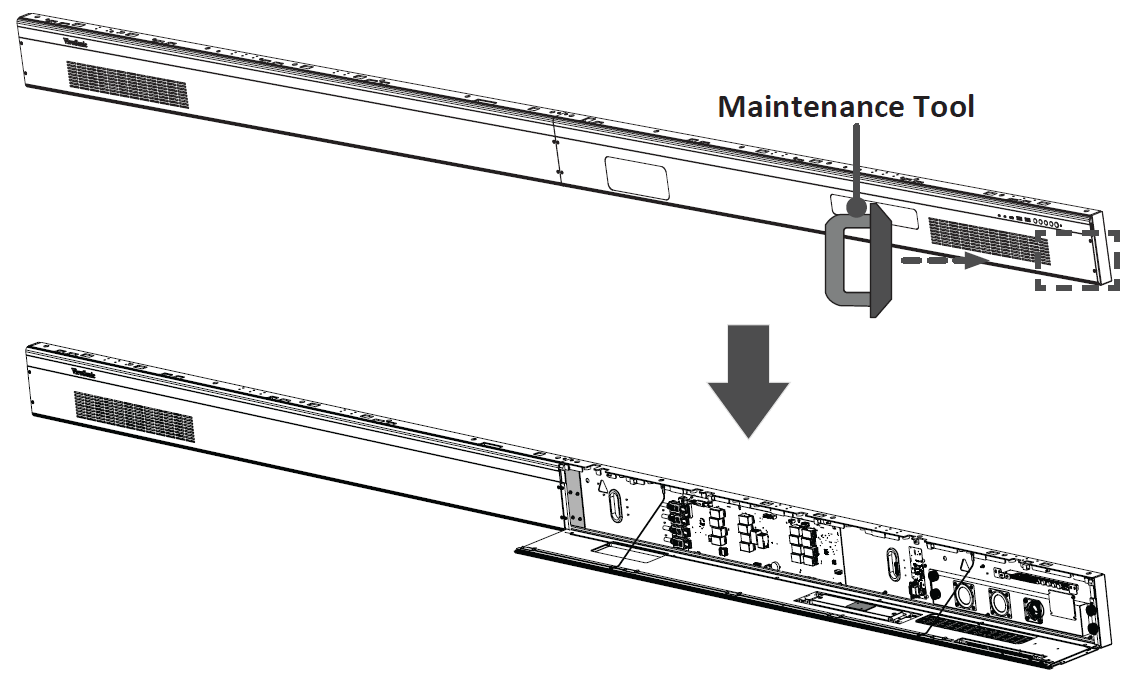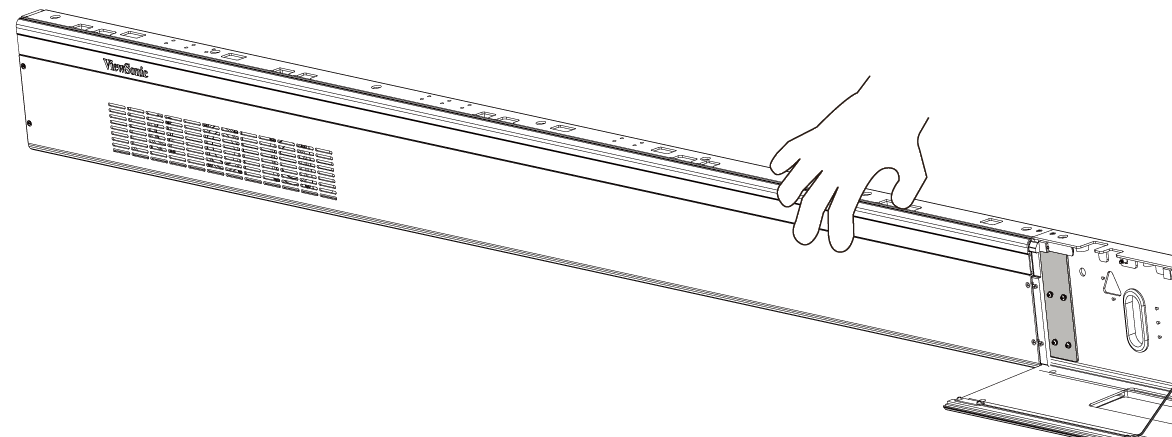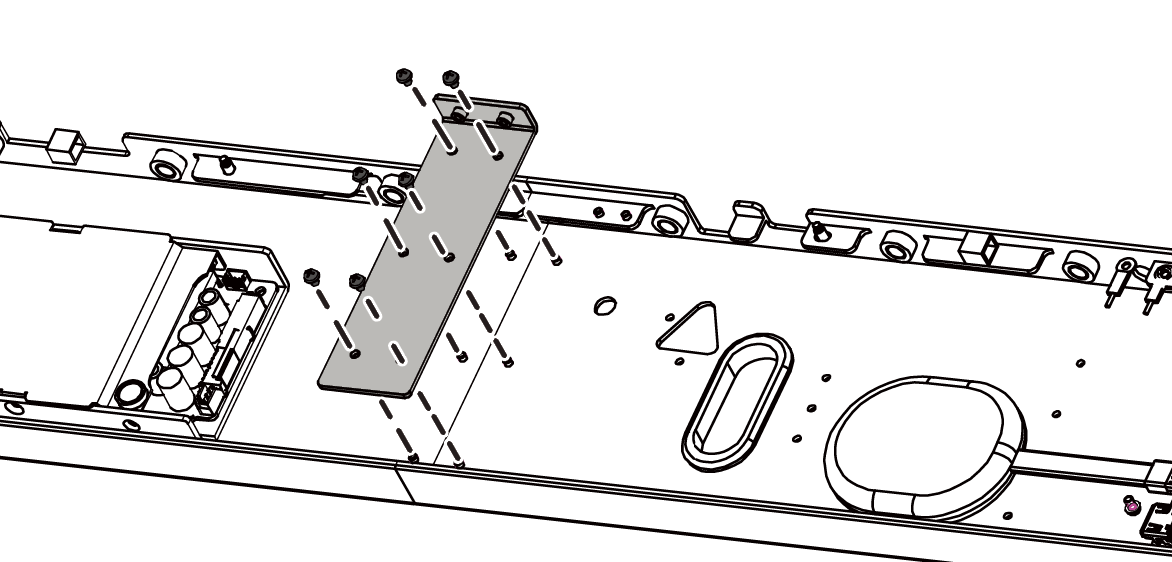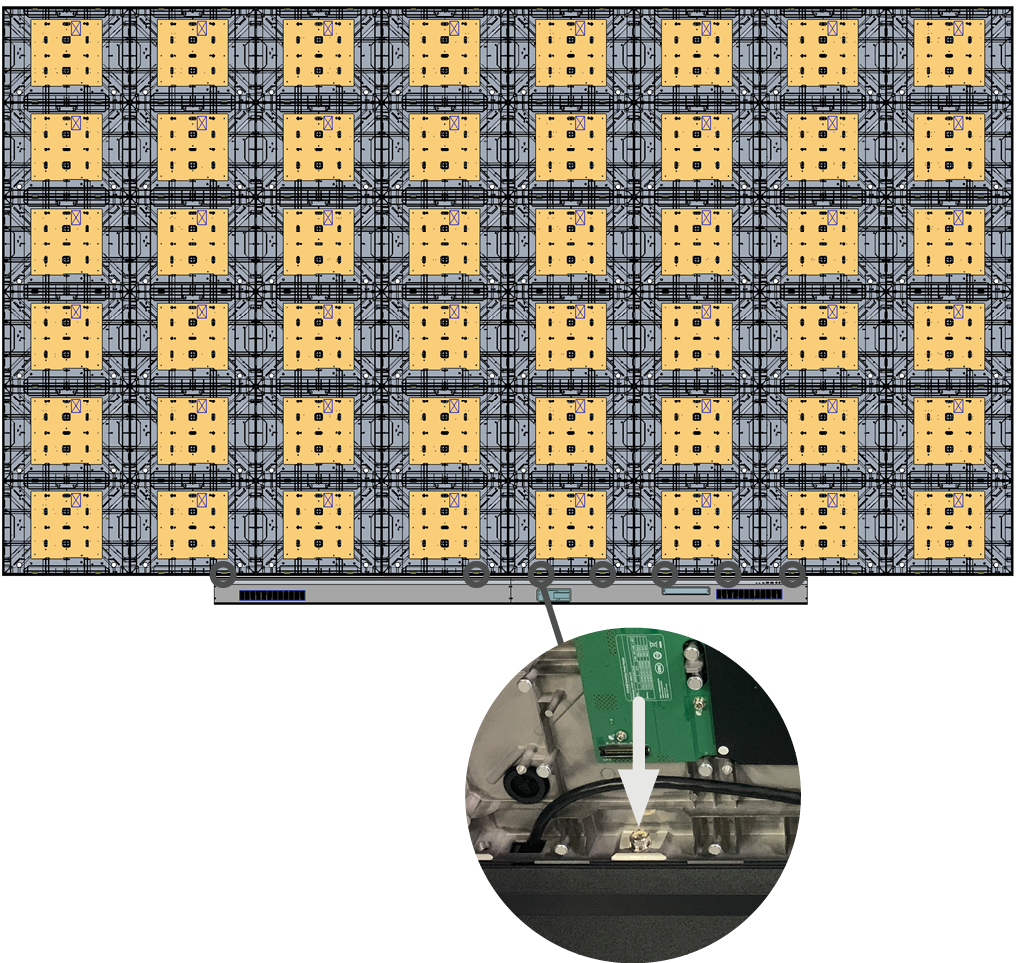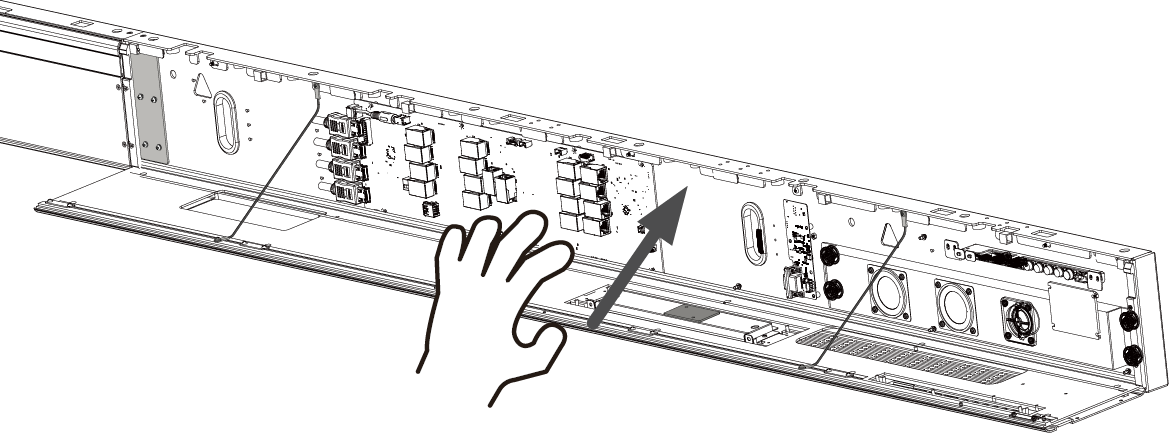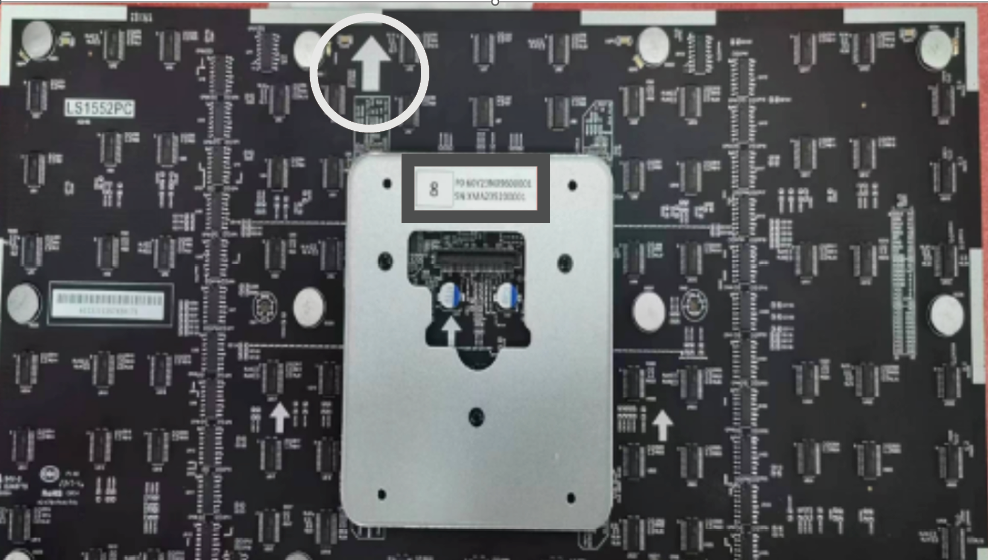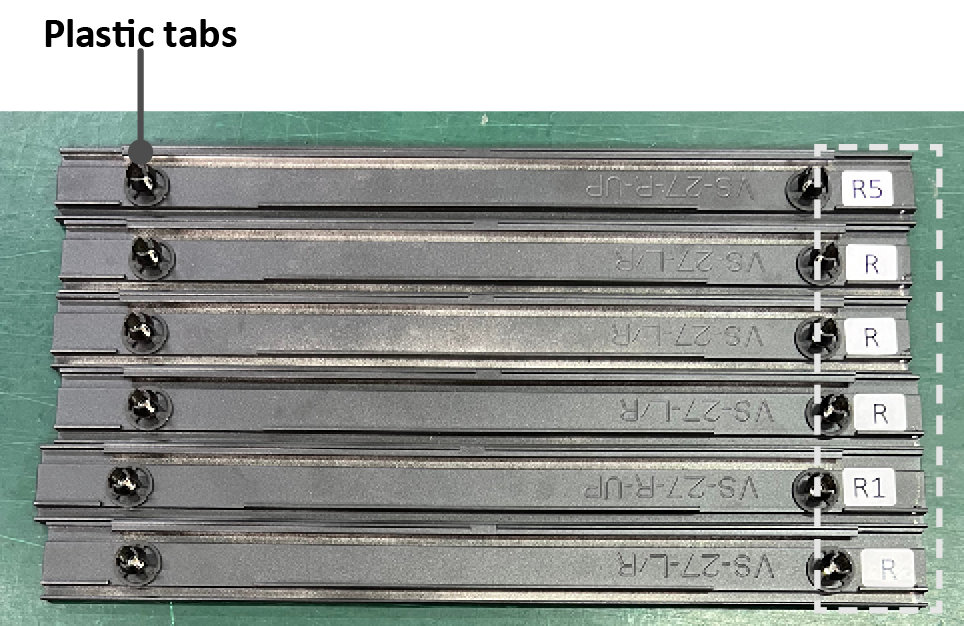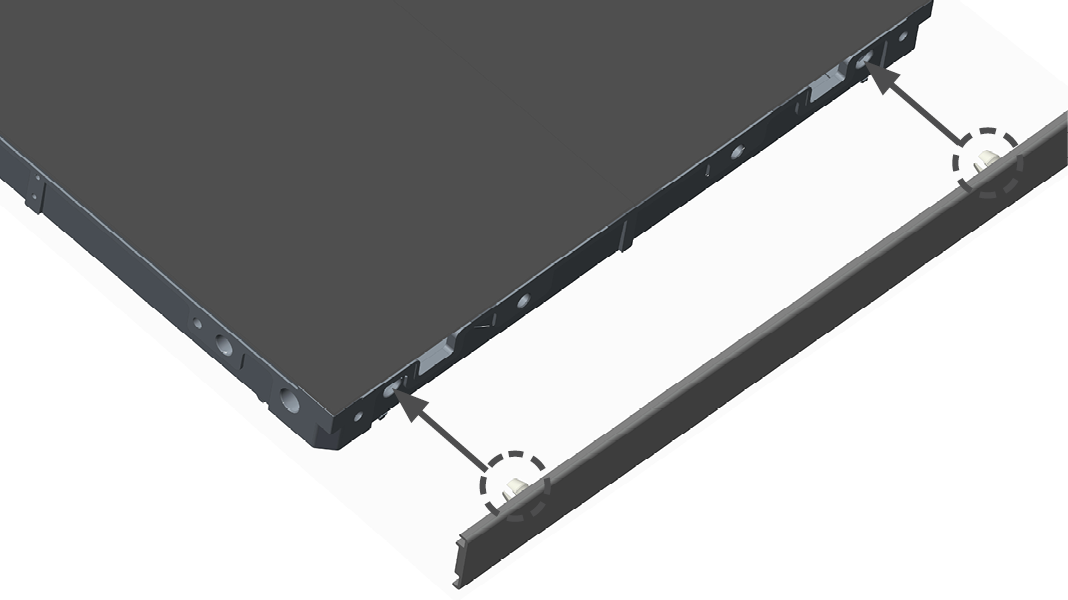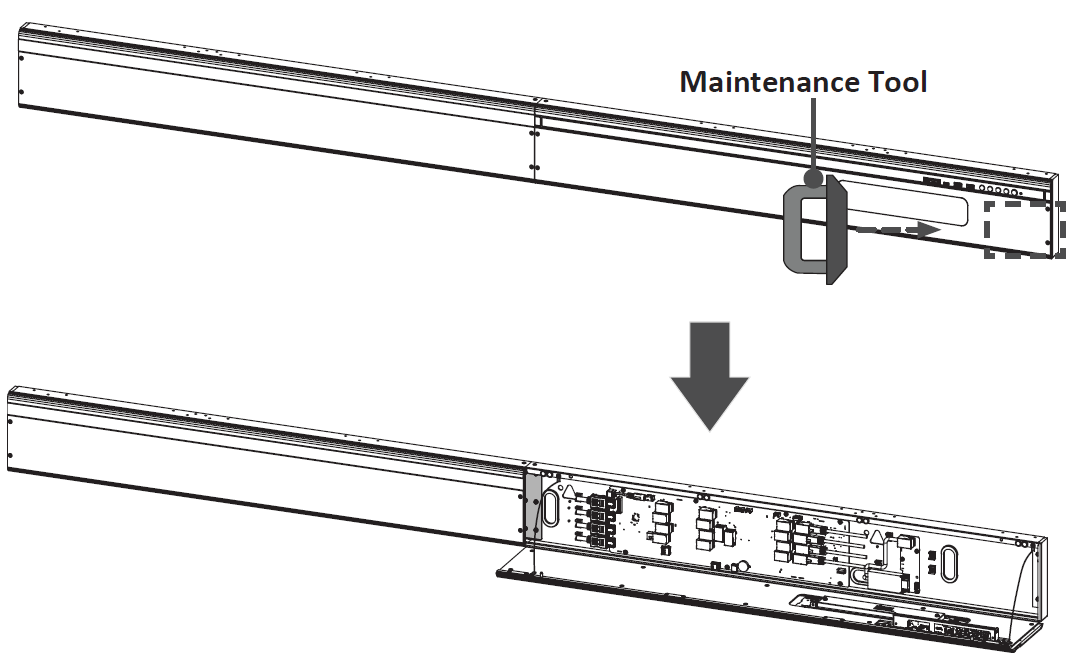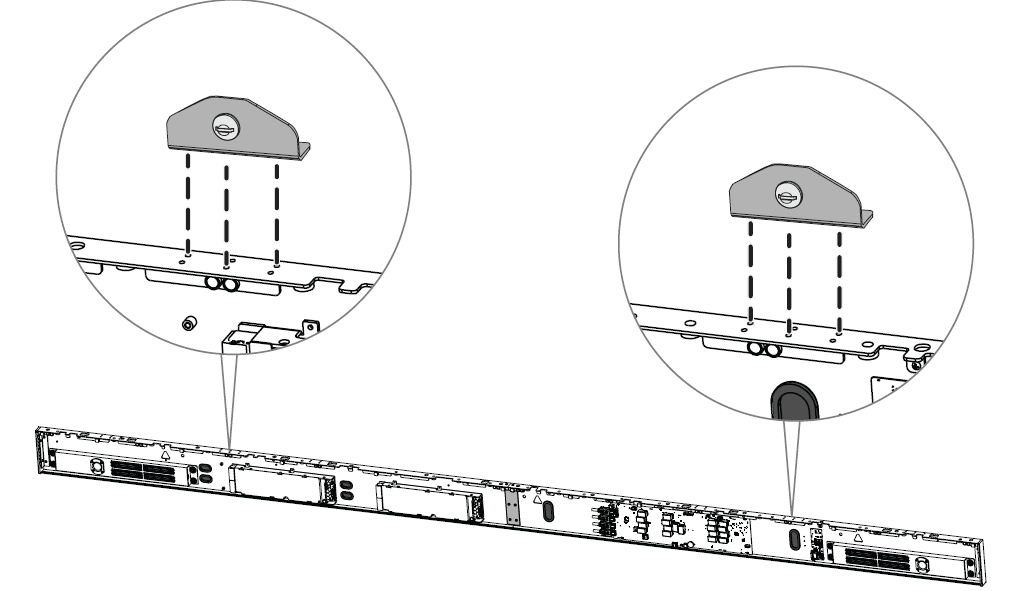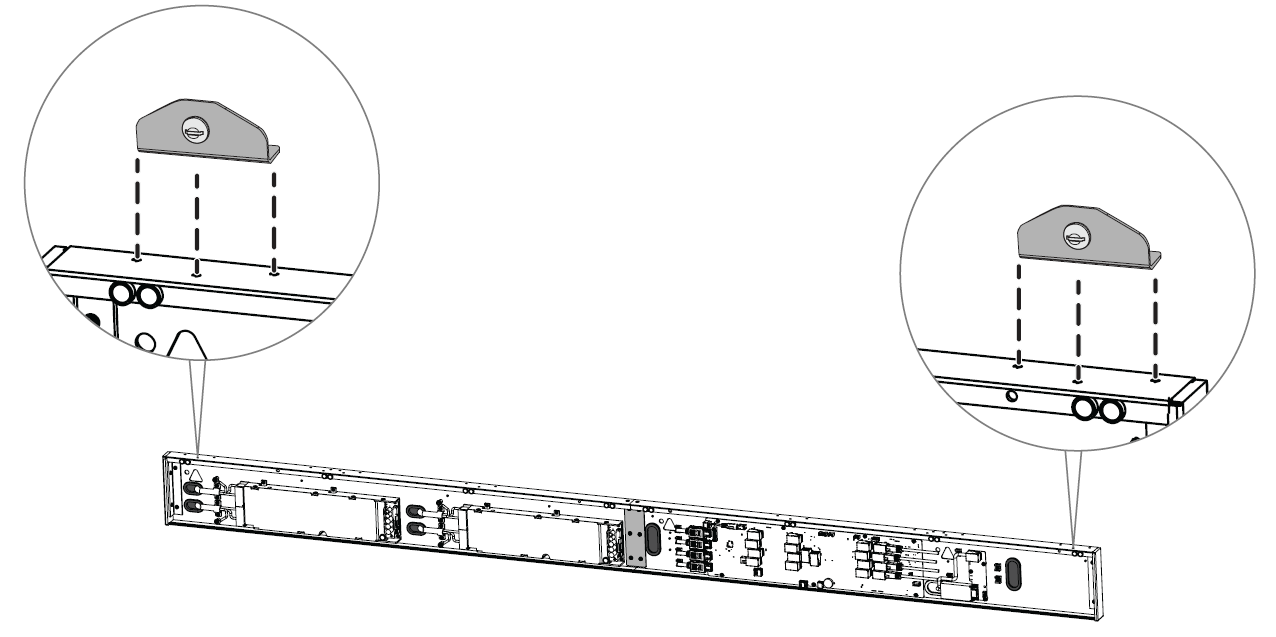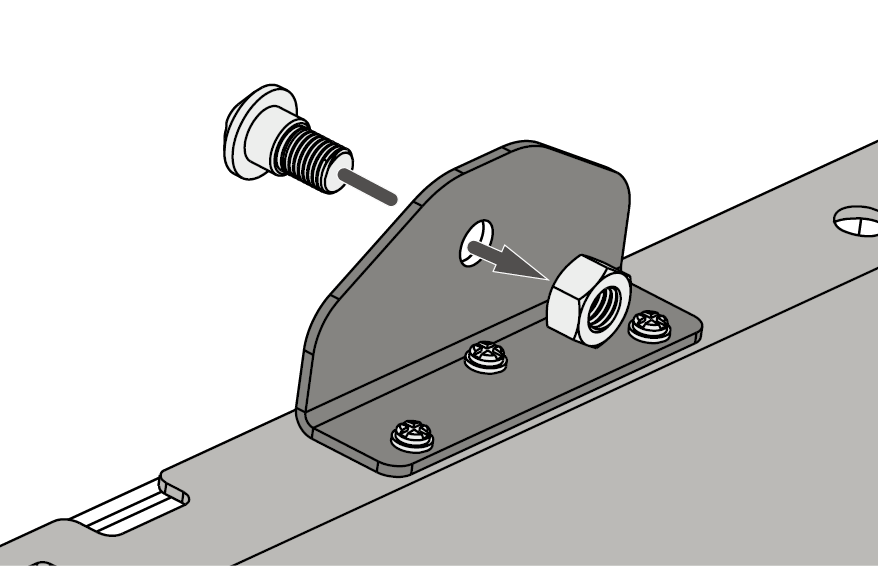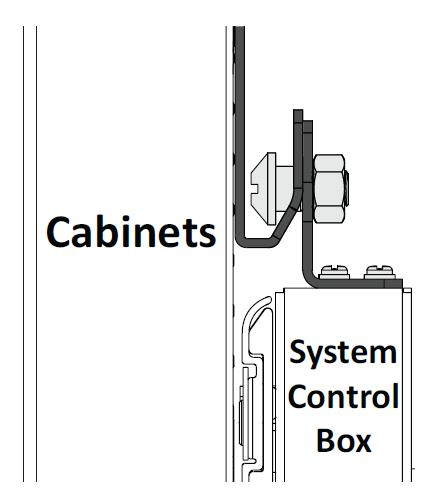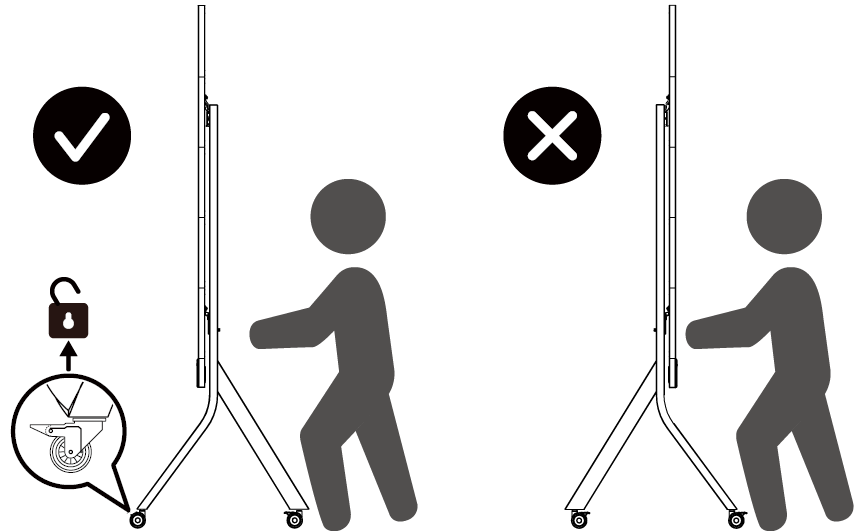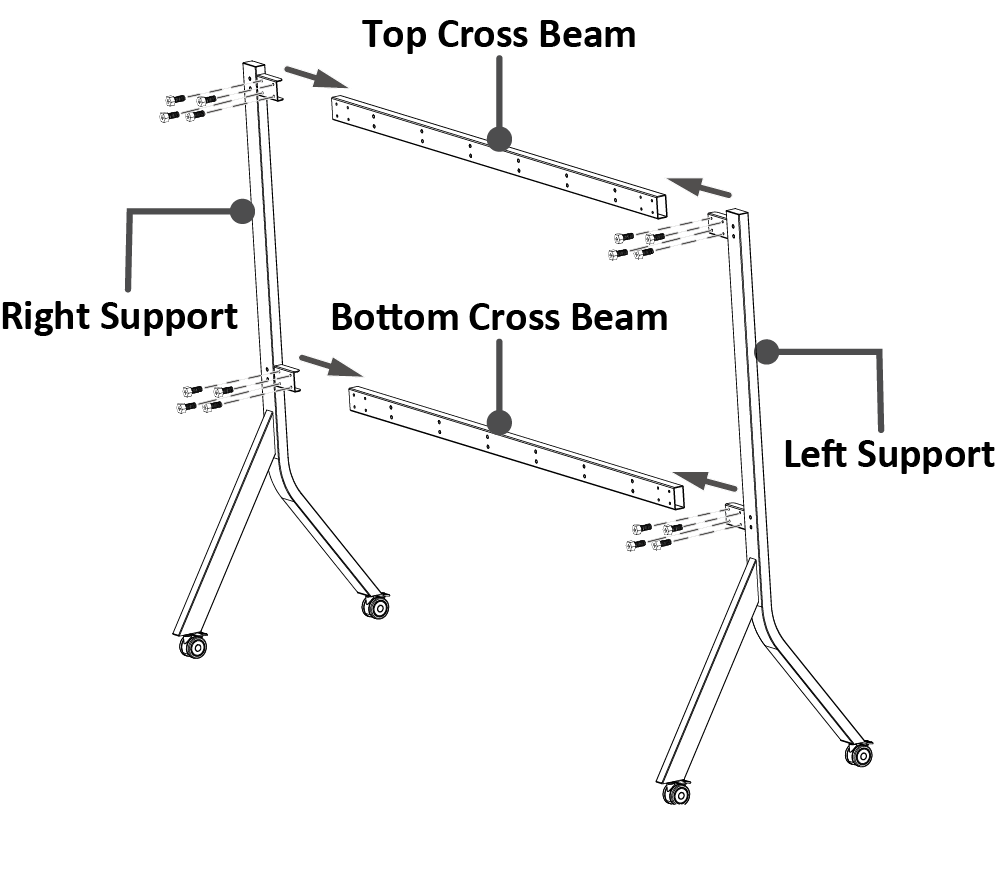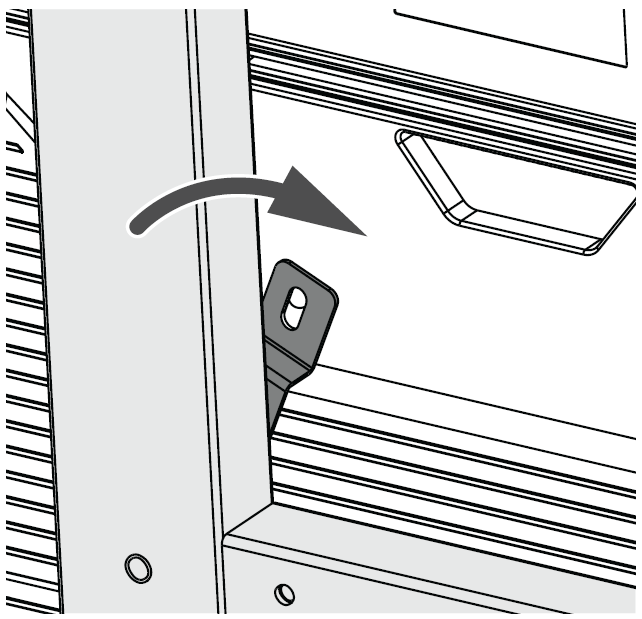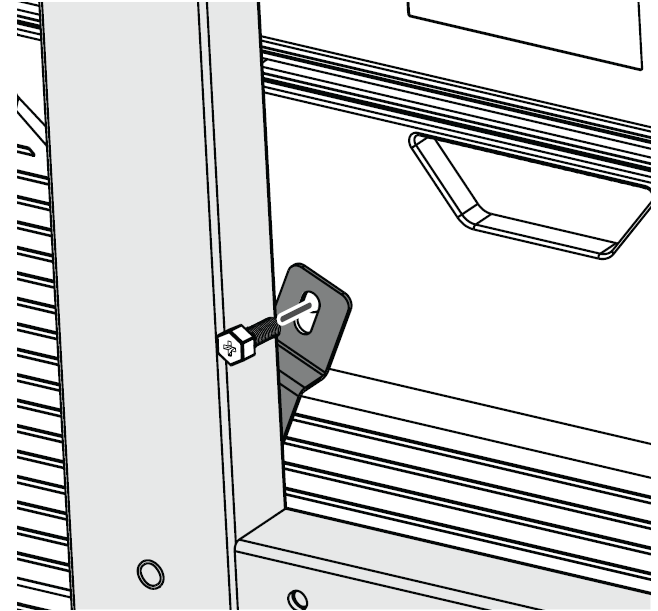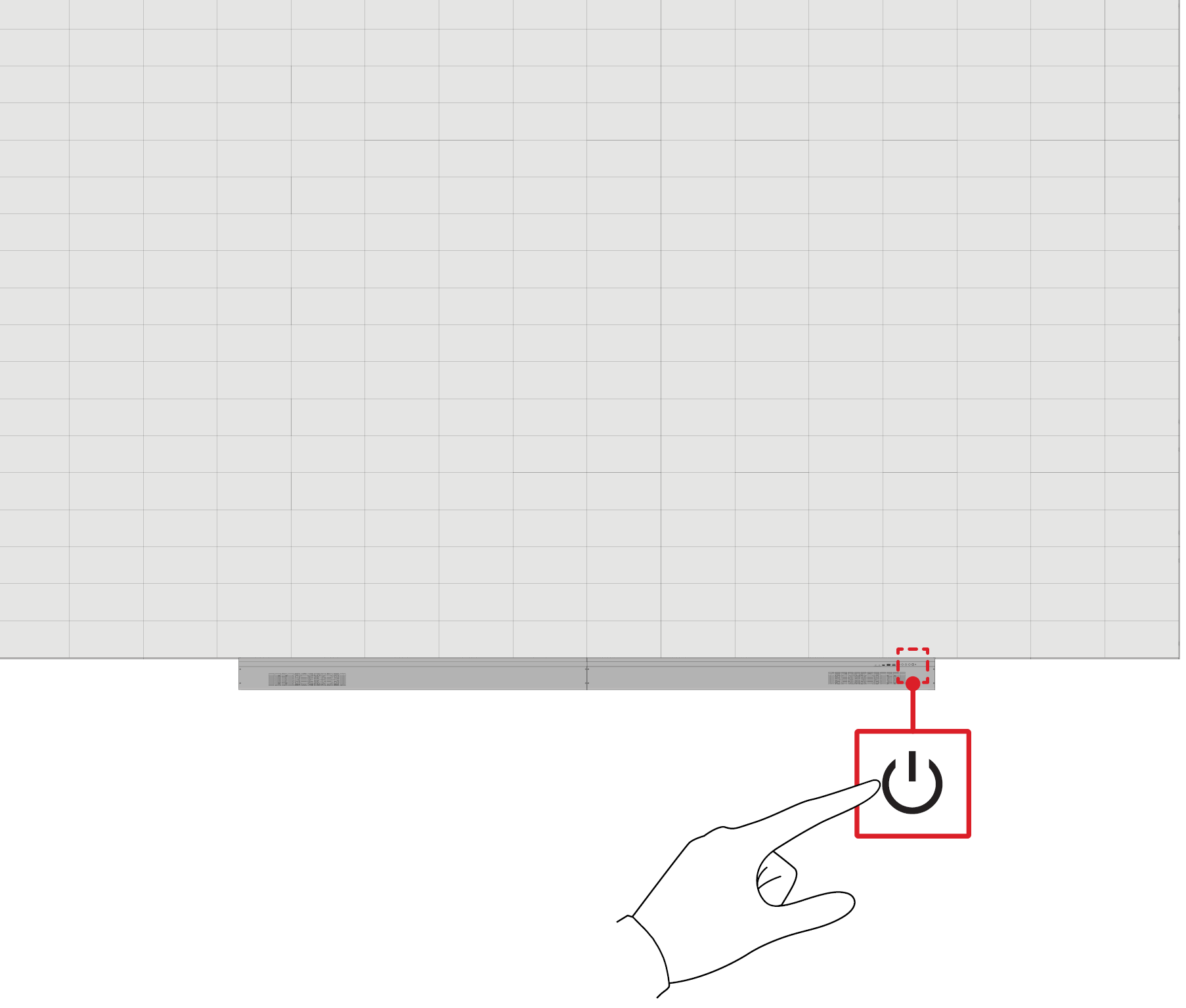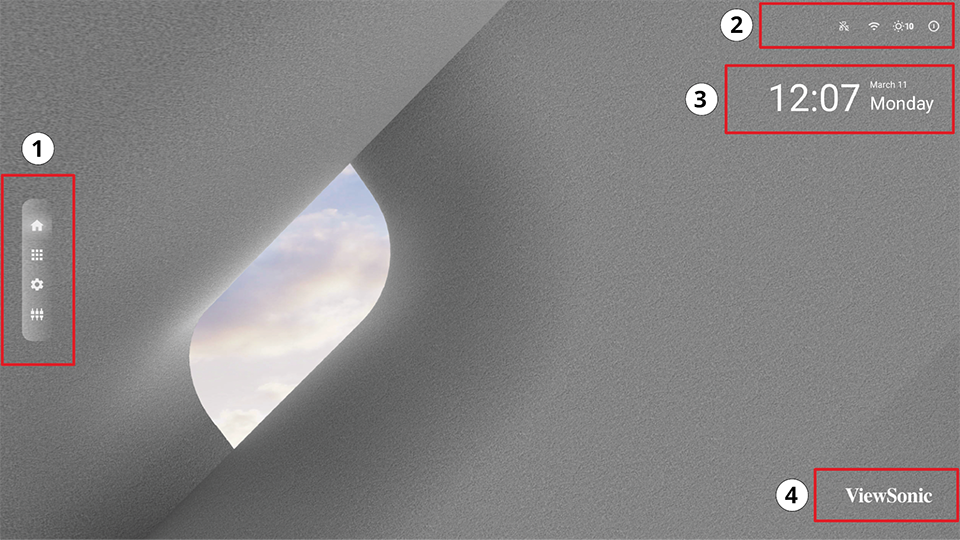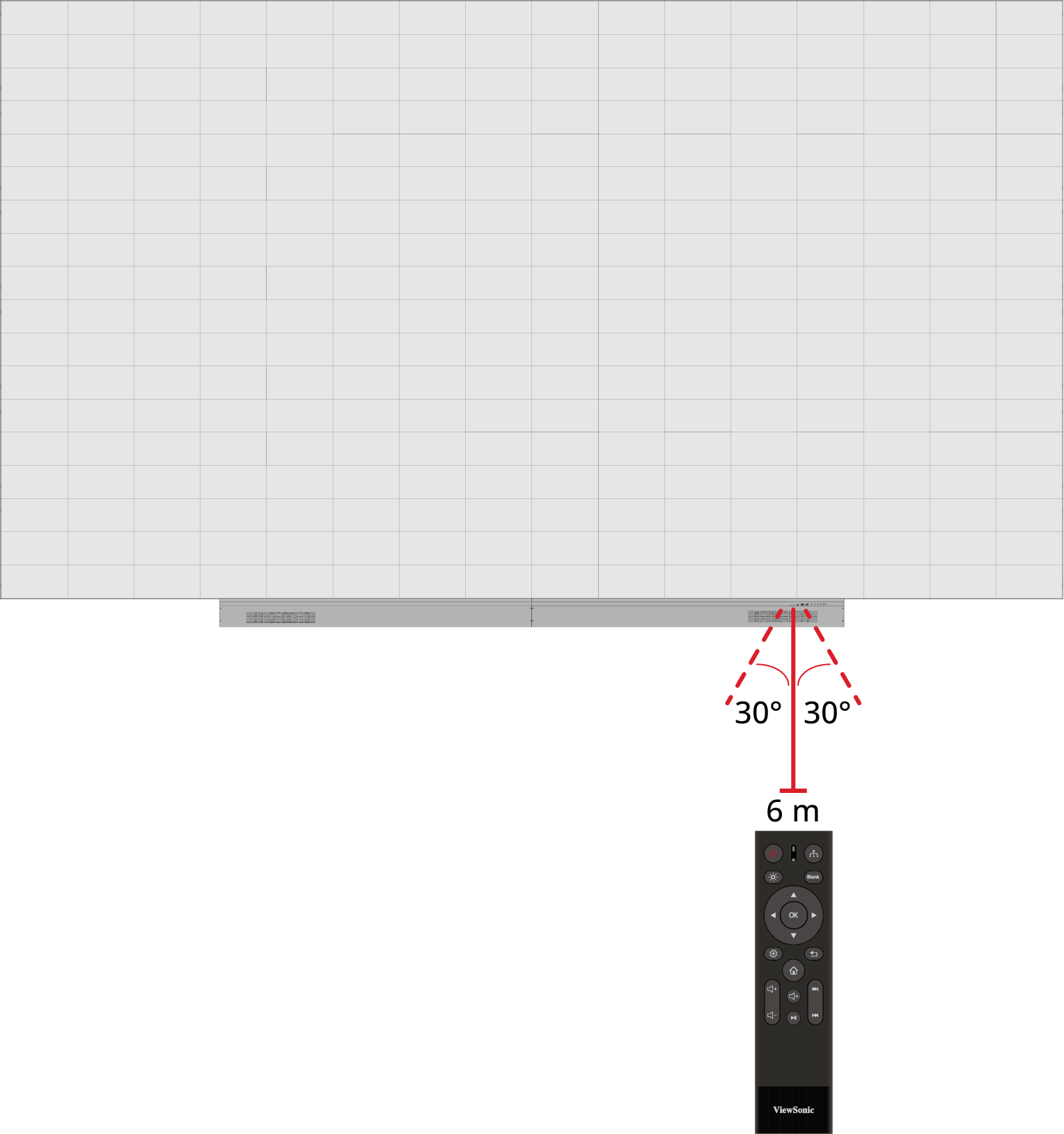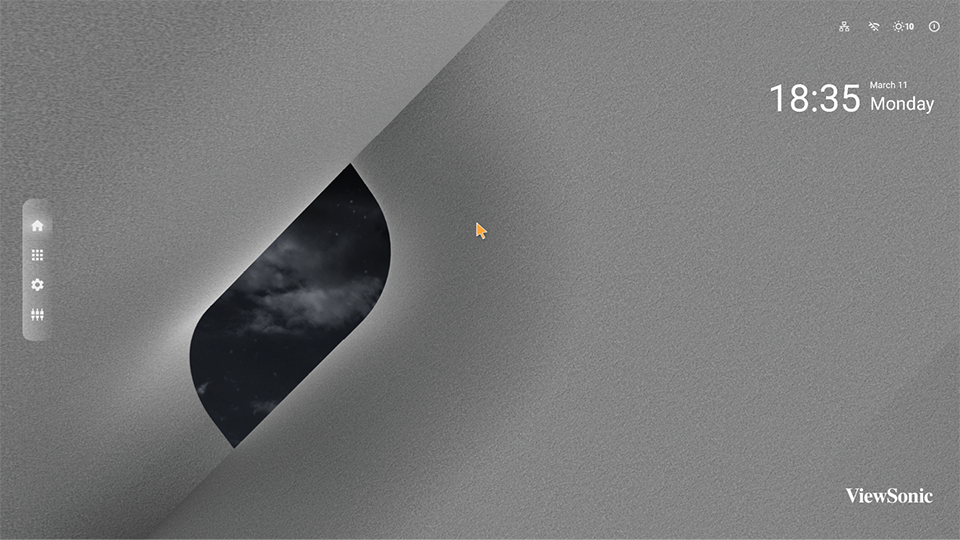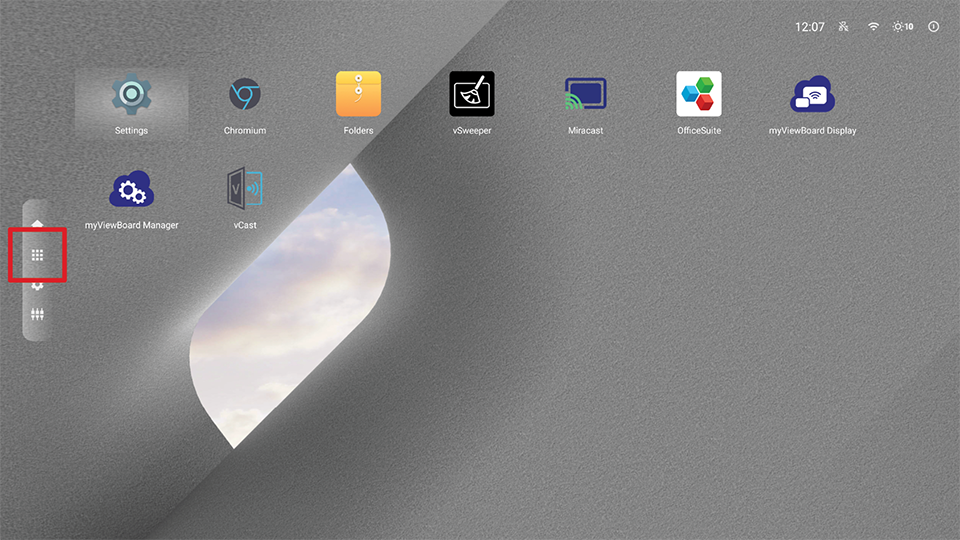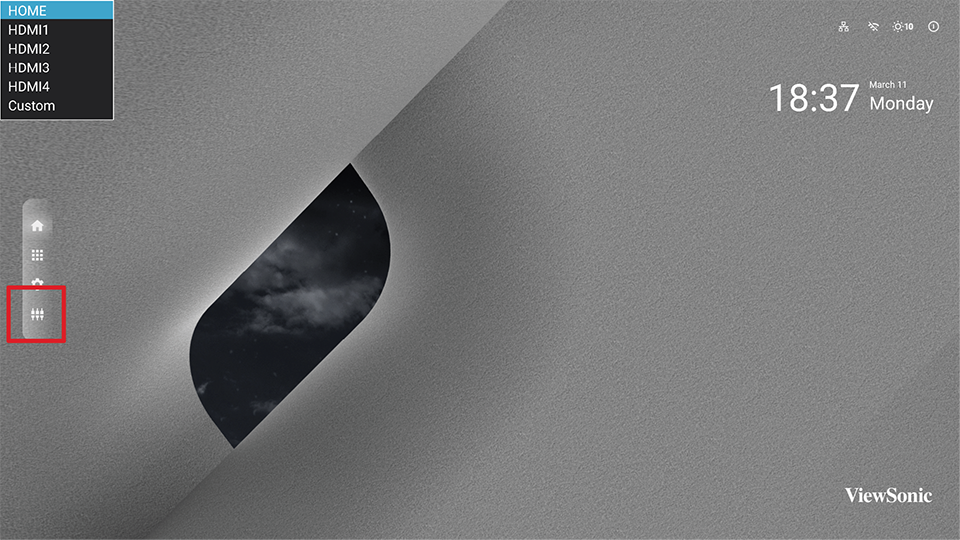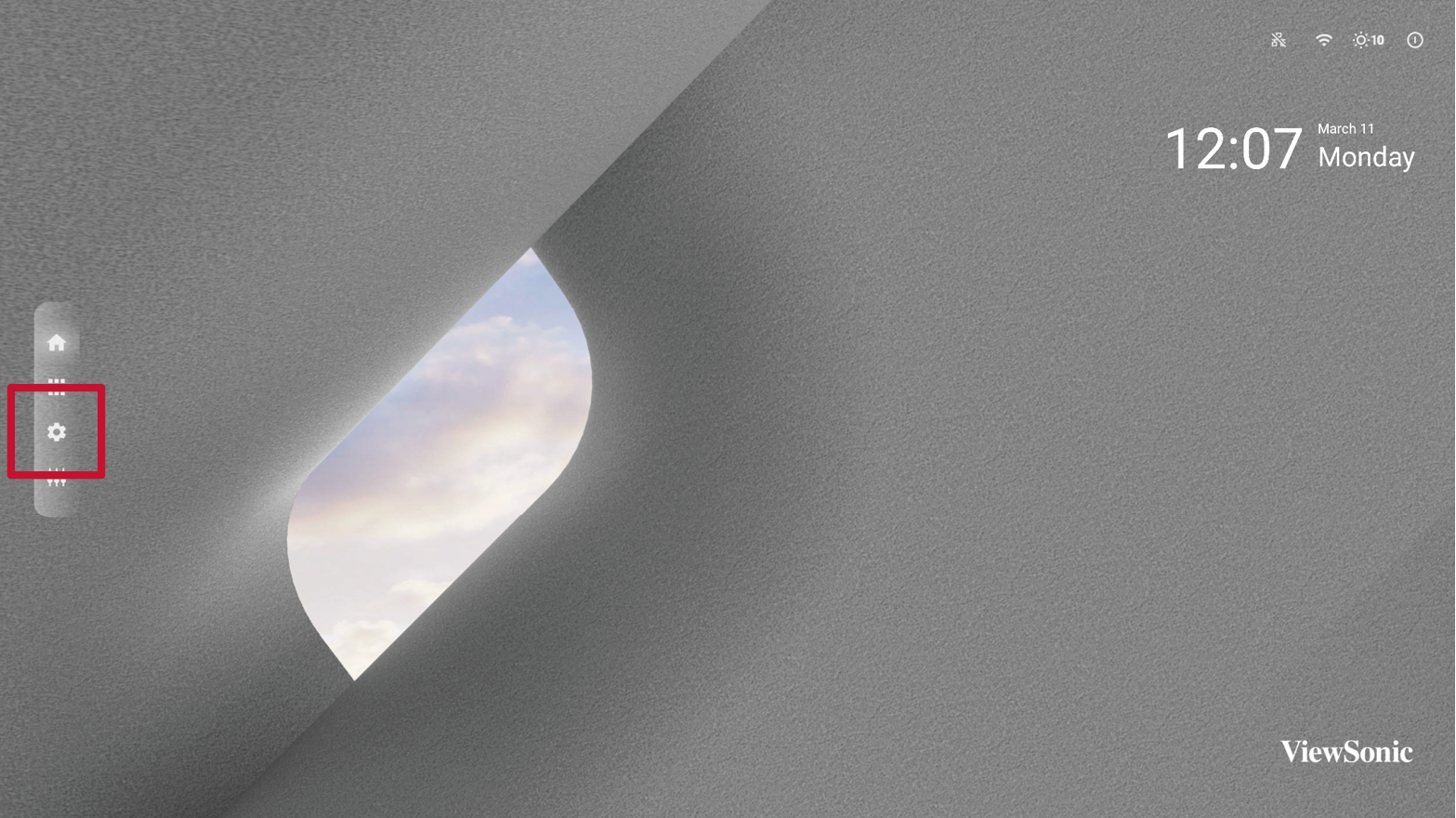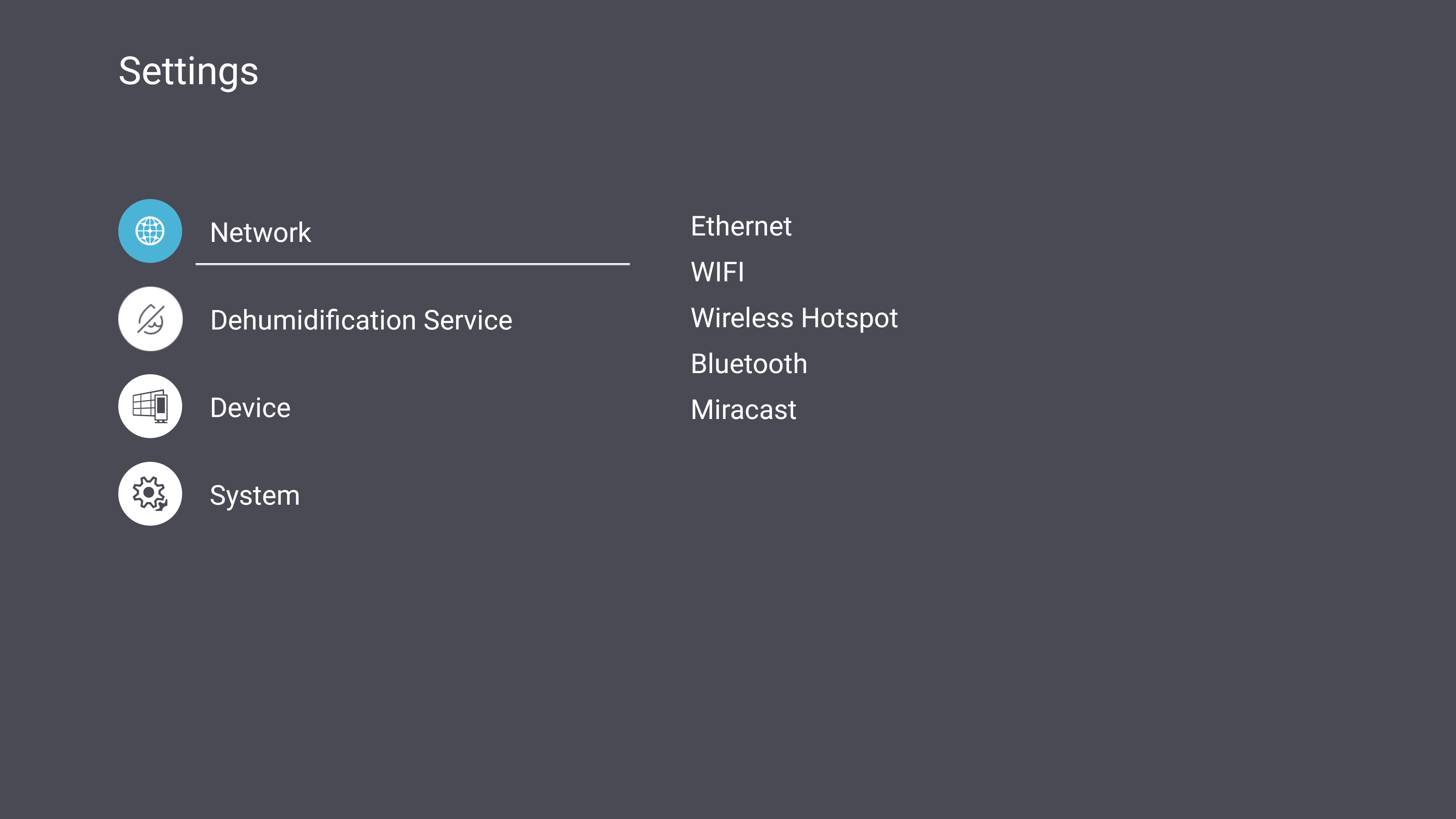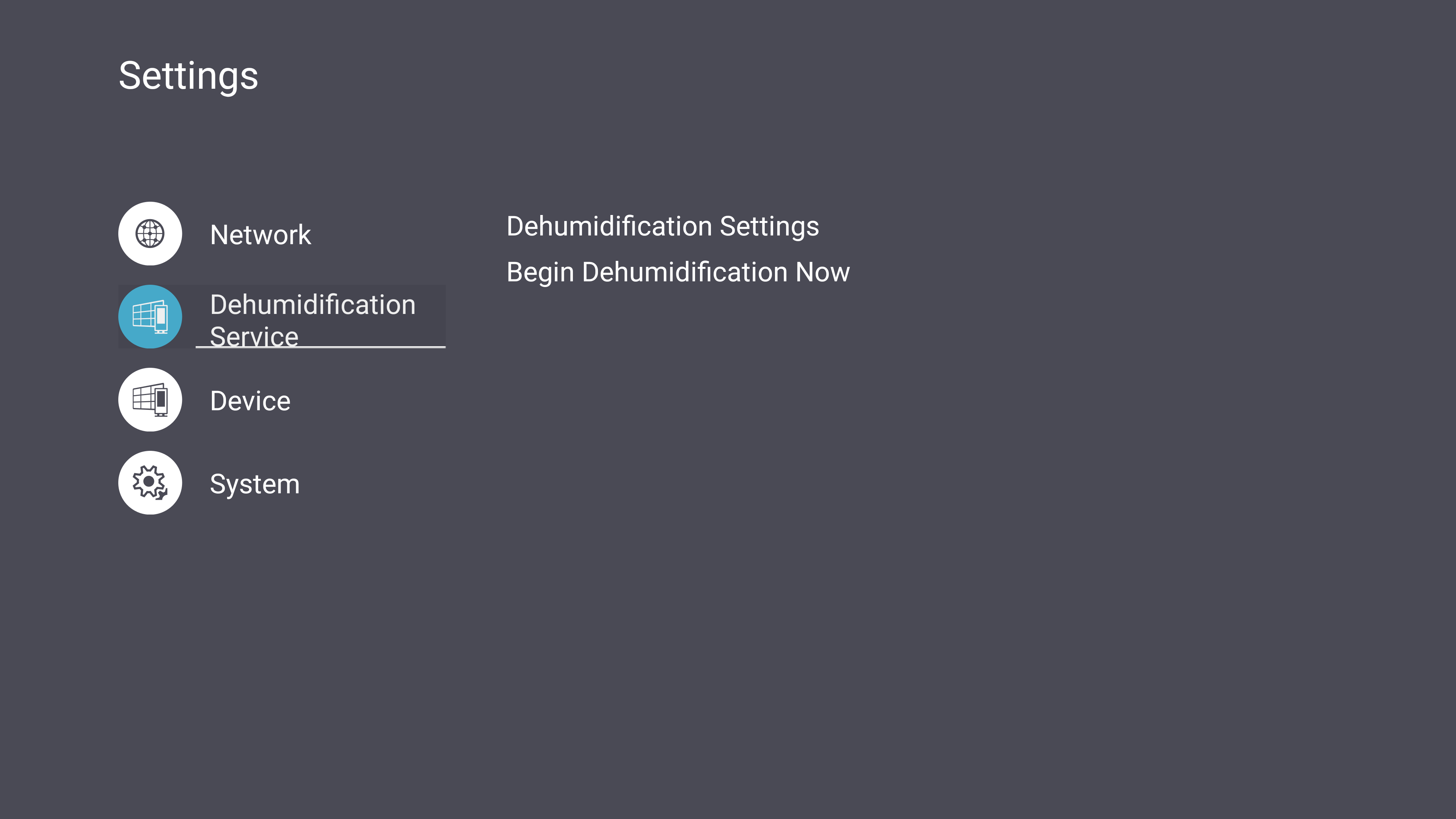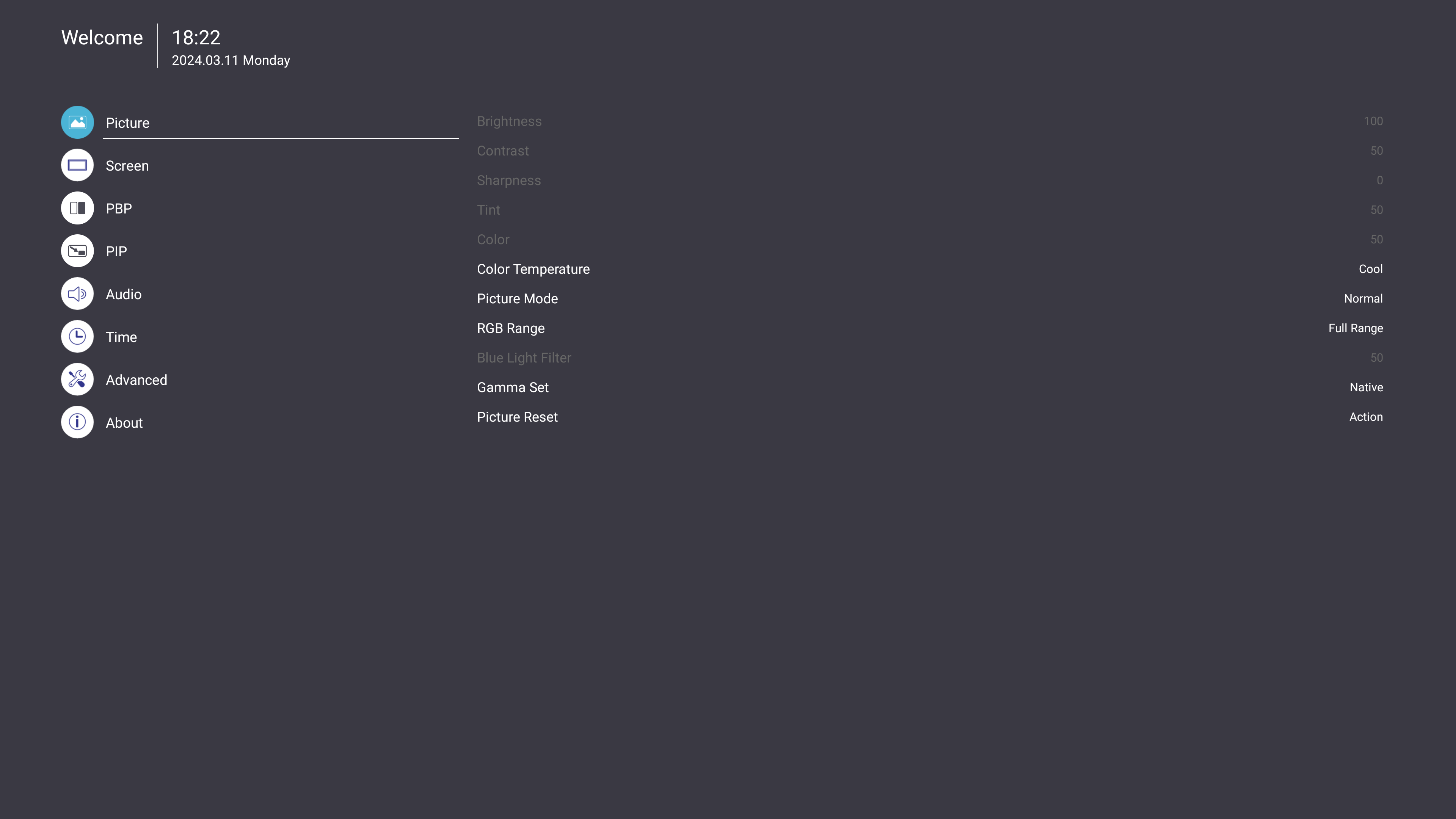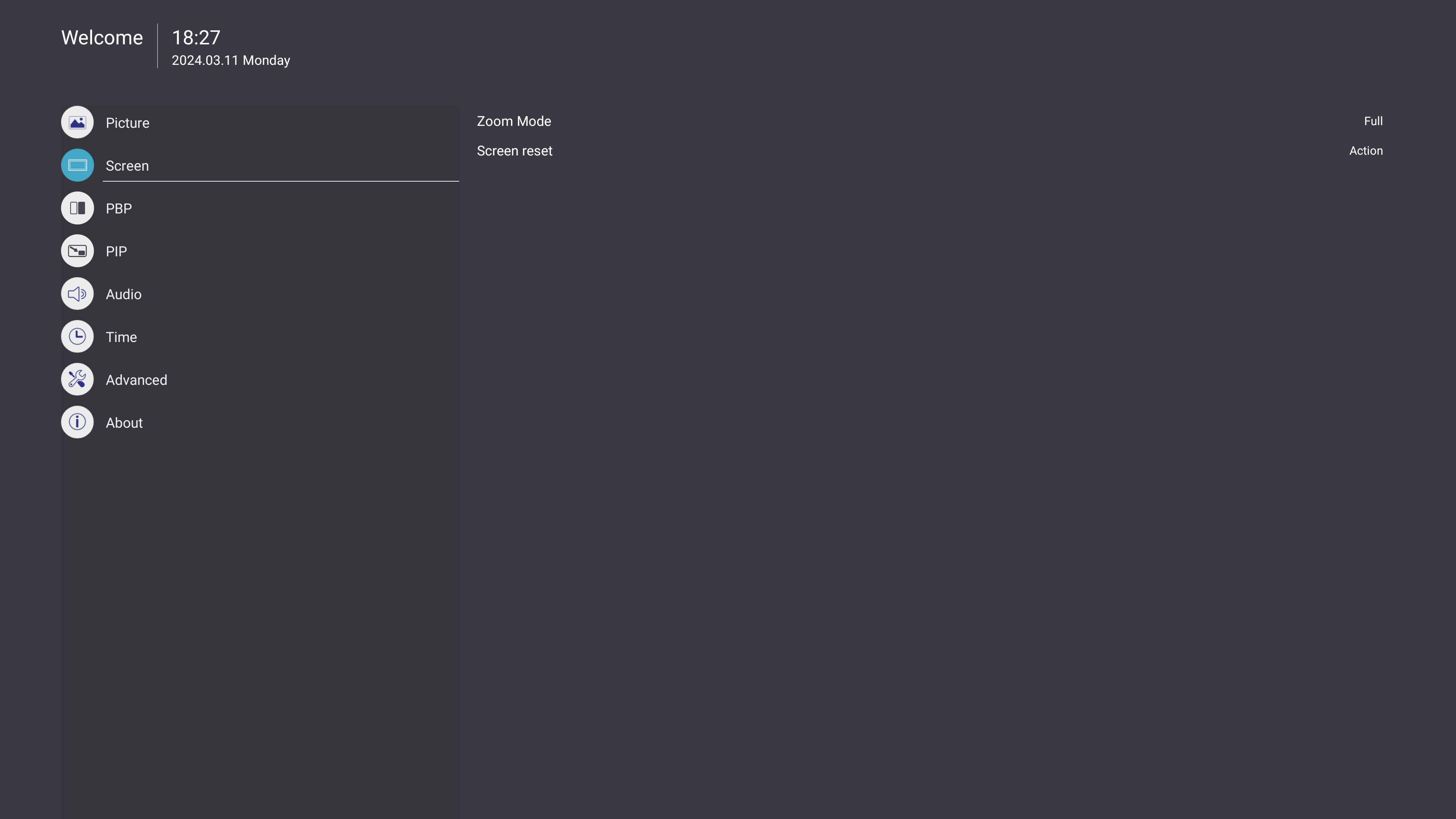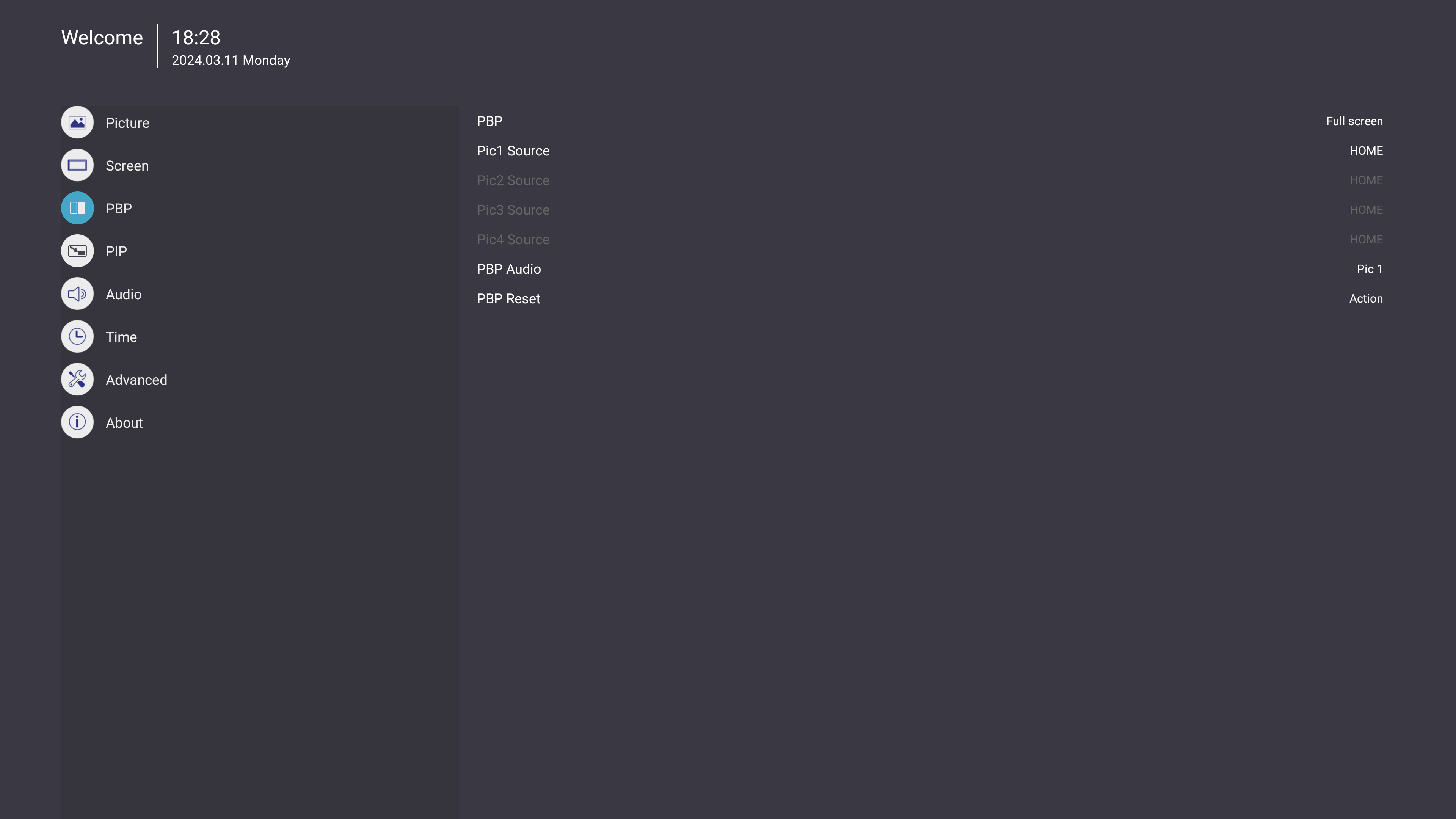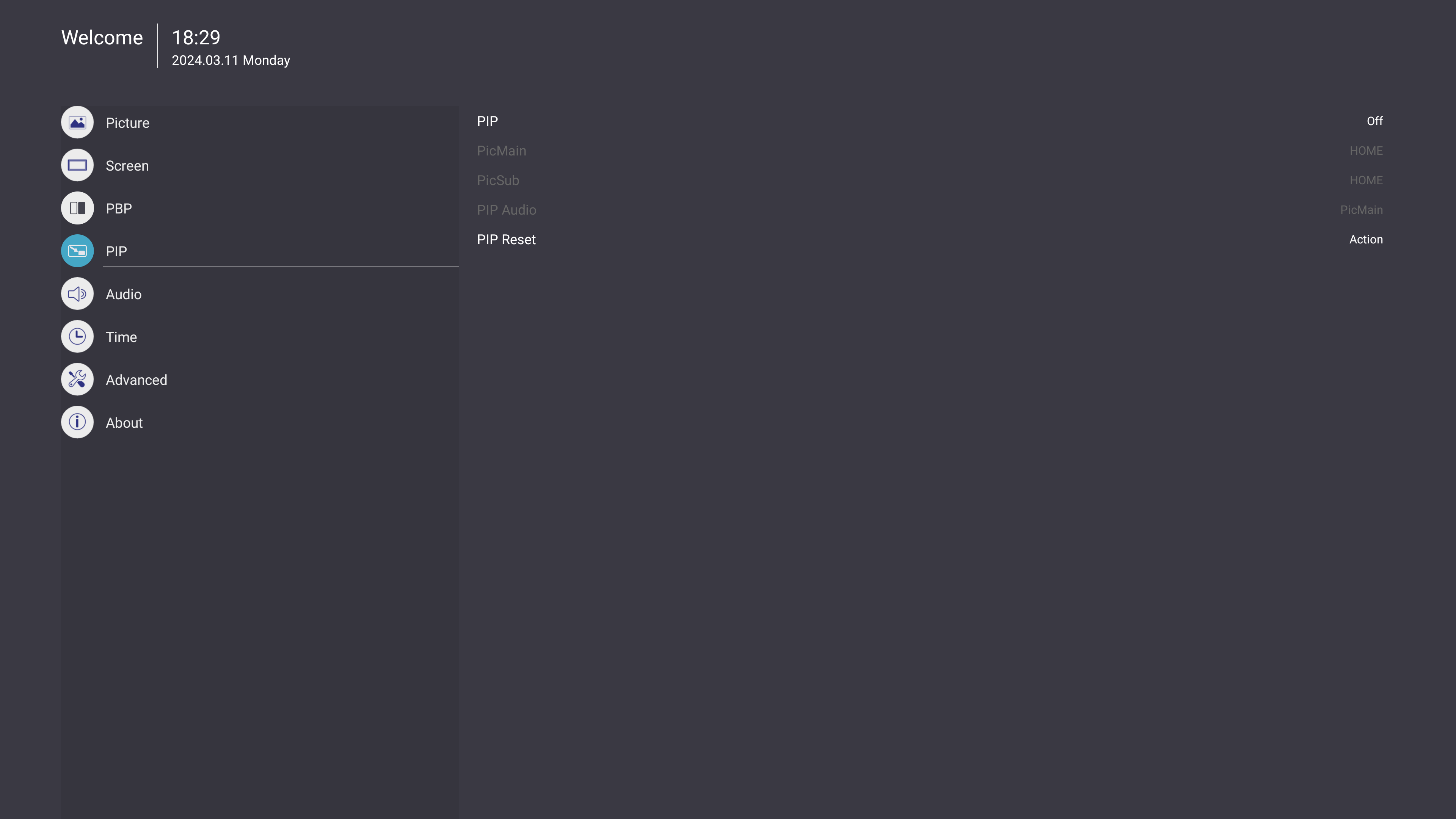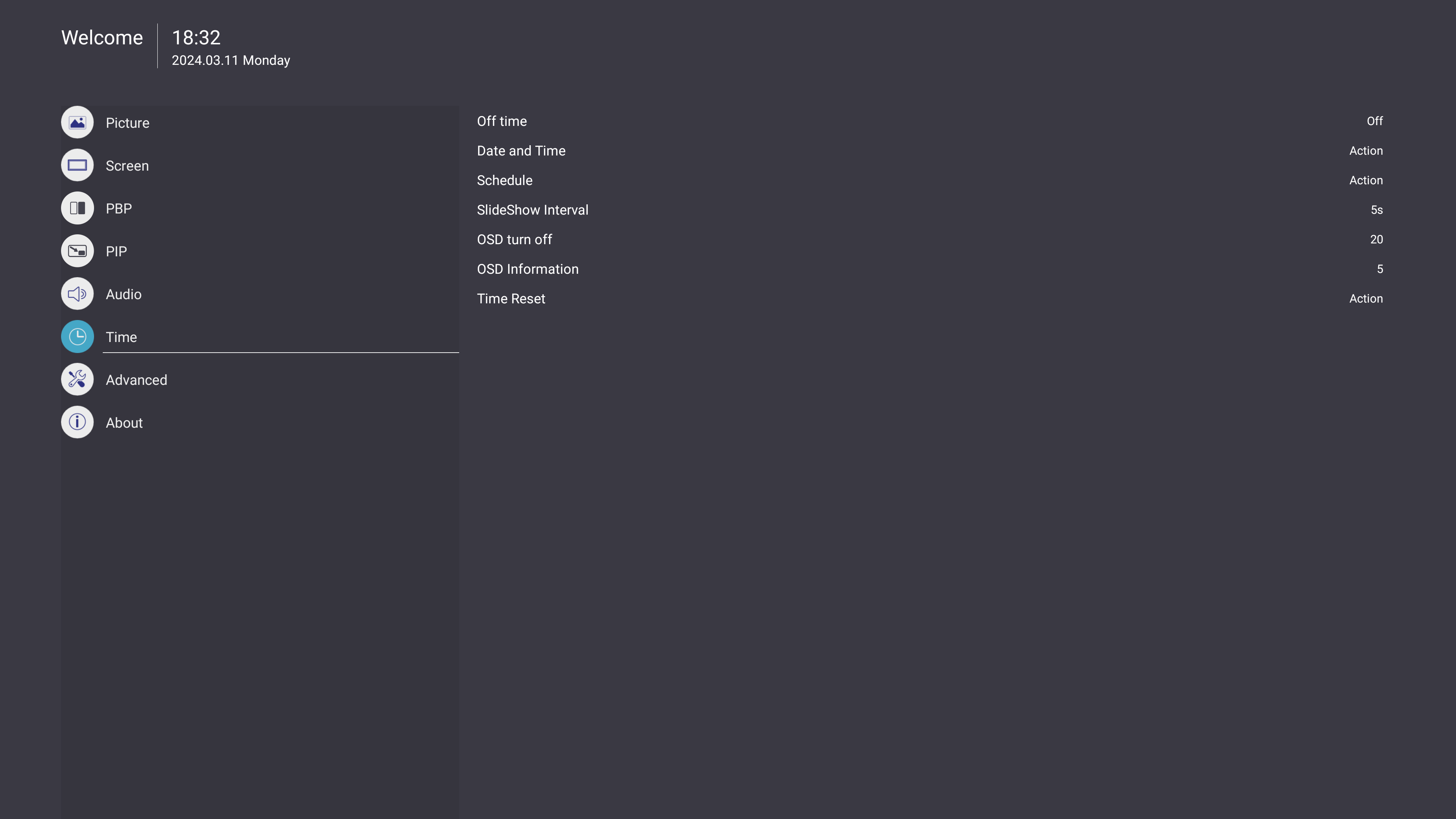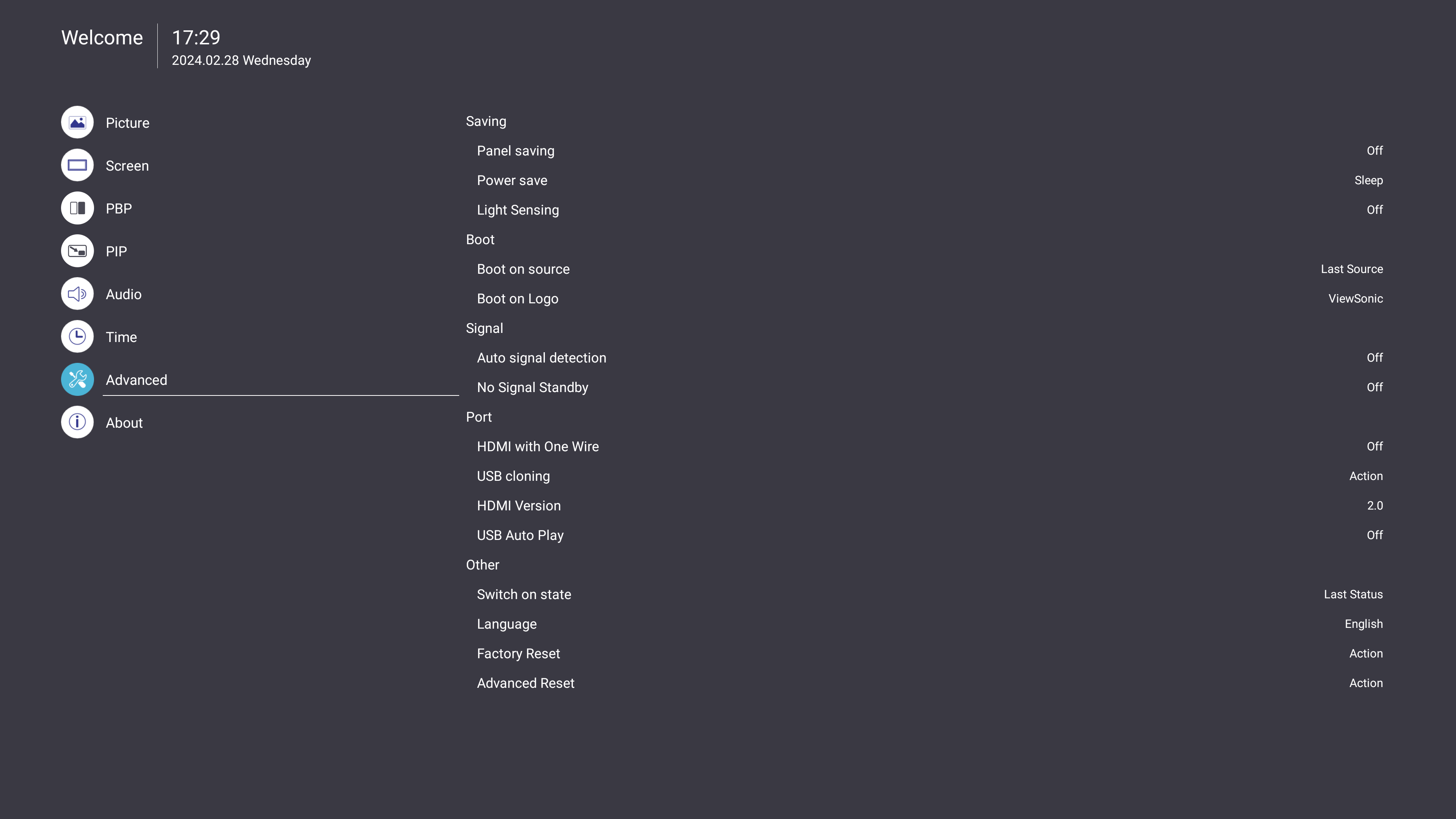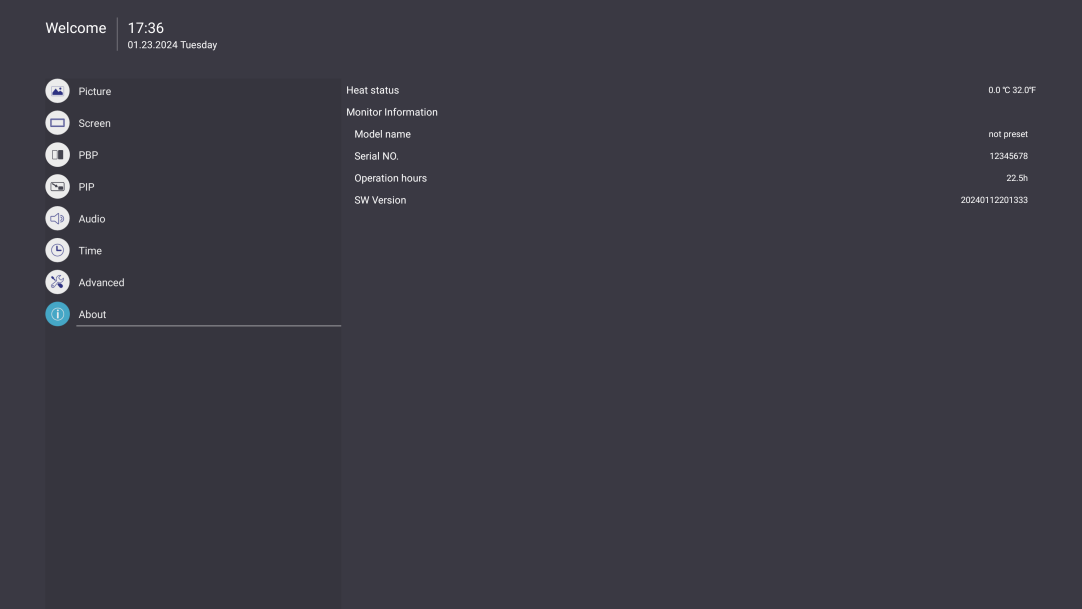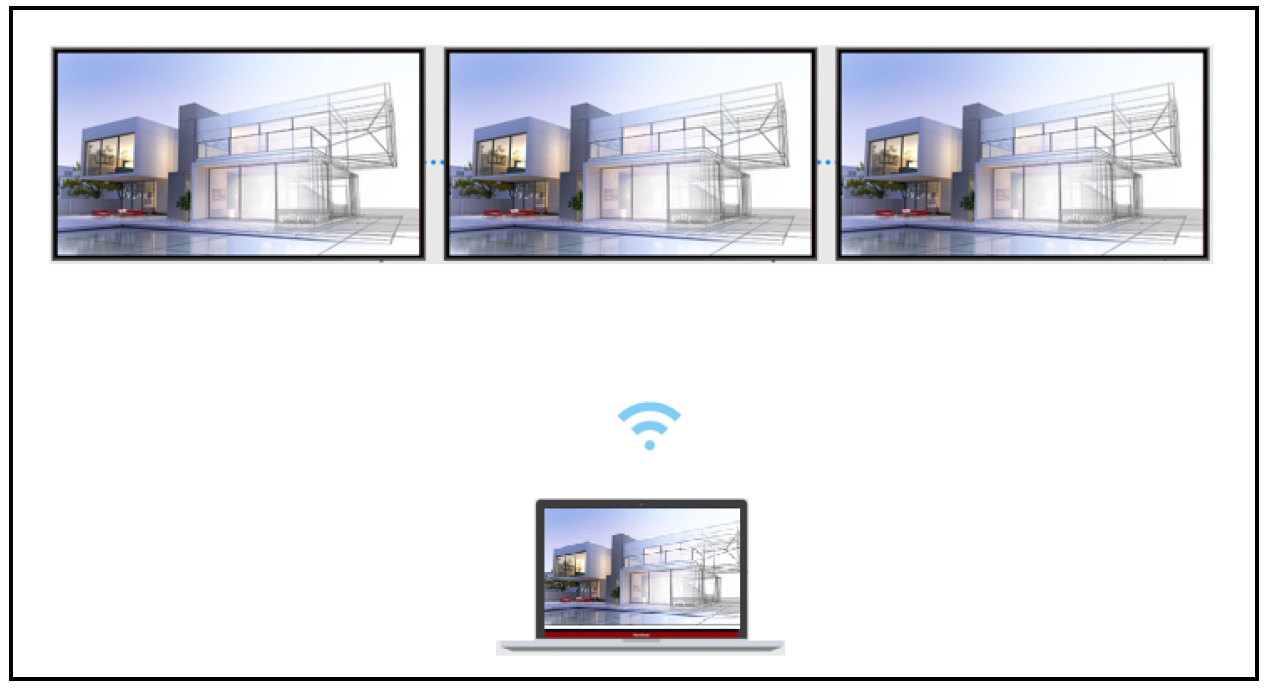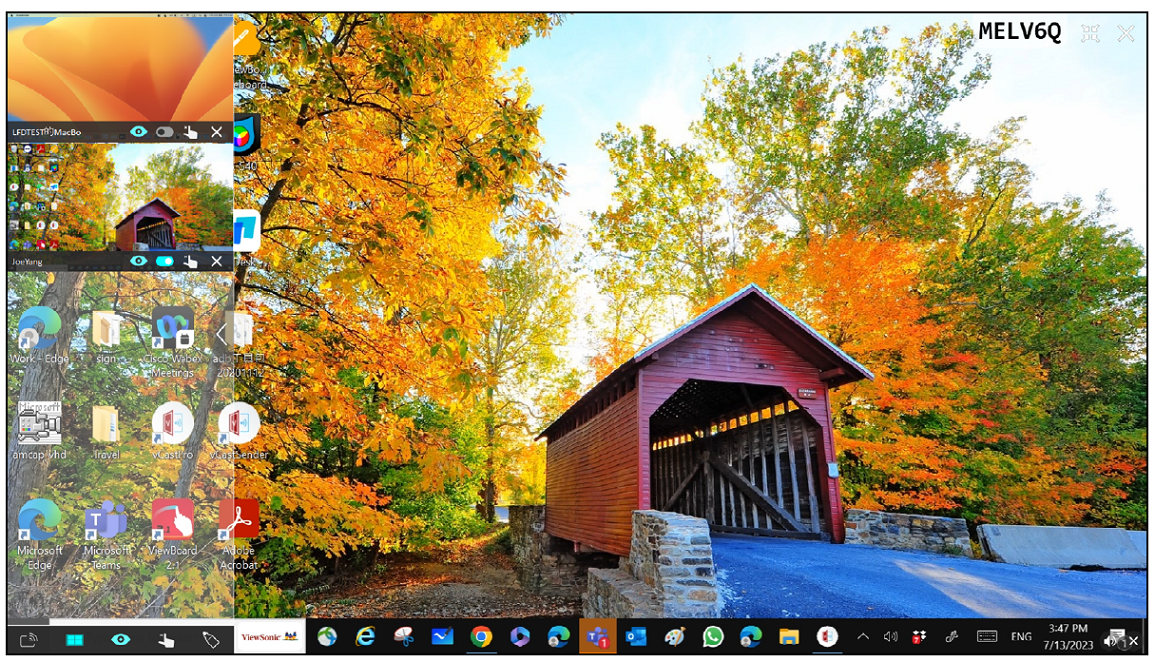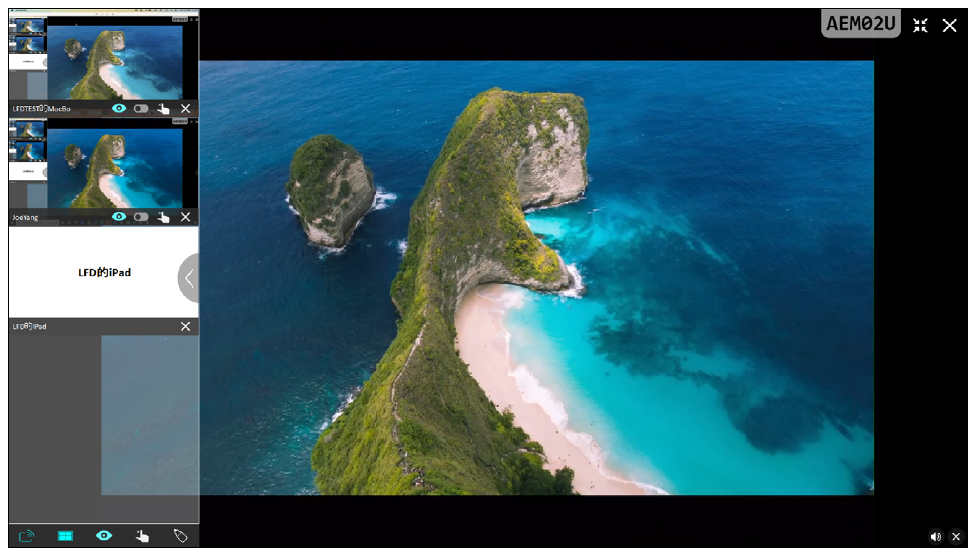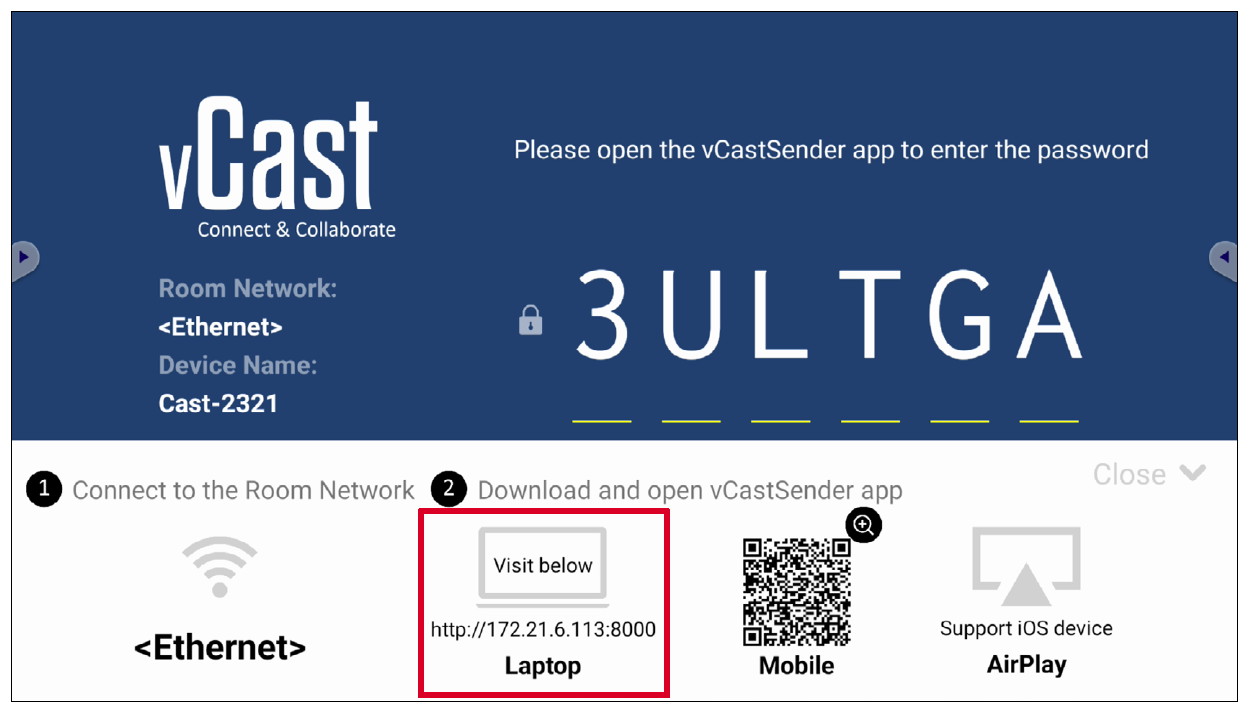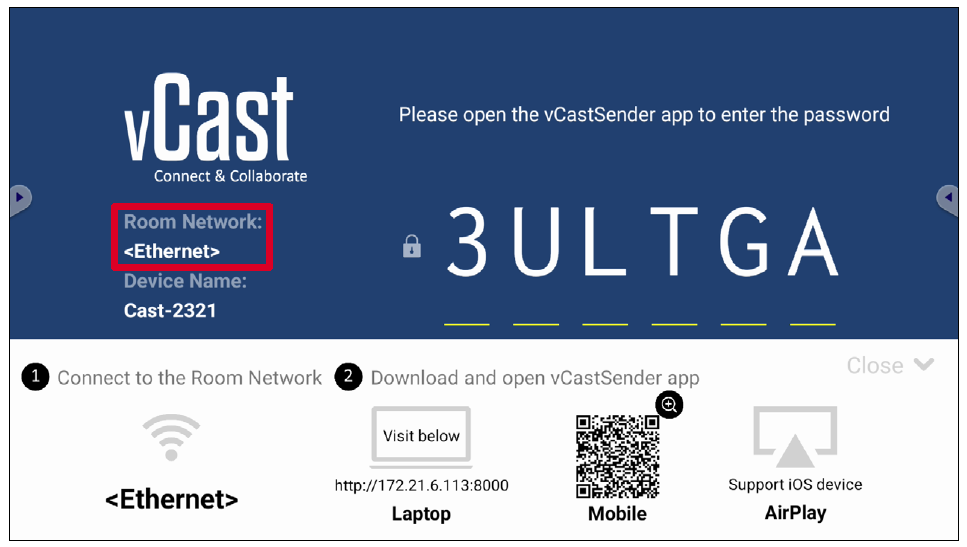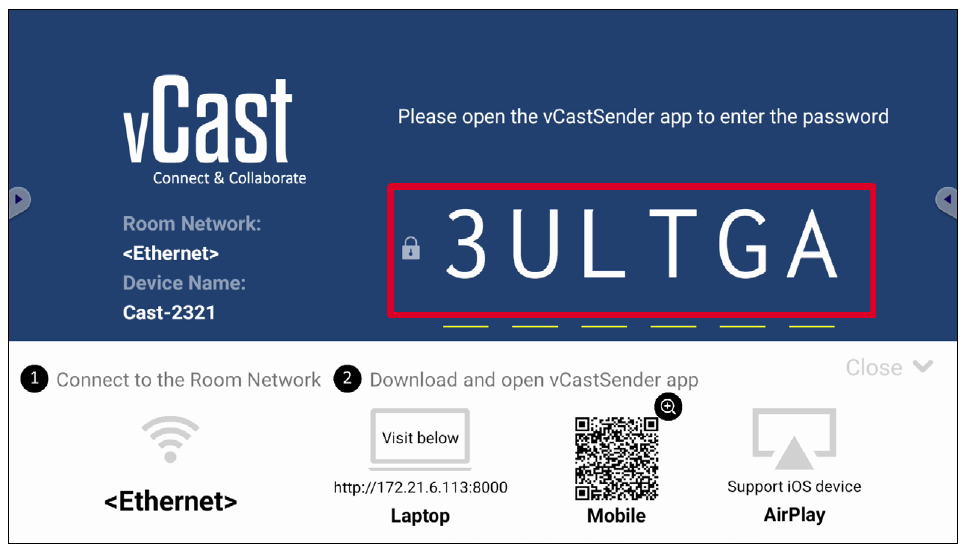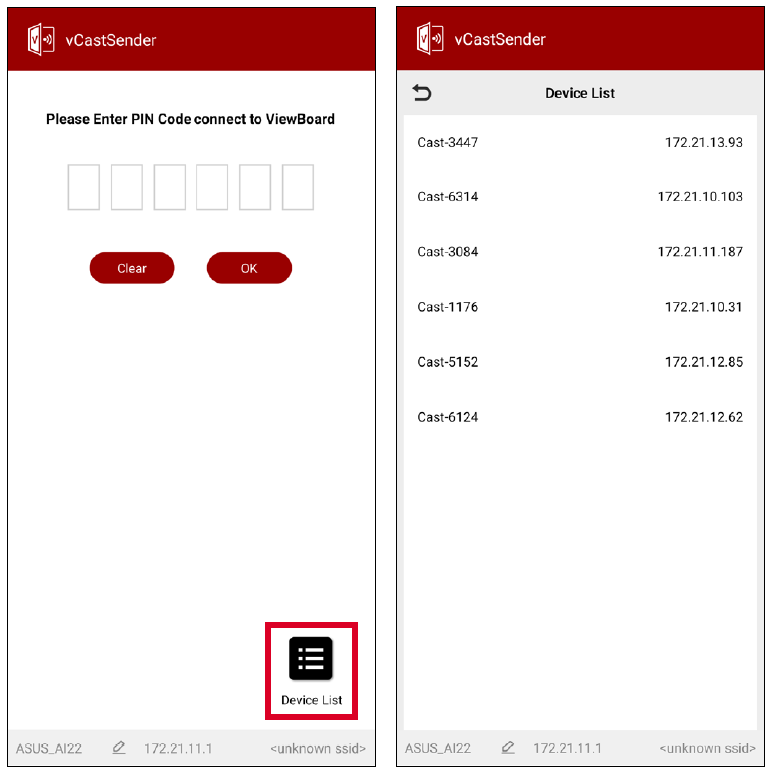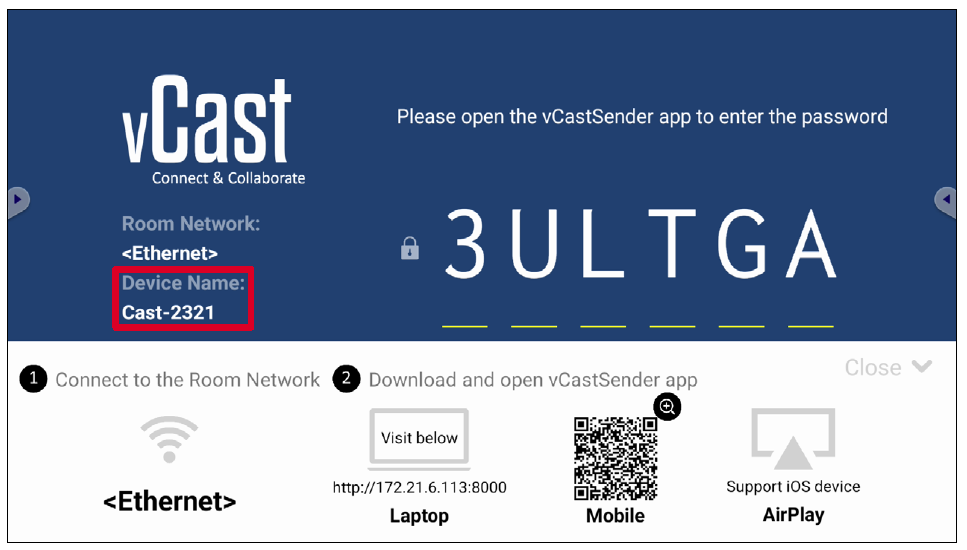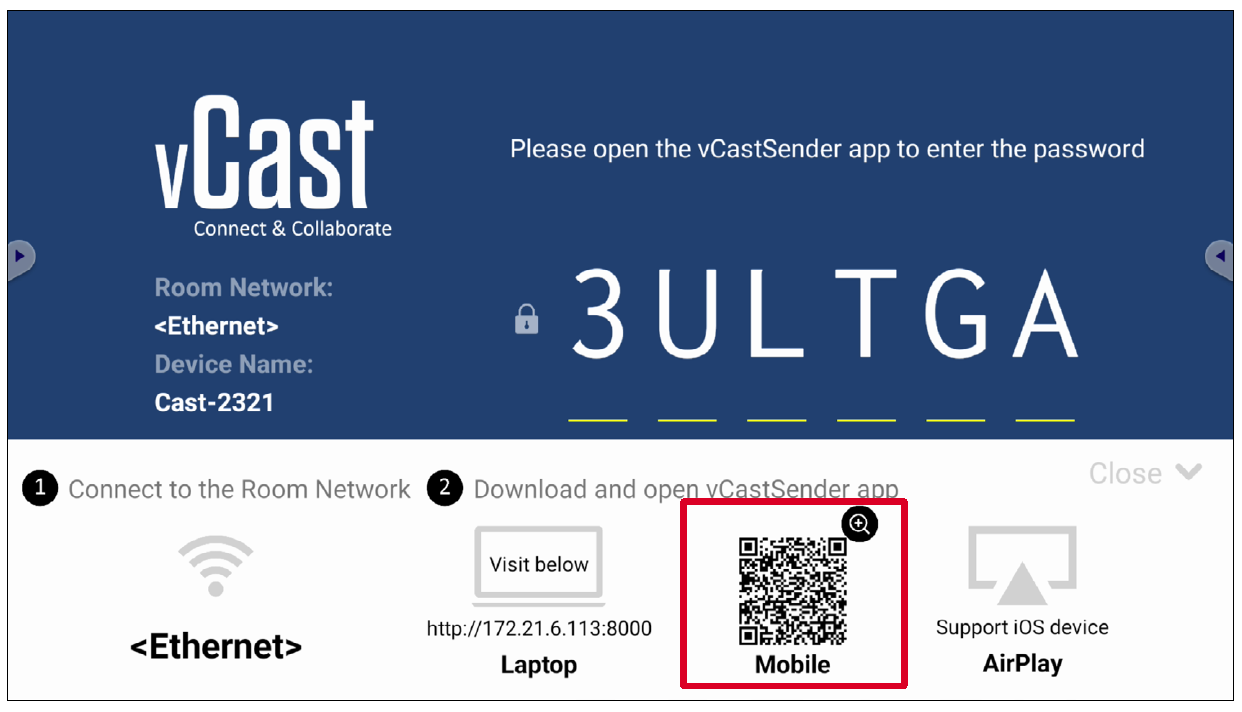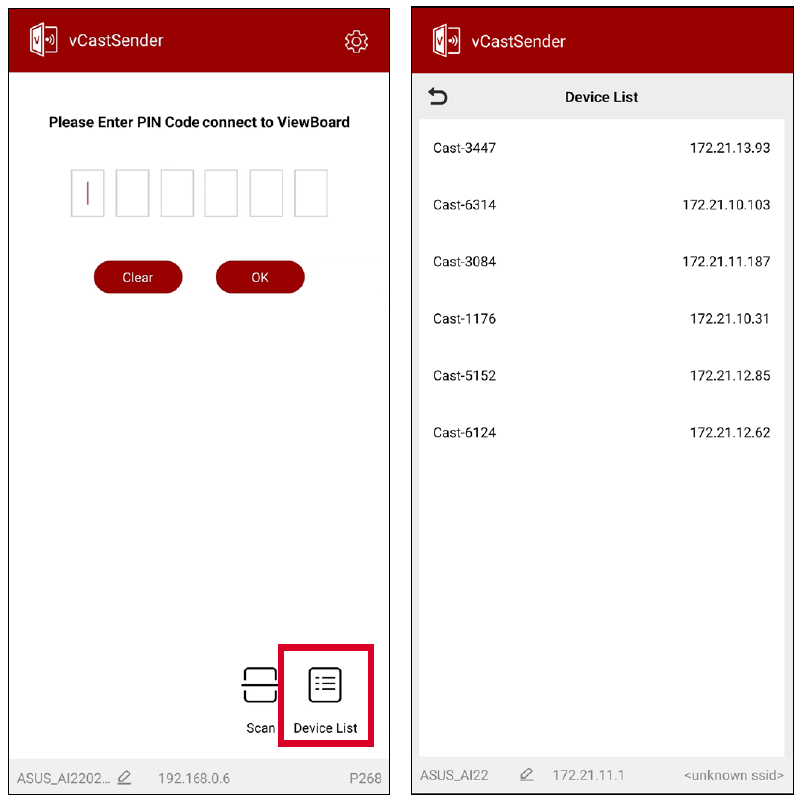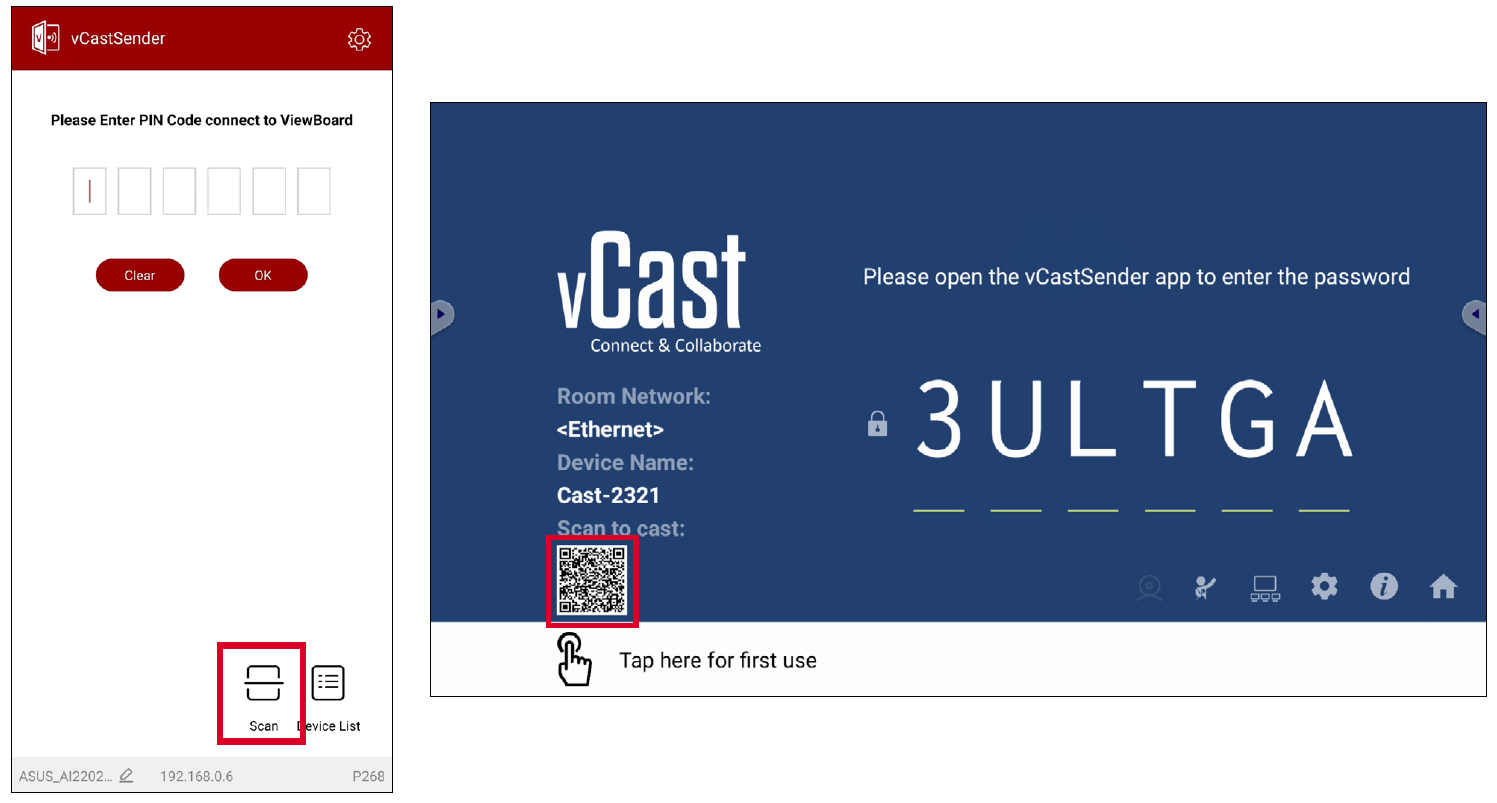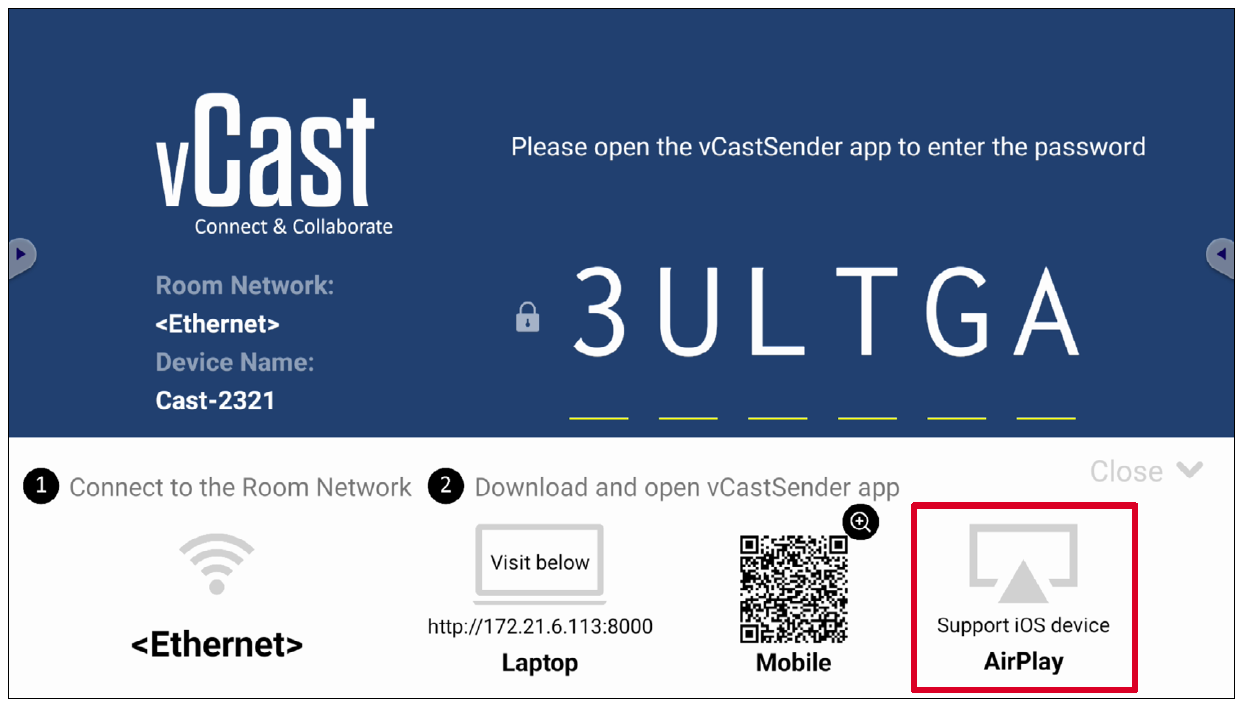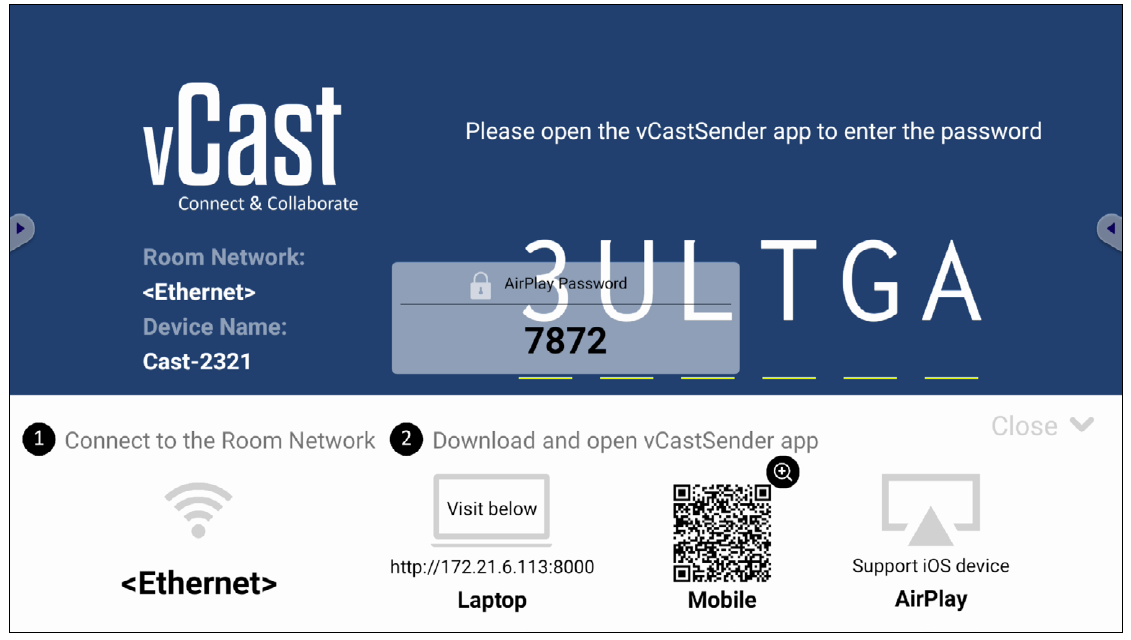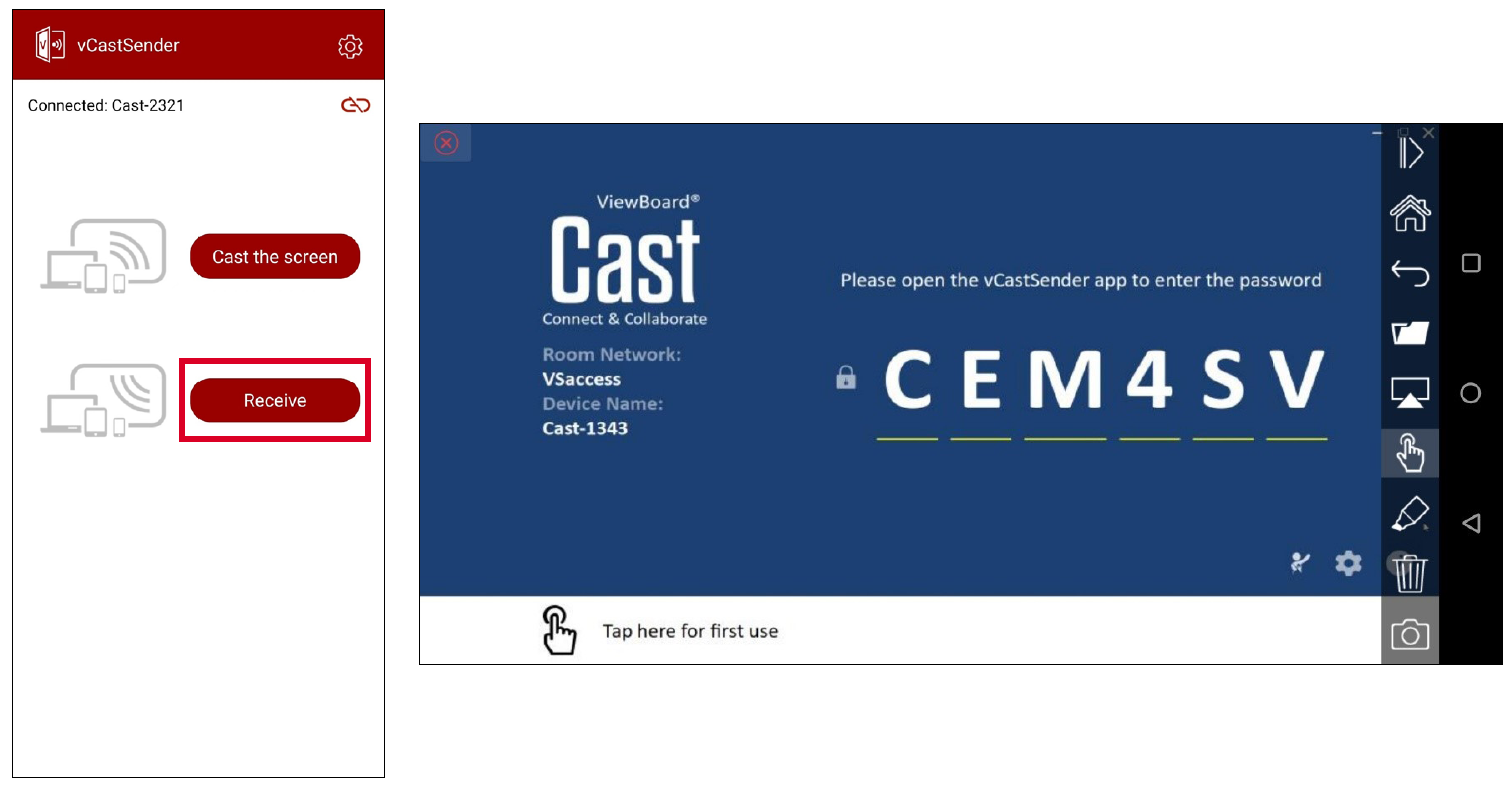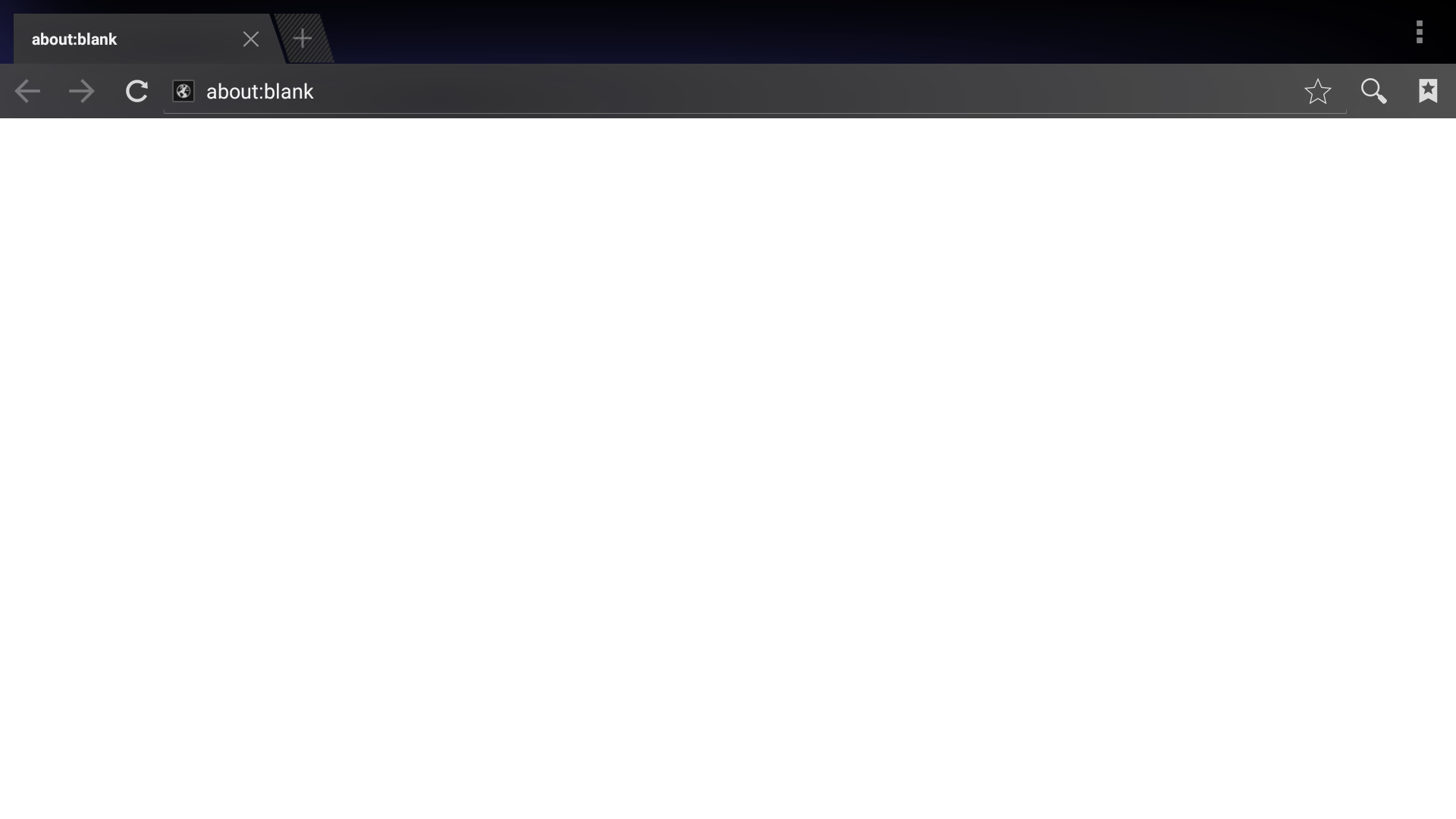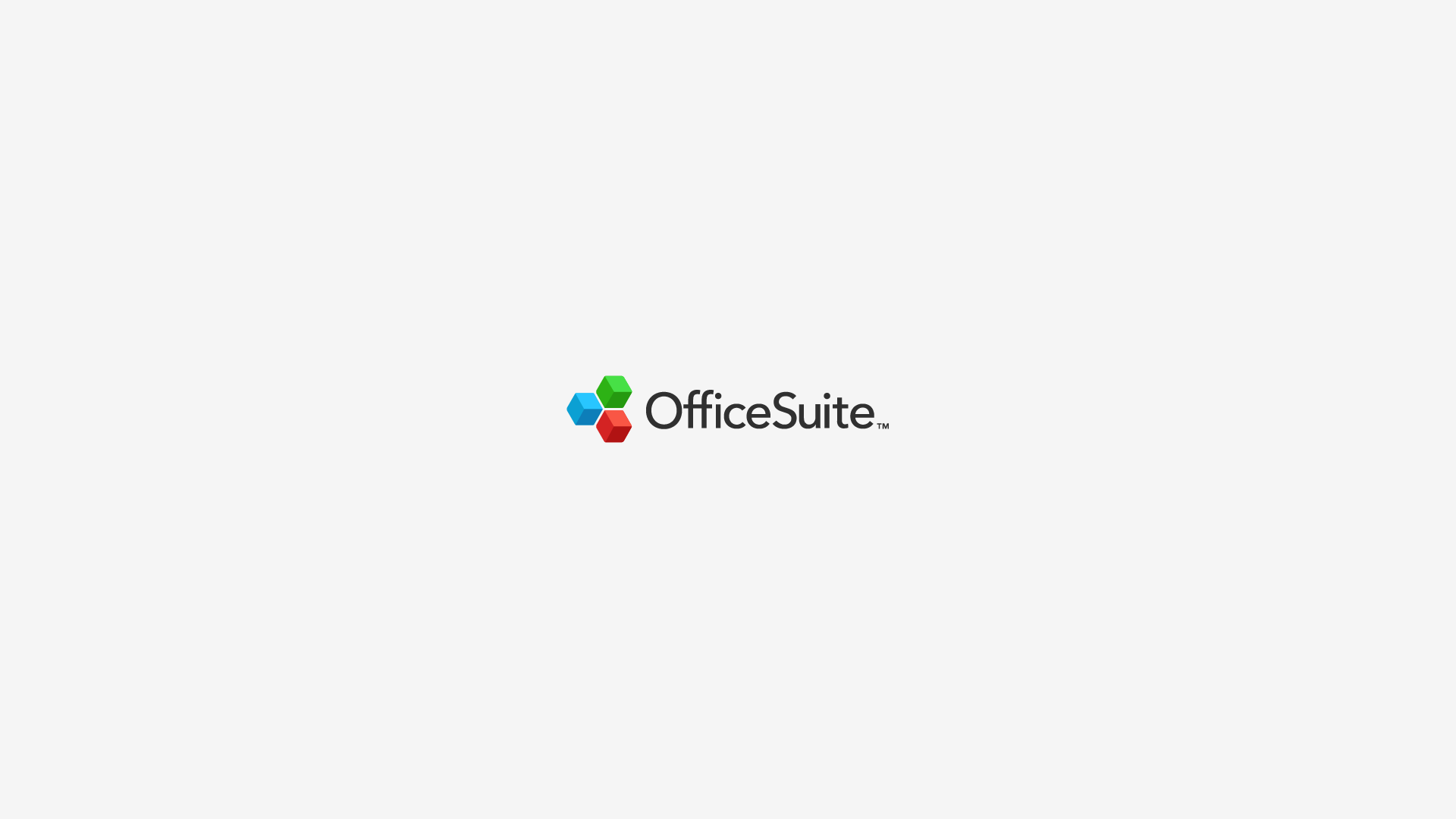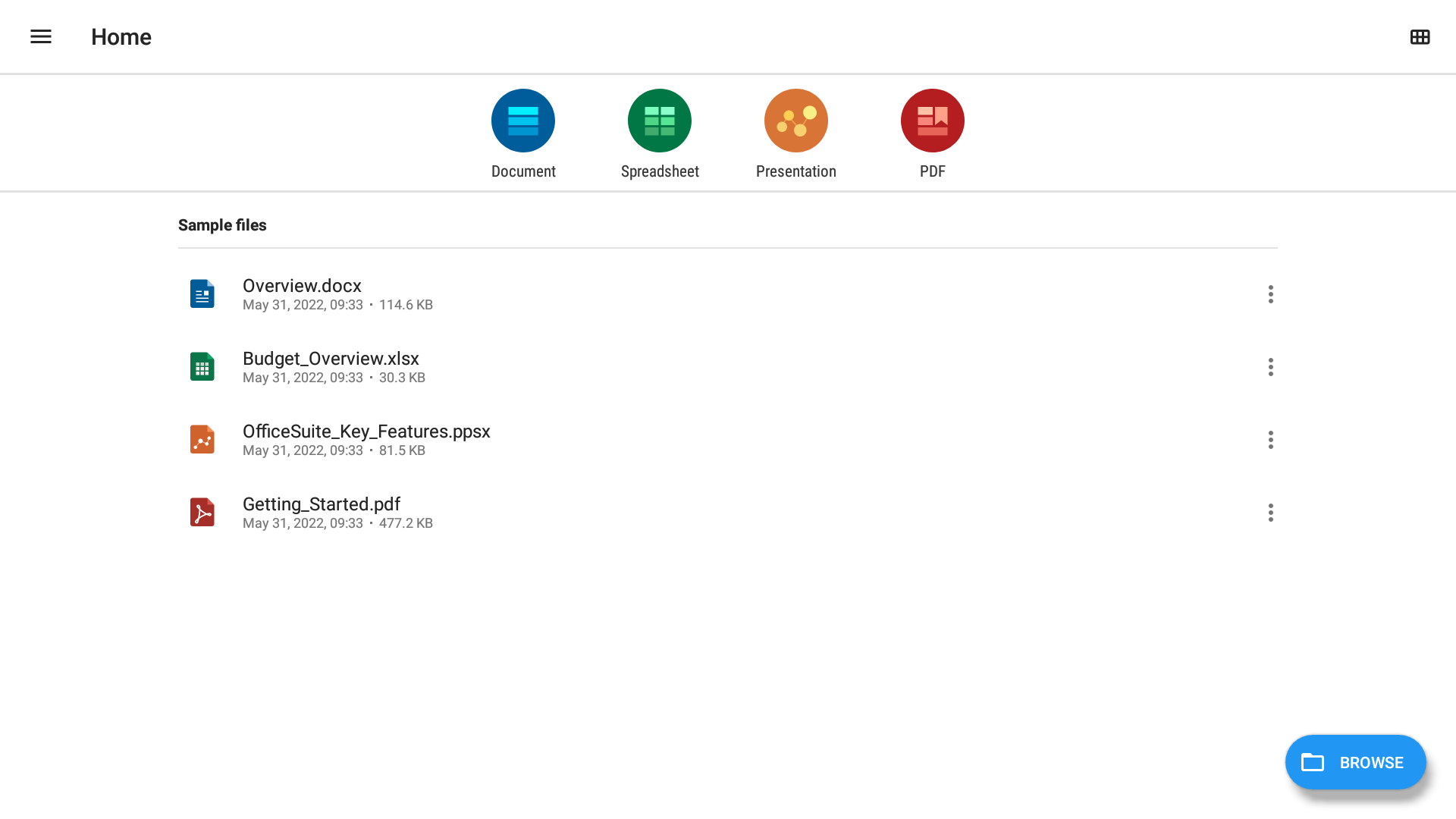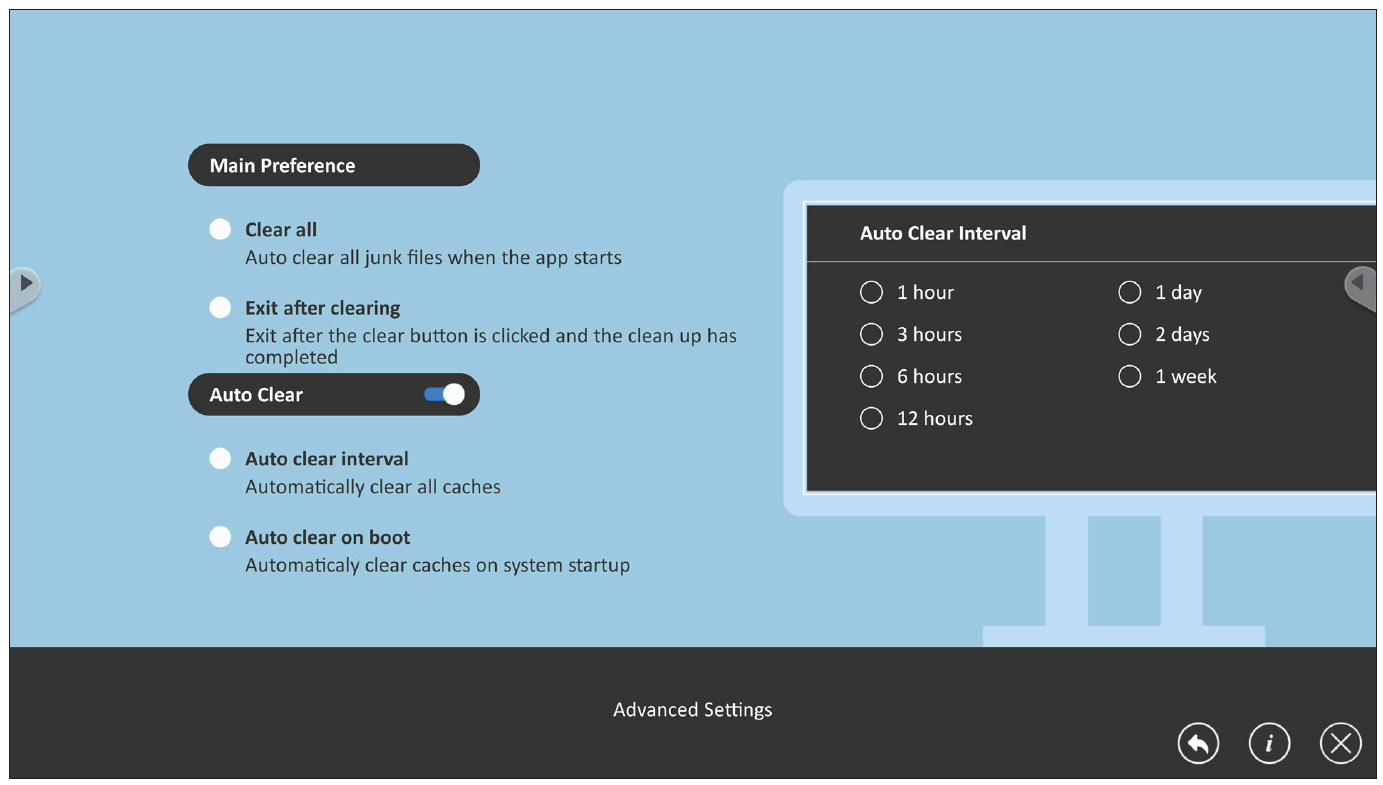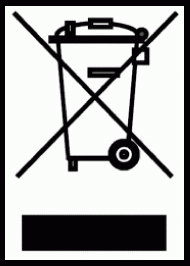
Product Overview
Below is an 8 x 6 cabinet example. Sizing will vary by model.
Front View
Rear View
Control Panel and I/O
The I/O ports can be accessed by removing the right side of the System Control Box Cover.
Control Panel
| Item
|
Description
|
| 1
|
Light Sensor
|
Ambient light sensor.
|
| 2
|
IR Receiver
|
Receiver for remote control signal.
|
| 3
|
USB Type C
|
USB 2.0 support (5V/1.0A).
|
| 4
|
USB 3.0
|
USB Reader (5V/0.9A).
|
| 5
|
USB 2.0
|
USB Reader (5V/0.5A).
|
| 6
|
Menu
|
Open the display settings or On-Screen Display (OSD) Menu.
|
| 7
|
Brightness/OK
|
- Brightness adjustment button.
- Confirm selection when the OSD Menu is open.
|
| 8
|
Brightness Decrease
|
Decrease the brightness level.
|
| 9
|
Brightness Increase
|
Increase the brightness level.
|
| 10
|
Power
|
Power on, standby and wake button.
|
| 11
|
Indicator Light
|
Power status indicator light.
|
| 12
|
HDMI 4
|
4 High definition input: PIP/PBP, connect to PC with HDMI output, set-top box, or other video device.
|
| 13
|
Audio Out
|
Audio output to an external audio device.
|
I/O Ports
| Item
|
Description
|
| 1
|
S/PDIF Out
|
Multi-channel optical audio signal.
|
| 2
|
Audio OUT
|
Audio output to an external speaker.
|
| 3
|
LAN
|
Standard RJ45 (10M/100M/1000M) Internet connection interface.
|
| 4
|
RJ45
|
Standard RJ45 control connection interface.
|
| 5
|
HDMI 1/2/3
|
High definition input: PIP/PBP ,connect to PC with HDMI output, set-top box, or other video device.
|
| 6
|
HDMI Out
|
Extend the display's content out to another display device.
|
| 7
|
USB 2.0
|
USB Type A port for power (5V/2A).
|
| 8
|
HDMI 4[1]
|
High definition input: PIP/PBP ,connect to PC with HDMI output, set-top box, or other video device.
|
| 9
|
Audio Out[1]
|
Audio output to an external audio device.
|
| 10
|
IR Extension
|
Connection point for an extended IR receiver.
|
| 11
|
RS-232
|
Serial control port.
|
| 12
|
Control Board Switch[2]
|
Control switch for the control board.
|
Notes
- ↑ 1.0 1.1 This port can also be accessed without removing the System Control Box Cover.
- ↑ Make sure to switch to the left for RS-232 control.
Remote Control Overview
| Button
|
Description
|
| 1
|
Power
|
Turn the display on or off.
|
| 2
|
Source
|
Select the input source.
|
| 3
|
Brightness
|
Adjust the screen's brightness level.
|
| 4
|
Blank
|
Change the current screen to a black screen.
|
| 5
|
Directional
|
Navigate menus and make adjustments.
|
| 6
|
OK
|
Confirm the selection.
|
| 7
|
Menu
|
Open the display settings or On-Screen Display (OSD) Menu.
|
| 8
|
Return
|
Return to the previous screen or exit a menu.
|
| 9
|
Home
|
Go to the Home screen.
|
| 10
|
Volume Control
|
Adjust the volume level.
|
| 11
|
Mute
|
Turn off the display's sound.
|
| 12
|
Forwards/Backwards
|
Move to next or previous content.
|
| 13
|
Play/Pause
|
Play or pause content.
|
Bluetooth Remote Control Pairing
To pair the remote control:
- Make sure Bluetooth is enabled, go to: Settings > Network > Bluetooth > Enable.
- Press and hold the Menu
 and Return
and Return  buttons for approximately three seconds until the indicator on the remote control flashes blue.
buttons for approximately three seconds until the indicator on the remote control flashes blue.
- If the pairing is successful, a pop-up message will appear on the screen.
Note: If the pairing is unsuccessful after one minute, please try again by repeating Step 1 above.
Remote Control Receiver Range
The operating range of the remote control is shown here. It has an effective range of 6 meters (20 feet), 30° degrees left and right. Please make sure there is nothing obstructing the remote control’s signal to the receiver.
IR Extension
Note: The IR Extension port is accessed by removing the System Control Box Cover
If an additional IR Receiver is needed, an IR extension cable can be connected to the IR Extension port of the display.
Inserting Remote Control Batteries
The remote control is powered by two 1.5v "AAA" batteries.
To insert batteries into the remote control:
- Remove the cover on the rear of the remote control.
- Insert two “AAA” batteries, ensuring the (+) symbol on the battery matches the (+) on the battery post.
- Replace the cover by aligning it with the slot on the remote control and snapping the latch shut.
WARNING: There is a risk of explosion if batteries are installed with incorrect polarity.
Note:
- It is recommended that you do not mix battery types.
- Avoid exposure to heat or steam.
- Do not allow water or other liquids to splash on the remote control. If the remote control becomes wet, wipe it dry immediately.
- Always dispose of old batteries in an environmentally friendly way. Contact your local government for more information on how to dispose of batteries safely.
Wall Installation
Introduction
The step-by-step instructions in this guide are a general reference for installing the LED Display. If any details in this document are unclear, please contact your reseller for more information.
Note: It is recommended to ask your reseller or licensed professional to install the LED Display.
Before Installing
Ensure there is no direct airflow from air conditioning or heating vents blowing on the display.
Avoid installing the LED Display in places with high humidity.
Due to high power usage, always use power cords specifically designed for this product.
Wood may split if holes are not pre-drilled before installing the Wall Mount Brackets.
Ensure the deviation of the wall surface is < 5 mm.
Wear protective gear, such as gloves and protective shoes, when handling the LED Display.
Due to the size and weight, it is recommended that two or more people handle it.
Standard Installation
You can find all appendixes at the end of the Installation Guide in the package.
Wall Mounting
Before the installation, please ensure the supplied Wall Mount Brackets match the ones illustrated in the Appendix A.
-
Please take a moment to check the following when deciding the installation location. However, for the best results, it is recommended to ask your reseller or licensed professional to install the LED Display.
- The wall space.
- The wall type.
- The power consumption.
- The installation type.
- Cable pathways between the Cabinets, and between the Cabinets and System Control Box.
Note: Refer to the included Appendix A for the detailed instructions on mounting the Wall Mount Brackets, including minimum space requirements.
- Install the first Upper Wall Mount Bracket with the provided screws (M8 x 80 mm Expansion).
- Repeat Step 2, ensuring the second Upper Wall Mount Bracket is level with the first Upper Bracket.
Note: It is recommended to use a laser or torpedo level.
-
After mounting the first and second Upper Wall Mount Brackets to the wall, secure them with the Wall Mount Connector Plate using the six provided screws (PM6 x 10 mm).
- Repeat Step 2~4 for the remaining Upper Wall Mount Bracket(s).
- Install the Lower Wall Mount Brackets in the same manner as the Upper Wall Mount Brackets.
Note: You can also install the Upper Wall Mount Brackets, hang the screen, and then install the Lower Wall Mount Brackets for a more precise fit.
Installing the Cabinets
Before installing the Cabinets on the Wall Mount Brackets, it is recommended to refer to the wiring diagram provided in the included Appendix B first to decide how you want to route the Cables for the power and network connections to the Cabinets.
Additionally, the rubber hole plugs installed on the Cabinets are used to protect the Power and Network Cables from rubbing against any pointed edges. After installing all Cabinets, use a knife to cut the rubber hole plugs to size along the cross according to the thickness of the Cables.
Note: You can find Appendix B at the end of the Installation Guide in the package.
- Place each section of the Cabinet on stable furniture that can safely support them. Start with the Cabinets from the center, then move to the right and left sides of the Wall Mount Brackets (see the included Appendix B to identify Cabinet sections and installation sequence).
Note:
- One Cabinet is divided into separate sections. You can identify these Cabinet sections by the labels on each section or the package.
- The arrow marks on each Cabinet section should be pointing up.
- Attach the Cabinet sections together with the provided screws (M8 x 20 mm).
-
Carefully lift the assembled Cabinet onto the center of the Upper Wall Mount Brackets.
Note: The illustration below is provided for reference only and may differ from the actual product appearance.
-
Ensure the Mounting Brackets sit securely on the Wall Mount Brackets as shown below.
- Repeat Step 1~2 for the second Cabinet.
- Install the first and second Cabinets together with the provided screws (M8 x 20 mm).
-
Check for unevenness of the Cabinets by rubbing the cross section between each Cabinet. If the cross section is not aligned, loosen the M8 screws slightly and tap the Cabinets until the cross section is flat.
-
Repeat Step 1~7 for the remaining Cabinets, ensuring that the Mounting Brackets sit securely on the Wall Mount Brackets, and that the Cabinets are properly secured together.
Note: Refer to the included Appendix B to identify the Cabinets and installation sequence.
- After installing all Cabinets, cut the rubber hole plugs to size along the cross with a knife (see the included Appendix B for the position of the hole plugs).
Connecting and Installing the System Control Box
The left and right sides of the System Control Box are pre-installed with its Covers in the factory. The main system control board is on the right.
The safety wires are used to prevent the Right Cover from falling when accessing the System Control Box. Please ensure that the safety wires are never removed.
Use caution as the System Control Box panel is separated into two pieces with wires attached (See the included Appendix B for example system wiring diagrams).

-
Carefully place the System Control Box on stable furniture that can safely support the System Control Box.
-
To open the Right Cover, slowly bring the supplied System Control Box Maintenance Tool near the surface of the Right Cover where the steel plate is located. Then, the Right Cover should detach from the System Control Box magnetically.
DO NOT try to remove or disconnect the safety wires. Please ensure that the safety wires are never removed.
-
Remove the Left Cover by gripping the top edge of the Cover and pulling it toward you. The Left Cover should simply lift away.
-
Secure the System Control Box panel with the Connector Plate using the provided screws (M3 x 6 mm).
-
Further secure the Connector Plate with the two provided screws (M3 x 5 mm).
-
Install the System Control Box to the bottom of the Cabinets with the provided screws (M8 x 20 mm).
-
Connect the Power and Network Cables from the System Control Box to each Cabinet. Start from the bottom and move to the top (see the included Appendix B for example system wiring diagrams, including wire colors and connection points).
Note: Ensure to match the corresponding letters on the Cables to the Cabinets (A to A, B to B, C to C, D to D, and so on).
-
Connect the LED Display's left speaker to the Audio Out port.
Note: Ensure that the right speaker is properly connected to the other Audio Out port.
- Connect the AC unit(s) of the System Control Box to the main system control board.
-
Ensure the AC unit(s) of the System Control Box is properly connected.
DO NOT connect the System Control Box Power Cable(s) at this time.
- The neutral wires (usually white/blue) are connected to the "N1", "N2", and "N" terminals.
- The hot wires (usually black/brown) are connected to the "L1", "L2", and "L" terminals.
- The input and output terminals are properly grounded (usually in green).
The meaning of wiring color may vary by country.
-
After connecting all Cables and wires, hold the top edge of the Right Cover toward the System Control Box to replace it. Once the Right Cover is replaced, it will be held in place magnetically.
Note: Ensure the Power Button cable is connected before securing the Right Cover.
-
Replace the Left Cover by aligning it properly with the System Control Box; then the Left Cover should attach magnetically.
Installing the LED Modules
Please wear Anti-Static Gloves before handling the LED Modules.
To avoid direct contact with the LED Modules, please remove watches, rings, bracelets, or other metal objects.
Use caution when installing the LED Modules.
-
Starting from the LED Module labeled "1" in the top left corner, align each LED Module with the Cabinet, then carefully press the Module into place.
Note: The arrow marks on the back of the LED Modules should be pointing up.
-
Attach the remaining LED Modules onto the Cabinets. Install from top left and move to bottom right, ensuring to match the corresponding numbers on the Module to the Cabinet. See the included Appendix C for further guidance on the LED Modules.
Note: Before installing the LED Module, ensure that each Module is flush and that there is little to no gap between each. It may be necessary to gently tap the module to make it flush.
Installing the Screen Bezels
The Screen Bezels' plastic tabs are pre-installed onto the Bezels. Ensure all plastic tabs are properly mounted before installing the Screen Bezels onto the screen.
The Screen Bezels' plastic tabs are pre-installed onto the Bezels. Ensure all plastic tabs are properly mounted before installing the Screen Bezels onto the screen.
The label indicates the top of each Screen Bezel. To ensure the Bezels are installed in the correct position, please use the labels on the inside of the Bezels as a guide.
-
Place the Screen Bezel to the correct side of the screen to attach. Start from the left and move to the right (See the included Appendix C for the location where each Screen Bezel should be installed).
Note:
- Ensure the label side of the Screen Bezel is facing the screen.
- Before installing the Screen Bezels, check the label of each Bezel as the label helps you know which side ("L" = left side & "R" = right side) to attach.
- If a Screen Bezel does not seem to fit, lift it up with caution and check if it is on the correct side to install. If the Bezel does not seem to fit at all, please contact your reseller. DO NOT force it into place.
-
Align the plastic tabs of the Screen Bezel with the holes provided in the screen.
-
Press down on the Screen Bezel until you hear it click into place.
- Place the remaining Screen Bezels onto the left and right sides of the screen.
Turning On the LED Display
-
Make sure the System Control Box Power Cable(s) is connected and plugged into power outlets.
Note: When the System Control Box Power Cable(s) is connected to power outlet(s), the Power Indicator Light will be a steady red. This means the LED Display is in standby mode.
-
Your LED Display is now ready to power on.
Hidden Installation
You can find all appendixes at the end of the Installation Guide in the package.
Wall Mounting
Before the installation, please ensure the supplied Wall Mount Brackets match the ones illustrated in the included Appendix A.
-
Please take a moment to check the following when deciding the installation location. However, for the best results, it is recommended to ask your reseller or licensed professional to install the LED Display.
- The wall space.
- The wall type.
- The power consumption.
- The installation type.
- Cable pathways between the Cabinets, and between the Cabinets and System Control Box.
Note: Refer to the included Appendix A for the detailed instructions on mounting the Wall Mount Brackets, including minimum space requirements.
-
Install the first Upper Wall Mount Bracket with the provided screws (M8 x 80 mm Expansion).
-
Repeat Step 2, ensuring the second Upper Wall Mount Bracket is level with the first Upper Bracket.
Note: It is recommended to use a laser or torpedo level.
- Repeat Step 2~3 for the remaining Upper Wall Mount Bracket(s).
-
Install the Lower Wall Mount Brackets in the same manner as the Upper Wall Mount Brackets.
Note: You can also install the Upper Wall Mount Brackets, hang the screen, and then install the Lower Wall Mount Brackets for a more precise fit.
Installing the Cabinets
Before installing the Cabinets on the Wall Mount Brackets, it is recommended to refer to the wiring diagram provided in the included Appendix B first to decide how you want to route the Cables for the power and network connections to the Cabinets.
Additionally, the rubber hole plugs installed on the Cabinets are used to protect the Power and Network Cables from rubbing against any pointed edges. After installing all Cabinets, use a knife to cut the rubber hole plugs to size along the cross according to the thickness of the Cables.
Note: You can find Appendix B at the end of the Installation Guide in the package.
- Locate the Cabinet to install the left Upper System Control Box Mount Bracket (see the included Appendix B to identify the Cabinet).
Note:
- One Cabinet is divided into separate sections. You can identify these Cabinet sections by the labels on each section or the package.
- The arrow marks on each Cabinet section should be pointing up.
- Place each section of the Cabinet on stable furniture that can safely support them.
- Attach the Cabinet sections together with the provided screws (M8 x 20 mm).
- Install the left Upper System Control Box Mount Bracket to the side of the two assembled Cabinet with the provided screws (M8 x 20 mm).
- Repeat Step 1~4 for the right Upper System Control Box Mount Bracket.
- Repeat Step 2~3 for the first Cabinet. Start from the center, and move to the right and left sides of the Wall Mount Brackets (see the included Appendix B to identify Cabinet sections and installation sequence)
- Carefully lift the assembled Cabinet onto the center of the Upper Wall Mount Brackets.
-
Ensure the Mounting Brackets sit securely on the Wall Mount Brackets as shown below.
- Repeat Step 2~3 for the second Cabinet, ensuring it sit securely on the Wall Mount Brackets.
- Install the first and second Cabinets together with the provided screws (M8 x 20 mm).
-
Check for unevenness of the Cabinets by rubbing the cross section between each Cabinet. If the cross section is not aligned, loosen the M8 screws slightly and tap the Cabinets until the cross section is flat.
-
Assemble and install the remaining Cabinets in the same manner as the first two Cabinets. Ensure the Mounting Brackets sit securely on the Wall Mount Brackets, and that the Cabinets are properly secured together.
Note: Refer to the included Appendix B to identify the Cabinets and installation sequence.
- After installing all Cabinets, cut the rubber hole plugs to size along the cross with a knife (see the included Appendix B for the position of the hole plugs).
Connecting and Installing the System Control Box
The left and right sides of the System Control Box are pre-installed with its Covers in the factory. The main system control board is on the right.
The safety wires are used to prevent the Right Cover from falling when accessing the System Control Box. Please ensure that the safety wires are never removed.
Use caution as the System Control Box panel is separated into two pieces with wires attached.
Before installing the System Control Box, the Power and Network Cables of the Cabinets at the lowest row must be routed through the holes provided in the System Control Box from behind (see the included Appendix B for example system wiring diagram).

- Carefully place the System Control Box on stable furniture that can safely support the System Control Box.
- The rubber hole plugs installed on the rear of the System Control Box are used to protect the Cables from rubbing against any pointed edges. Use a knife to cut the hole to size along the cross.
-
To open the Right Cover, slowly bring the supplied System Control Box Maintenance Tool near the surface of the Right Cover where the steel plate is located. Then, the Right Cover should detach from the System Control Box magnetically.
DO NOT try to remove or disconnect the safety wires. Please ensure that the safety wires are never removed.
The LD-SCB-011/LD-SCB-021 control box
TThe LD-SCB-012/LD-SCB-022 control box
-
Remove the Left Cover by gripping the top edge of the Cover and pulling it toward you. The Left Cover should simply lift away.
-
Secure the System Control Box panel with the Connector Plate using the provided screws (M3 x 6 mm).
-
Further secure the Connector Plate with the two provided screws (M3 x 5 mm).
-
Install the short side of the Lower System Control Box Mount Bracket onto the top of the System Control Box with the provided screws (M3 x 6 mm).
Note:
- There are two Lower System Control Box Mount Brackets to install.
- The following illustrations about the installation locations of the Lower System Control Box Mount Brackets are for reference only. See the included Appendix A for the actual installation locations of the Lower Mount Brackets.
The LD-SCB-011/LD-SCB-021 control box
The LD-SCB-012/LD-SCB-022 control box
-
Install the provided screw (M8 x 16 mm) on the Lower System Control Box Mount Bracket. Thread the provided M8 nut onto the screw and fully tighten the nut.
Installing the provided screw and nut to the Brackets (Rear View)
-
Repeat Step 7 for the other Lower System Control Box Mount Bracket.
-
Remove the pre-installed Power and Network Cables of the Cabinets from the System Control Box.
Note: It is recommended to take photos of the completed wiring in the left and main system control boards before removing the Cables.
-
After removing the pre-installed Power and Network Cables of the Cabinets, connect one end of the longer Network Cable to the network port that was disconnected from the System Control Box in Step 10.
Note:
- Refer to the included Appendix B for example system wiring diagrams, including wire colors and connection points.
- Ensure to match the corresponding letters on the Cables to the network ports of the System Control Box (A to A, B to B, C to C, and so on).
-
Carefully thread the Network Cables through the hole provided in the System Control Box to the rear (see the included Appendix B for the position of the cable holes). Avoid sharp bends in the Cables.
Note: The rubber hole plugs must always be placed in the holes.
-
After threading all Network Cables of the Cabinets, connect the longer Power Cables to the AC unit(s) of the System Control Box.
DO NOT connect the System Control Box Power Cable(s) at this time.
- Connect the neutral wires (usually white/blue) to the "N1", "N2", and "N" terminals.
- Connect the hot wires (usually black/brown) to the "L1", "L2", and "L" terminals.
- Connect the ground wires (usually in green) to the ground terminals.
The meaning of wiring color may vary by country.
Use the provided wrench to tighten the neutral, hot, and ground conductors in the terminals properly.
-
Thread the Power Cables of the Cabinets through the hole provided in the System Control Box to the rear (see the included Appendix C for the position of the cable holes). Avoid sharp bends in the Cables.
Note:
- The rubber hole plugs must always be placed in the holes.
- Before threading the Cables through, ensure that the output and input terminals are properly grounded, and that the wire colors/labels are matched with the marked terminals and each wire is screwed firmly to its corresponding terminal.
-
Connect the AC unit(s) of the System Control Box to the main system control board.
-
Connect the LED Display's left speaker to the Audio Out port.
Note: Ensure that the right speaker is properly connected to the other Audio Out port.
- Connect the IR Extension Cable to the main system control board. Then, route it through the hole of the System Control Box to the rear.
Note: Refer to the included Appendix C for the position of the cable holes.
-
After connecting all Cables and wires, hold the top edge of the Right Cover toward the System Control Box to replace it. Once the Right Cover is replaced, it will be held in place magnetically.
Note: Ensure the Power Button cable is connected before securing the Right Cover.
-
Replace the Left Cover by aligning it properly with the System Control Box; then the Left Cover should attach magnetically.
-
Align the Lower System Control Box Mount Brackets with the Upper Mount Brackets to attach.
- Thread the Power and Network Cables through the holes provided in the Cabinets to the front.
Note: Ensure to match the corresponding letters on the Cables to the Cabinets (A to A, B to B, C to C, and so on).
- Carefully place the Lower System Control Box Mount Brackets onto the Upper System Control Box Mount Brackets.
-
Ensure the Lower System Control Box Mount Brackets sit securely on the Upper.
- After installing the System Control Box, connect the Power and Network Cables from the System Control Box to each Cabinet. Start from the bottom and move to the top (see the included Appendix B for example system wiring diagrams, including wire colors and connection points).
Installing the LED Modules
Please wear Anti-Static Gloves before handling the LED Modules.
To avoid direct contact with the LED Modules, please remove watches, rings, bracelets, or other metal objects.
Use caution when installing the LED Modules.
-
Starting from the LED Module labeled "1" in the top left corner, align each LED Module with the Cabinet, then carefully press the Module into place.
Note: The arrow marks on the back of the LED Modules should be pointing up.
-
Attach the remaining LED Modules onto the Cabinets. Install from top left and move to bottom right, ensuring to match the corresponding numbers on the Module to the Cabinet. See the included Appendix C for further guidance on the LED Modules.
Note: Before installing the LED Module, ensure that each Module is flush and that there is little to no gap between each. It may be necessary to gently tap the module to make it flush.
Installing the Screen Bezels
The Screen Bezels' plastic tabs are pre-installed onto the Bezels. Ensure all plastic tabs are properly mounted before installing the Screen Bezels onto the screen.
The Screen Bezels' plastic tabs are pre-installed onto the Bezels. Ensure all plastic tabs are properly mounted before installing the Screen Bezels onto the screen.
The label indicates the top of each Screen Bezel. To ensure the Bezels are installed in the correct position, please use the labels on the inside of the Bezels as a guide.
-
Place the Screen Bezel to the correct side of the screen to attach. Start from the left and move to the right (See the included Appendix C for the location where each Screen Bezel should be installed).
Note:
- Ensure the label side of the Screen Bezel is facing the screen.
- Before installing the Screen Bezels, check the label of each Bezel as the label helps you know which side ("L" = left side & "R" = right side) to attach.
- If a Screen Bezel does not seem to fit, lift it up with caution and check if it is on the correct side to install. If the Bezel does not seem to fit at all, please contact your reseller. DO NOT force it into place.
-
Align the plastic tabs of the Screen Bezel with the holes provided in the screen.
-
Press down on the Screen Bezel until you hear it click into place.
- Place the remaining Screen Bezels onto the left and right sides of the screen.
Turning On the LED Display
-
Make sure the System Control Box Power Cable(s) is connected and plugged into power outlet(s).
Note: When the System Control Box Power Cable(s) is connected to power outlet(s), the Power Indicator Light will be a steady red. This means the LED Display is in standby mode.
-
Your LED Display is now ready to power on.
Separate Installation
You can find all appendixes at the end of the Installation Guide in the package.
Wall Mounting
Before the installation, please ensure the supplied Wall Mount Brackets match the ones illustrated in the included Appendix A.
-
Please take a moment to check the following when deciding the installation location. However, for the best results, it is recommended to ask your reseller or licensed professional to install the LED Display.
- The wall space.
- The wall type.
- The power consumption.
- The installation type.
- Cable pathways between the Cabinets, and between the Cabinets and System Control Box.
Note: Refer to the included Appendix A for the detailed instructions on mounting the Wall Mount Brackets, including minimum space requirements.
- Install the first Upper Wall Mount Bracket with the provided screws (M8 x 80 mm Expansion).
- Repeat Step 2, ensuring the second Upper Wall Mount Bracket is level with the first Upper Bracket.
Note: It is recommended to use a laser or torpedo level.
-
After mounting the first and second Upper Wall Mount Brackets to the wall, secure them with the Wall Mount Connector Plate using the six provided screws (PM6 x 10 mm).
- Repeat Step 2~4 for the remaining Upper Wall Mount Bracket(s).
- Install the Lower Wall Mount Brackets in the same manner as the Upper Wall Mount Brackets.
Note: You can also install the Upper Wall Mount Brackets, hang the screen, and then install the Lower Wall Mount Brackets for a more precise fit.
- After installing the Upper and Lower Wall Mount Brackets, please mark and pre-drill the mounting and cable access holes for the System Control Box (see Appendix B for the position of the required holes).
Installing the Cabinets
Before installing the Cabinets on the Wall Mount Brackets, it is recommended to refer to the wiring diagram provided in the included Appendix B first to decide how you want to route the Cables for the power and network connections to the Cabinets.
Additionally, the rubber hole plugs installed on the Cabinets are used to protect the Power and Network Cables from rubbing against any pointed edges. After installing all Cabinets, use a knife to cut the rubber hole plugs to size along the cross according to the thickness of the Cables.
Note: You can find Appendix B at the end of the Installation Guide in the package.
- Place each section of the Cabinet on stable furniture that can safely support them. Start with the Cabinets from the center, then move to the right and left sides of the Wall Mount Brackets (see the included Appendix B to identify Cabinet sections and installation sequence).
Note:
- One Cabinet is divided into separate sections. You can identify these Cabinet sections by the labels on each section or the package.
- The arrow marks on each Cabinet section should be pointing up.
- Attach the Cabinet sections together with the provided screws (M8 x 20 mm).
-
Carefully lift the assembled Cabinet onto the center of the Upper Wall Mount Brackets.
Note: The illustration below is provided for reference only and may differ from the actual product appearance.
-
Ensure the Mounting Brackets sit securely on the Wall Mount Brackets as shown below.
- Repeat Step 1~2 for the second Cabinet.
- Install the first and second Cabinets together with the provided screws (M8 x 20 mm).
-
Check for unevenness of the Cabinets by rubbing the cross section between each Cabinet. If the cross section is not aligned, loosen the M8 screws slightly and tap the Cabinets until the cross section is flat.
-
Repeat Step 1~7 for the remaining Cabinets, ensuring that the Mounting Brackets sit securely on the Wall Mount Brackets, and that the Cabinets are properly secured together.
Note: Refer to the included Appendix B to identify the Cabinets and installation sequence.
- After installing all Cabinets, cut the rubber hole plugs to size along the cross with a knife (see the included Appendix B for the position of the hole plugs).
Connecting and Installing the System Control Box
The left and right sides of the System Control Box are pre-installed with its Covers in the factory. The main system control board is on the right.
The safety wires are used to prevent the Right Cover from falling when accessing the System Control Box. Please ensure that the safety wires are never removed.
Use caution as the System Control Box panel is separated into two pieces with wires attached.
Before installing the System Control Box, the Power and Network Cables of the Cabinets at the lowest row must be routed through the holes provided in the System Control Box from behind (see the included Appendix B for example system wiring diagram).

-
At the lowest row of the Cabinets, connect the connector of the longer Power Cable to the power connector of the Cabinet. Then, connect one end of the longer Network Cable to the network port of the Cabinet.
Note:
- The longer Power and Network Cables are supplied in the case.
- Ensure to match the corresponding letters on the Cables to the Cabinets (A to A, B to B, C to C, and so on).
- After connecting all the Power and Network Cables, carefully thread them through the holes provided in the Cabinets and run the Cables behind the Cabinets from the top cable access hole through the bottom cable access holes.
Avoid sharp bends in the Cables.
The rubber hole plugs must always be placed in the holes.
- Carefully place the System Control Box on stable furniture that can safely support the System Control Box.
- The rubber hole plugs installed on both the System Control Box and Cabinets are used to protect the Cables from rubbing against any pointed edges. Use a knife to cut the hole to size along the cross.
-
To open the Right Cover, slowly bring the supplied System Control Box Maintenance Tool near the surface of the Right Cover where the steel plate is located. Then, the Right Cover should detach from the System Control Box magnetically.
DO NOT try to remove or disconnect the safety wires. Please ensure that the safety wires are never removed.
The LD-SCB-011/LD-SCB-021 control box
TThe LD-SCB-012/LD-SCB-022 control box
-
Remove the Left Cover by gripping the top edge of the Cover and pulling it toward you. The Left Cover should simply lift away.
-
Secure the System Control Box panel with the Connector Plate using the provided screws (M3 x 6 mm).
-
Further secure the Connector Plate with the two provided screws (M3 x 5 mm).
-
Place the System Control Box accordingly over the drilled mounting holes to attach.
- Carefully thread the Power and Network Cables through the holes provided in the System Control Box from behind. Ensure to use the correct cable holes for the Power and Network Cables.
Note:
- The rubber hole plugs must always be placed in the holes.
- Refer to the included Appendix B for the position of the cable holes.
- After threading the Power and Network Cables, install the System Control Box onto the wall with the provided screws and lock washers (M8 x 80 mm Expansion).
-
Remove the pre-installed Power and Network Cables of the Cabinets from the System Control Box.
Note: It is recommended to take photos of the completed wiring in the left and main system control boards before removing the Cables.
- After removing the pre-installed Power and Network Cables of the Cabinets, connect the other end of the longer Network Cable to the network port that was disconnected from the System Control Box in Step 12.
-
After connecting all Network Cables of the Cabinets, connect the longer Power Cables to the AC unit(s) of the System Control Box.
DO NOT connect the System Control Box Power Cable(s) at this time.
- Connect the neutral wires (usually white/blue) to the "N1", "N2", and "N" terminals.
- Connect the hot wires (usually black/brown) to the "L1", "L2", and "L" terminals.
- Connect the ground wires (usually in green) to the ground terminals.
The meaning of wiring color may vary by country.
Use the provided wrench to tighten the neutral, hot, and ground conductors in the terminals properly.
- Connect the AC unit(s) of the System Control Box to the main system control board.
- Connect the LED Display's left speaker to the Audio Out port.
Note: Ensure that the right speaker is properly connected to the other Audio Out port.
- Connect the IR Extension Cable to the main system control board. Then, route it through the hole of the System Control Box to the rear.
Note: Refer to the included Appendix B for the position of the cable holes.
-
After connecting all Cables and wires, hold the top edge of the Right Cover toward the System Control Box to replace it. Once the Right Cover is replaced, it will be held in place magnetically.
Note: Ensure the Power Button cable is connected before securing the Right Cover.
-
Replace the Left Cover by aligning it properly with the System Control Box; then the Left Cover should attach magnetically.
- After replacing the System Control Box Covers, connect the Power and Network Cables between the Cabinets (see the included Appendix B for the wiring instructions).
- Install System Control Box Trim Strip(s) on the top of the System Control Box.
Installing the LED Modules
Please wear Anti-Static Gloves before handling the LED Modules.
To avoid direct contact with the LED Modules, please remove watches, rings, bracelets, or other metal objects.
Use caution when installing the LED Modules.
-
Starting from the LED Module labeled "1" in the top left corner, align each LED Module with the Cabinet, then carefully press the Module into place.
Note: The arrow marks on the back of the LED Modules should be pointing up.
-
Attach the remaining LED Modules onto the Cabinets. Install from top left and move to bottom right, ensuring to match the corresponding numbers on the Module to the Cabinet. See the included Appendix C for further guidance on the LED Modules.
Note: Before installing the LED Module, ensure that each Module is flush and that there is little to no gap between each. It may be necessary to gently tap the module to make it flush.
Installing the Screen Bezels
The Screen Bezels' plastic tabs are pre-installed onto the Bezels. Ensure all plastic tabs are properly mounted before installing the Screen Bezels onto the screen.
The Screen Bezels' plastic tabs are pre-installed onto the Bezels. Ensure all plastic tabs are properly mounted before installing the Screen Bezels onto the screen.
The label indicates the top of each Screen Bezel. To ensure the Bezels are installed in the correct position, please use the labels on the inside of the Bezels as a guide.
-
Place the Screen Bezel to the correct side of the screen to attach. Start from the left and move to the right (See the included Appendix C for the location where each Screen Bezel should be installed).
Note:
- Ensure the label side of the Screen Bezel is facing the screen.
- Before installing the Screen Bezels, check the label of each Bezel as the label helps you know which side ("L" = left side & "R" = right side) to attach.
- If a Screen Bezel does not seem to fit, lift it up with caution and check if it is on the correct side to install. If the Bezel does not seem to fit at all, please contact your reseller. DO NOT force it into place.
-
Align the plastic tabs of the Screen Bezel with the holes provided in the screen.
-
Press down on the Screen Bezel until you hear it click into place.
- Place the remaining Screen Bezels onto the left and right sides of the screen.
Turning On the LED Display
-
Make sure the System Control Box Power Cable(s) is connected and plugged into power outlet(s).
Note: When the System Control Box Power Cable(s) is connected to power outlet(s), the Power Indicator Light will be a steady red. This means the LED Display is in standby mode.
-
Your LED Display is now ready to power on.
Flood Stand Installation (Optional)
The step-by-step instructions in this guide are a general reference for installing the LED Display. If any details in this document are unclear, please contact your reseller for more information.
Before Building
DO NOT move the trolley over cords or uneven, dirty, soft, or high incline surfaces.
To avoid injury, KEEP AWAY from moving parts.
DO NOT move the trolley by pushing on the LED Display.
DO NOT push the trolley from the front of the LED Display or attempt to lift it.
Wear protective gear, such as gloves and protective shoes, when handling the LED Display.
Building the Trolley
-
Install the Top and Bottom Cross Beams to the Left and Right Supports. Secure them together with the provided screws (M8 x 20 mm).
Building the Trolley (Rear View)
-
Connect the first and second Upper Wall Mount Brackets using the Wall Mount Connector Plate with the six provided screws (PM6 x 10 mm).
- Repeat Step 2 for the remaining Upper Wall Mount Bracket(s).
- Install the Upper Wall Mount Brackets to the Top Cross Beam with the provided screws (M8 x 80 mm), lock washers, and nuts.
-
Install the Cabinet Brackets to the lower side of the Left and Right Supports with the provided screws and nuts. The Cabinet Brackets are used later for further securing the lower part of the Cabinets to the trolley.
Note: Refer to the included Appendix A for the position of the Wall Mount Brackets.
Installing the Cabinets
Before installing the Cabinets onto the trolley, please ensure all parts are accurately and securely held together.
- Place each section of the Cabinet on stable furniture that can safely support them. Start with the Cabinets from the center, then move to the right and left sides of the Wall Mount Brackets (see the included Appendix B to identify Cabinet sections and installation sequence).
Note:
- One Cabinet is divided into separate sections. You can identify these Cabinet sections by the labels on each section or the package.
- The arrow marks on each Cabinet section should be pointing up.
- Attach the Cabinet sections together with the provided screws (M8 x 20 mm).
-
Carefully lift the assembled Cabinet onto the center of the Upper Wall Mount Brackets.
Note: Ensure the Mounting Brackets on the rear of the Cabinet sit securely on the Upper Wall Mount Bracket.
- Repeat Step 1~2 for the second Cabinet.
- Install the first and second Cabinets together with the provided screws (M8 x 20 mm).
-
Check for unevenness of the Cabinets by rubbing the cross section between each Cabinet. If the cross section is not aligned, loosen the M8 screws slightly and tap the Cabinets until the cross section is flat.
-
Repeat Step 1~6 for the remaining Cabinets, ensuring that the Mounting Brackets sit securely on the Wall Mount Brackets, and that the Cabinets are properly secured together.
Note: Refer to the included Appendix B to identify the Cabinets and installation sequence.
-
Adjust the left Cabinet Bracket until it is aligned with the hole provided in the Cabinet.
-
Secure the left Cabinet Bracket to the Cabinet with the provided screw (M8 x 20 mm).
- Install the right Cabinet Bracket in the same manner as the left Cabinet Bracket.
Note: When you use the trolley for your LED Display, the System Control Box can only be installed under the Cabinets (Standard Installation). Hidden and Separate Installation are not applicable to the trolley.
Connecting and Installing the System Control Box
The left and right sides of the System Control Box are pre-installed with its Covers in the factory. The main system control board is on the right.
The safety wires are used to prevent the Right Cover from falling when accessing the System Control Box. Please ensure that the safety wires are never removed.
Use caution as the System Control Box panel is separated into two pieces with wires attached (See the included Appendix B for example system wiring diagrams).

-
Carefully place the System Control Box on stable furniture that can safely support the System Control Box.
-
To open the Right Cover, slowly bring the supplied System Control Box Maintenance Tool near the surface of the Right Cover where the steel plate is located. Then, the Right Cover should detach from the System Control Box magnetically.
DO NOT try to remove or disconnect the safety wires. Please ensure that the safety wires are never removed.
-
Remove the Left Cover by gripping the top edge of the Cover and pulling it toward you. The Left Cover should simply lift away.
-
Secure the System Control Box panel with the Connector Plate using the provided screws (M3 x 6 mm).
-
Further secure the Connector Plate with the two provided screws (M3 x 5 mm).
- Install the System Control Box to the bottom of the Cabinets with the provided screws (M8 x 20 mm). See the included Appendix B for the mounting points.
-
Connect the Power and Network Cables from the System Control Box to each Cabinet. Start from the bottom and move to the top (see the included Appendix B for example system wiring diagrams, including wire colors and connection points).
Note: Ensure to match the corresponding letters on the Cables to the Cabinets (A to A, B to B, C to C, D to D, and so on).
-
Connect the LED Display's left speaker to the Audio Out port.
Note: Ensure that the right speaker is properly connected to the other Audio Out port.
- Connect the AC unit(s) of the System Control Box to the main system control board.
-
Ensure the AC unit(s) of the System Control Box is properly connected.
DO NOT connect the System Control Box Power Cable(s) at this time.
- The neutral wires (usually white/blue) are connected to the "N1", "N2", and "N" terminals.
- The hot wires (usually black/brown) are connected to the "L1", "L2", and "L" terminals.
- The input and output terminals are properly grounded (usually in green).
The meaning of wiring color may vary by country.
-
After connecting all Cables and wires, hold the top edge of the Right Cover toward the System Control Box to replace it. Once the Right Cover is replaced, it will be held in place magnetically.
Note: Ensure the Power Button cable is connected before securing the Right Cover.
-
Replace the Left Cover by aligning it properly with the System Control Box; then the Left Cover should attach magnetically.
Installing the LED Modules
Please wear Anti-Static Gloves before handling the LED Modules.
To avoid direct contact with the LED Modules, please remove watches, rings, bracelets, or other metal objects.
Use caution when installing the LED Modules.
-
Starting from the LED Module labeled "1" in the top left corner, align each LED Module with the Cabinet, then carefully press the Module into place.
Note: The arrow marks on the back of the LED Modules should be pointing up.
-
Attach the remaining LED Modules onto the Cabinets. Install from top left and move to bottom right, ensuring to match the corresponding numbers on the Module to the Cabinet. See the included Appendix C for further guidance on the LED Modules.
Note: Before installing the LED Module, ensure that each Module is flush and that there is little to no gap between each. It may be necessary to gently tap the module to make it flush.
Installing the Screen Bezels
The Screen Bezels' plastic tabs are pre-installed onto the Bezels. Ensure all plastic tabs are properly mounted before installing the Screen Bezels onto the screen.
The Screen Bezels' plastic tabs are pre-installed onto the Bezels. Ensure all plastic tabs are properly mounted before installing the Screen Bezels onto the screen.
The label indicates the top of each Screen Bezel. To ensure the Bezels are installed in the correct position, please use the labels on the inside of the Bezels as a guide.
-
Place the Screen Bezel to the correct side of the screen to attach. Start from the left and move to the right (See the included Appendix C for the location where each Screen Bezel should be installed).
Note:
- Ensure the label side of the Screen Bezel is facing the screen.
- Before installing the Screen Bezels, check the label of each Bezel as the label helps you know which side ("L" = left side & "R" = right side) to attach.
- If a Screen Bezel does not seem to fit, lift it up with caution and check if it is on the correct side to install. If the Bezel does not seem to fit at all, please contact your reseller. DO NOT force it into place.
-
Align the plastic tabs of the Screen Bezel with the holes provided in the screen.
-
Press down on the Screen Bezel until you hear it click into place.
- Place the remaining Screen Bezels onto the left and right sides of the screen.
Turning On the LED Display
-
Make sure the System Control Box Power Cable(s) is connected and plugged into power outlet(s).
Note: When the System Control Box Power Cable(s) is connected to power outlet(s), the Power Indicator Light will be a steady red. This means the LED Display is in standby mode.
-
Your LED Display is now ready to power on.
Making Connections
Connecting to Video
HDMI
Connect an HDMI cable from your external device to the HDMI 1/HDMI 2/HDMI 3/HDMI 4 port on the display.
Note: The HDMI 1/HDMI 2/HDMI 3 port is accessed by removing the System Control Box Cover.
HDMI Out
To output video via an external display device, connect an HDMI cable to the HDMI IN port of your external display device, and the other end to the HDMI OUT port of the display.
Note: The HDMI OUT port is accessed by removing the System Control Box Cover.
USB Connections
USB Type A
Plug the USB device or storage drive into a USB Type A (USB 3.0 or USB 2.0) port on the display’s control panel.
Note: An additional USB Type A port can be accessed by removing the System Control Box Cover; however, it is for power transfer only (5V/0.5A).
USB Type C
Plug the USB device or storage drive into the USB Type C ( ) port on the display’s control panel.
) port on the display’s control panel.
Note: The USB Type C port is for data transfer only.
Network Connection
LAN
To connect to a network, connect an Ethernet cable to your network, then connect the other end to the LAN port of the display.
Note: The LAN port is accessed by removing the System Control Box Cover.
Control Connection
RS-232 (DB 9-pin)
When you use a RS-232 serial cable to connect the display to an external computer or control system, certain functions can be controlled remotely, such as: power on and off, volume adjustment, input select, brightness, and more.
Note: The RS-232 port is accessed by removing the System Control Box Cover.
RJ45 (LAN)
When you use an Ethernet cable to connect the display to an external computer or control system, certain functions can be controlled remotely, such as: power on and off, volume adjustment, input select, brightness, and more.
Note: The RJ45 port is accessed by removing the System Control Box Cover.
Audio Connection
Audio Out
To play audio from the display through an external speaker, connect one end of an audio cable to the external speaker, and the other end to the display's Audio Out port.
Note: The display is equipped with two Audio Out ports. One can be accessed externally, while the other is accessed by removing the System Control Box Cover.
SPDIF
To play audio from the display through an external speaker, connect one end of an optical cable to the external speaker, and the other end to the display's SPDIF Out port.
Note: The SPDIF Out port is accessed by removing the System Control Box Cover.
Turning the LED Display On/Off
- Ensure the power cord is connected and plugged into a power outlet.
- Press the Power button to turn on the display.
- To turn the LED display off, press the Power button again.
Home Screen
Notes
- ↑ Only supported by keyboard and mouse.
Navigating the Home Screen
Remote Control
The remote control can be used to easily navigate the Home Screen. When using the remote control, ensure it is kept within the IR receiver range as shown below:
Keyboard and Mouse
When connected to the USB Type-A port of the display, a keyboard and mouse can also be used to navigate the Home Screen.
An orange mouse pointer will appear on the display when used:
- The left mouse button will confirm actions.
- The right mouse button will go back to the previous layer.
APP Center
Installed applications will be in the App Center.
| Icon
|
Name
|
Description
|
|
|
Settings
|
Adjust and view the display's settings.
|
|
|
Chromium
|
Web Browser.
|
|
|
Folders
|
File explorer.
|
|
|
vSweeper
|
Resources management tool.
|
|
|
Miracast
|
Wireless screen mirroring.
|
|
|
OfficeSuite
|
Create documents, spreadsheets, and presentations.
|
|
|
myViewBoard Display
|
Wireless mirror your desktop.
|
|
|
myViewBoard Manager
|
Remote device management
|
|
|
vCast
|
Receive casted content from other devices.
|
Note: Pre-installed applications are subject to change without notice.
Input Source
The display supports eight input sources: Home, HDMI 1,HDMI 2, HDMI 3, HDMI 4, and Custom.
Note: The
Custom input source is used to quickly access custom applications. To select the custom application, go to:
Settings >
Device >
Signage Display >
Custom App.
Settings
Adjust and view the display's settings.
| Menu
|
Description
|
| Network
|
View and adjust Ethernet, Wi-Fi, Wireless Hotspot, Bluetooth, and Miracast settings.
|
| Dehumidification Service
|
View and adjust dehumidification settings and start the dehumidification process.
|
| Device
|
View and adjust Signage Display, System Tools, Display, Apps, Audio, Physical Keyboard, Input method, and Launcher settings.
|
| System
|
View and adjust Date & Time and About settings.
|
| Sub-menu
|
Menu Option
|
| Ethernet
|
Main Switch
|
Disable
|
| Enable
|
| Ethernet Configuration
|
Connection Type
|
| Mac Address
|
| Wi-Fi
|
Disable
|
|
| Enable
|
| Add Wi-Fi
|
| Wireless Hotspot
|
Main Switch
|
Disable
|
| Enable
|
| Hotspot Configuration
|
Network Name
|
| Security Type
|
| Bluetooth
|
Bluetooth
|
Disable
|
| Enable
|
| Available Device
|
|
| Miracast
|
Main Switch
|
Disable
|
| Enable
|
| Detail
|
Name
|
| Sub-menu
|
Menu Option
|
| Dehumidification Settings
|
Dehumidification Level
|
Shutdown
|
| Low
|
| Middle
|
| High
|
| Begin Dehumidification Now
|
|
| Sub-menu
|
Menu Option
|
| Signage Display
|
General Settings
|
Signage Display Name
|
| Boot Logo
|
| Source Settings
|
Custom App
|
| Credential Settings
|
Trusted Credentials
|
| User Credentials
|
| Install from Storage
|
| Clear Credentials
|
| Security
|
External Storage
|
| Unknown Sources
|
| Privacy and Copyright Protection
|
| App Authority
|
| System Tools
|
Clear Storage
|
All
|
| Internal Storage
|
| USB Storage
|
| Reset
|
Factory Reset
|
| Import & Export
|
Export Signage Display Settings
|
| Import Signage Display Settings
|
| Clone
|
Clone Media Files
|
| Display
|
Font Size
|
|
| Screen Saver
|
| Apps
|
Running
|
|
| All
|
| Download
|
| Physical Keyboard
|
|
| Launcher Settings
|
ViewSonic Logo
|
On
|
| Off
|
| Date & Time
|
On
|
| Off
|
| Theme
|
|
| Input Method
|
|
| Sub-menu
|
Menu Option
|
| Date & Time
|
Select Time Zone
|
| NTP Server
|
| About
|
Local System Updates
|
| Online System Updates
|
| Asset Tagging
|
| Legal Information
|
| Android Version
|
| Kernel Version
|
| Build Number
|
| Operation Hours
|
Network
| Sub-menu
|
Description
|
| Ethernet
|
Enable or disable Ethernet and configure it.
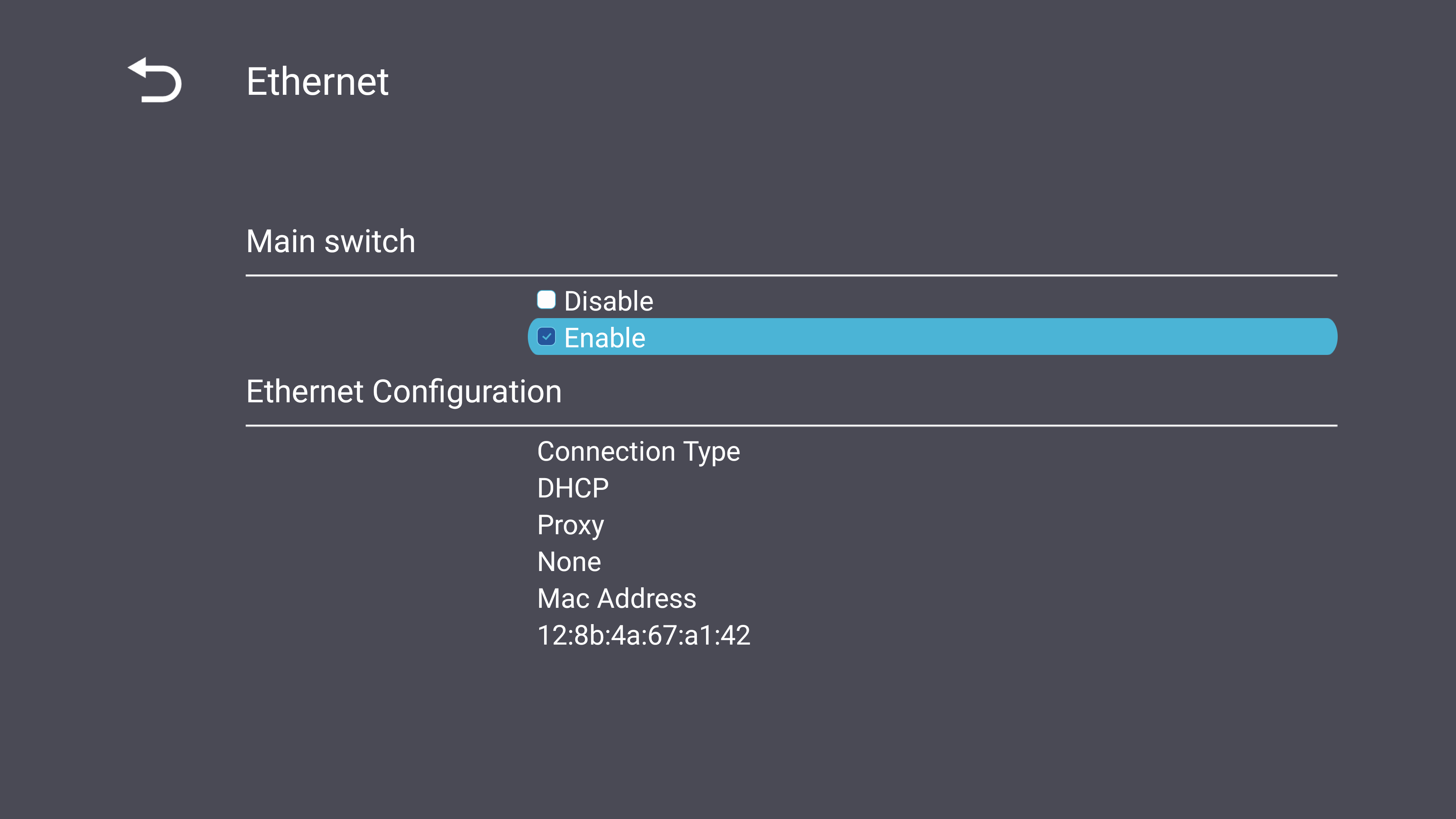
|
| Wi-Fi
|
Open the Wi-Fi selection interface to enable or disable Wi-Fi and connect to a Wi-Fi network.
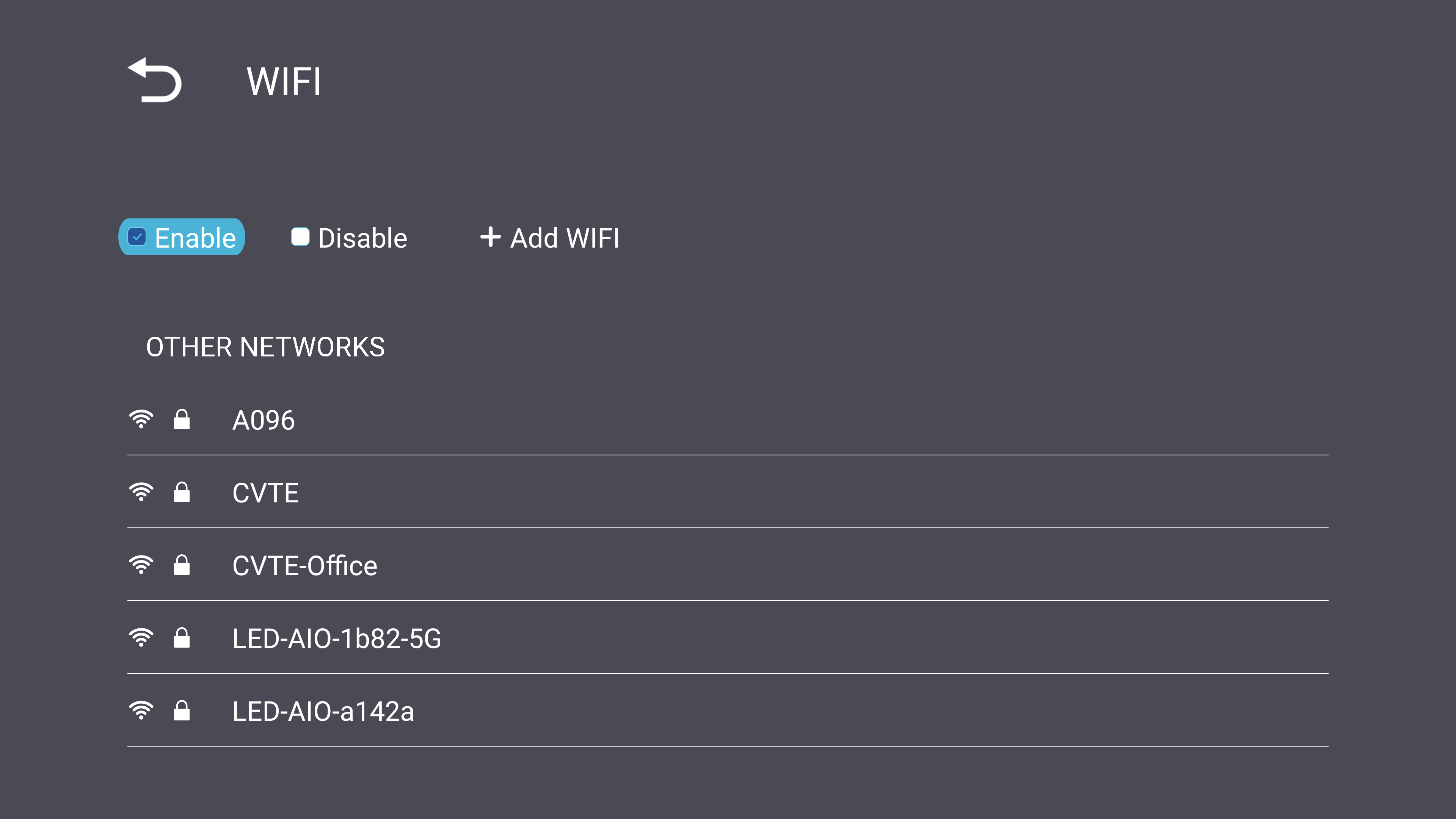
You can also select Add Network in the Wi-Fi selection screen to manually add a Wi-Fi network.
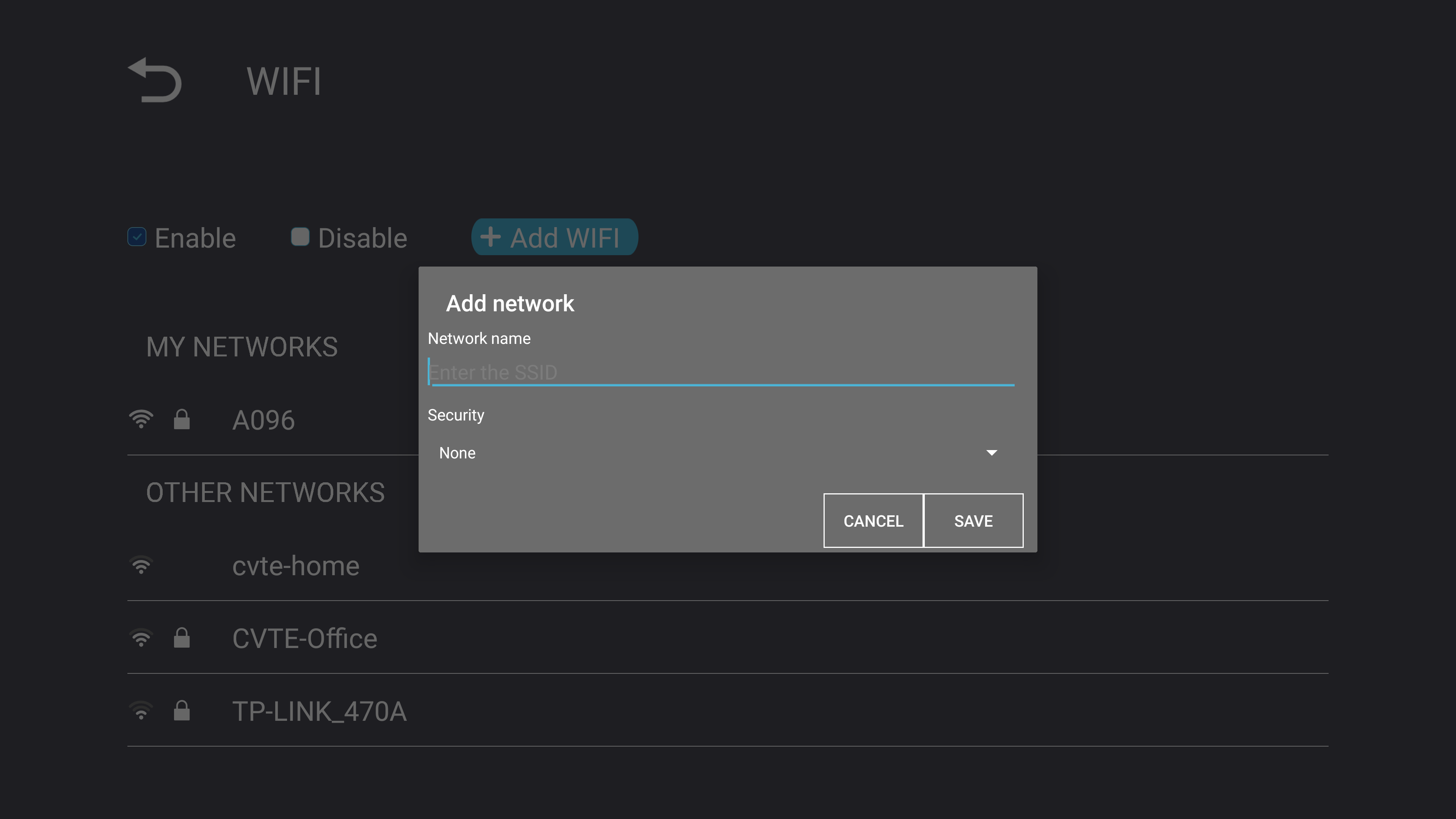
|
| Wireless Hotspot
|
Enable or disable Wireless Wi-Fi Hotspot. Once enabled, the hotspot name will be displayed and can be connected to.
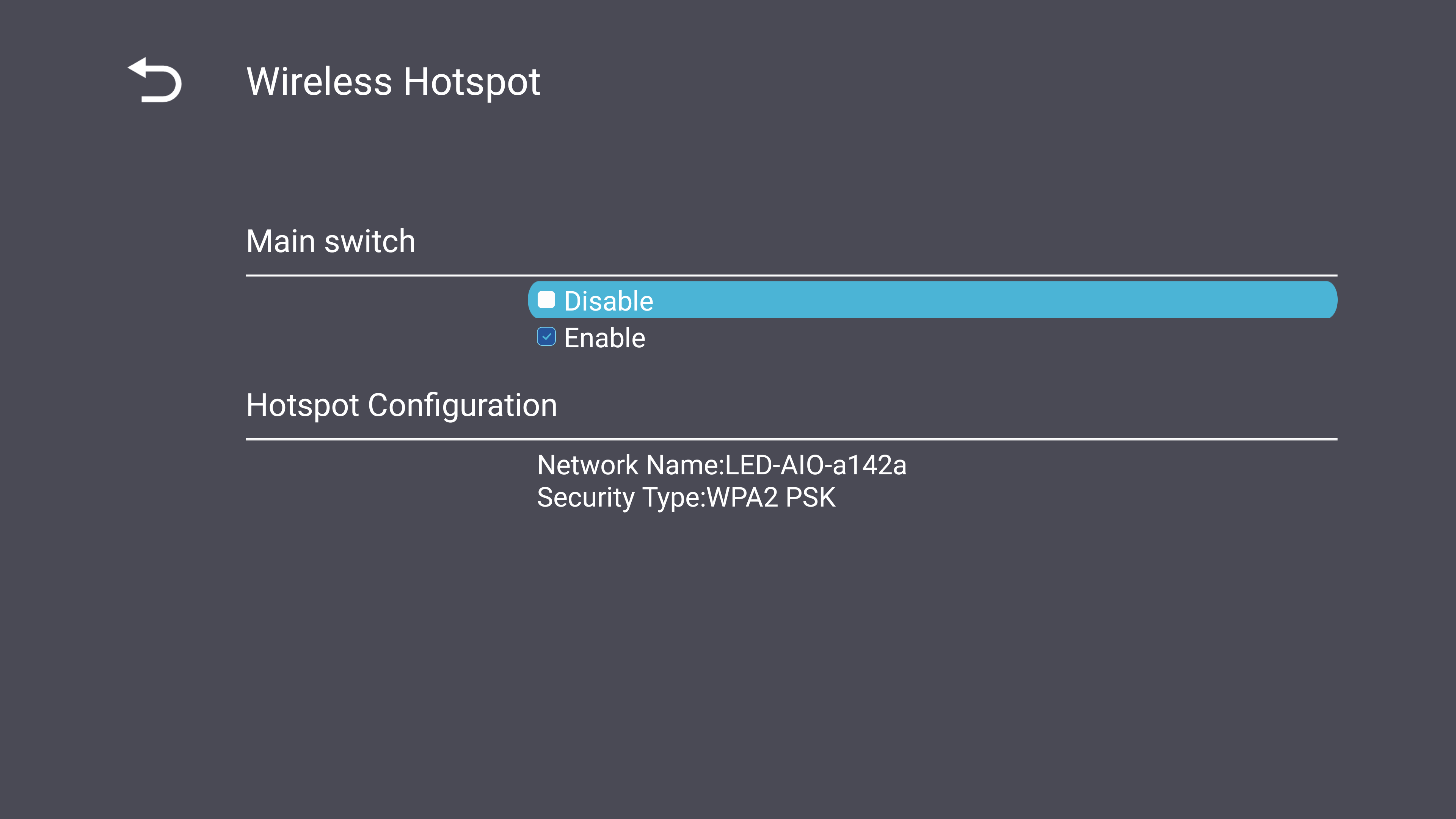
|
| Bluetooth[1]
|
Enable or disable Bluetooth. Once enabled, available devices will be displayed and can be connected to.
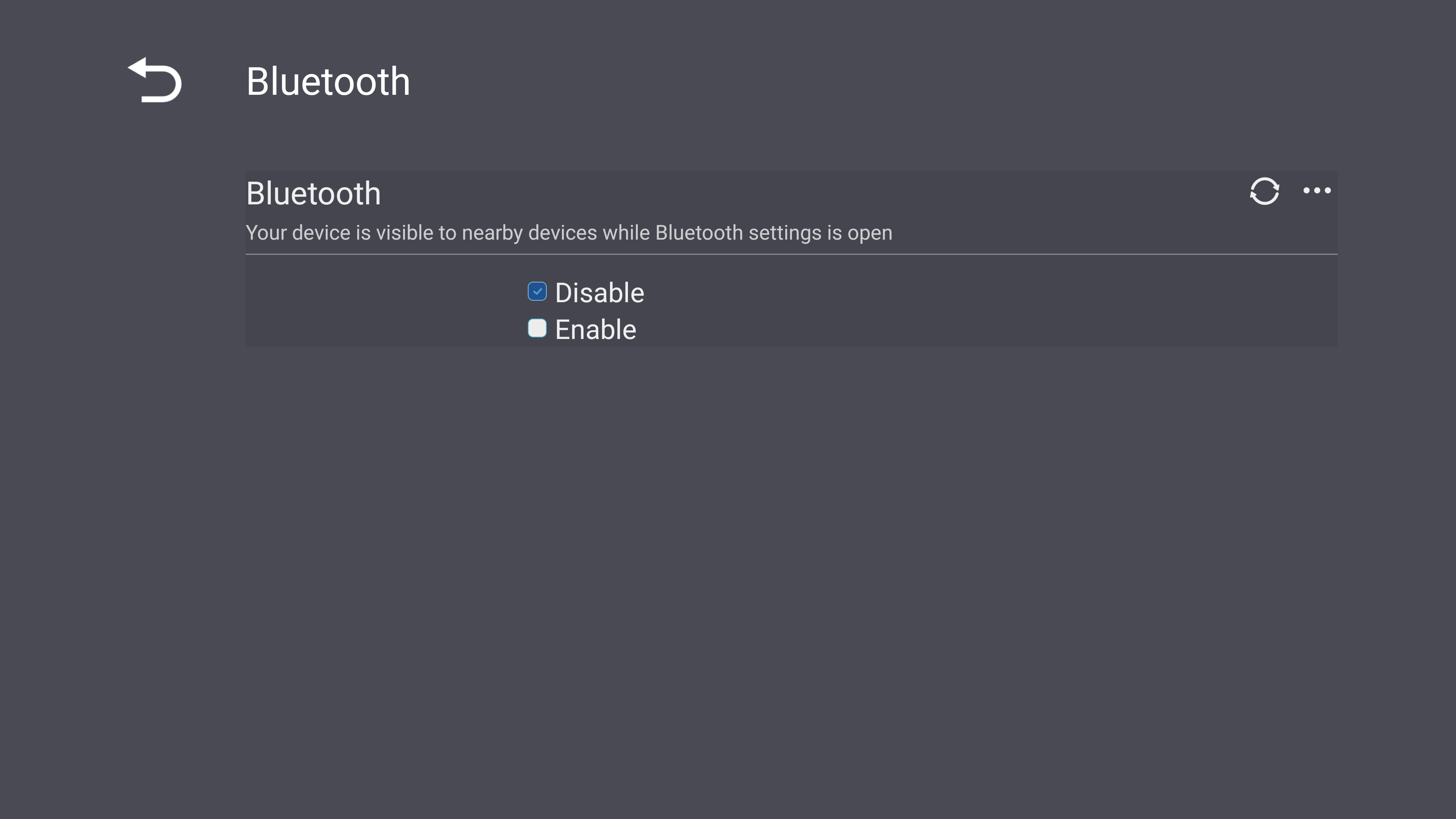
|
| Miracast
|
Enable or disable Miracast.
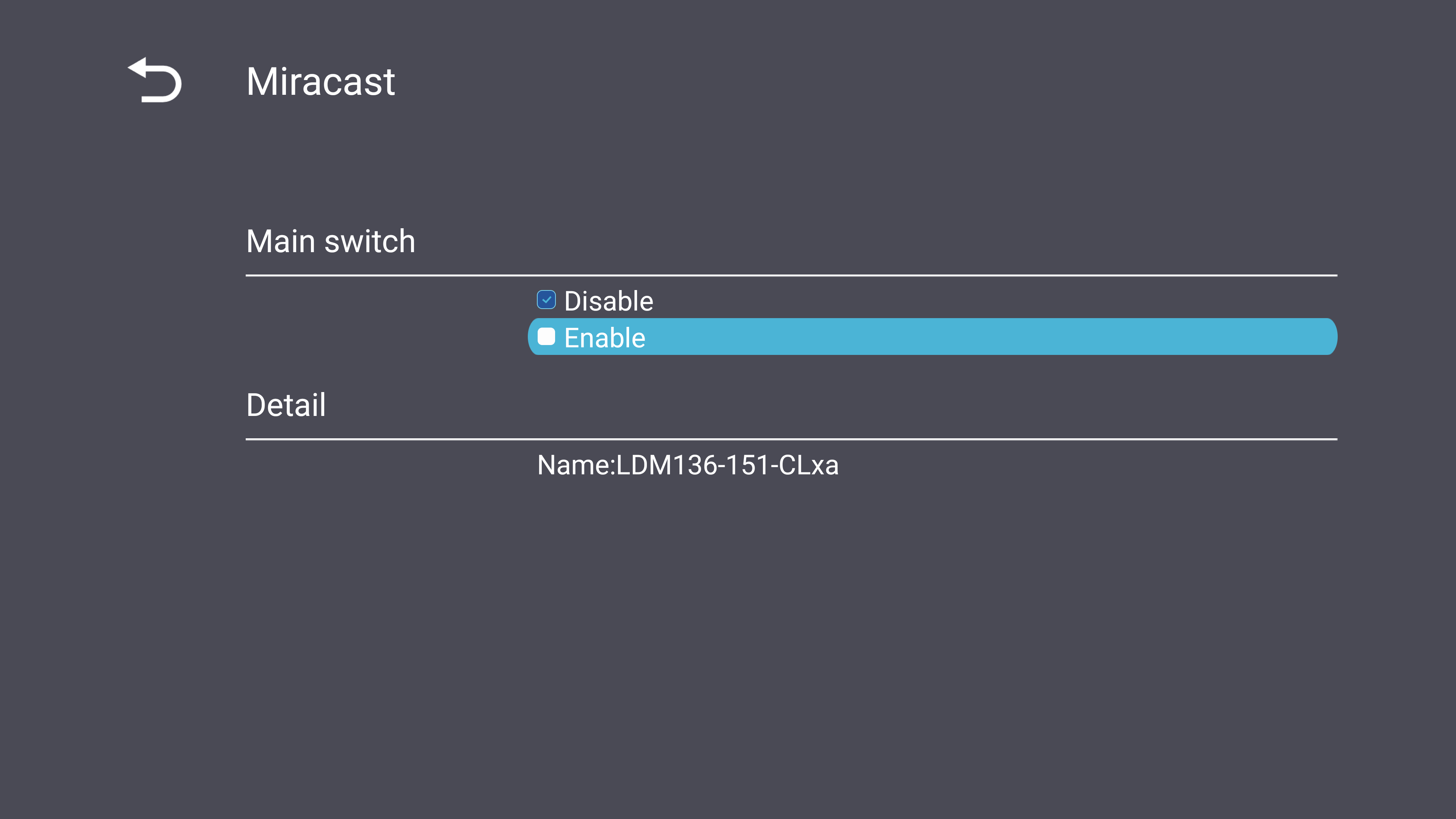
|
Notes
- ↑ The volume of a connected Bluetooth speaker cannot be adjusted with the remote control.
Dehumidification Service
| Sub-menu
|
Menu Option
|
| Dehumidification Settings
|
Set the dehumidification level or shut it down.
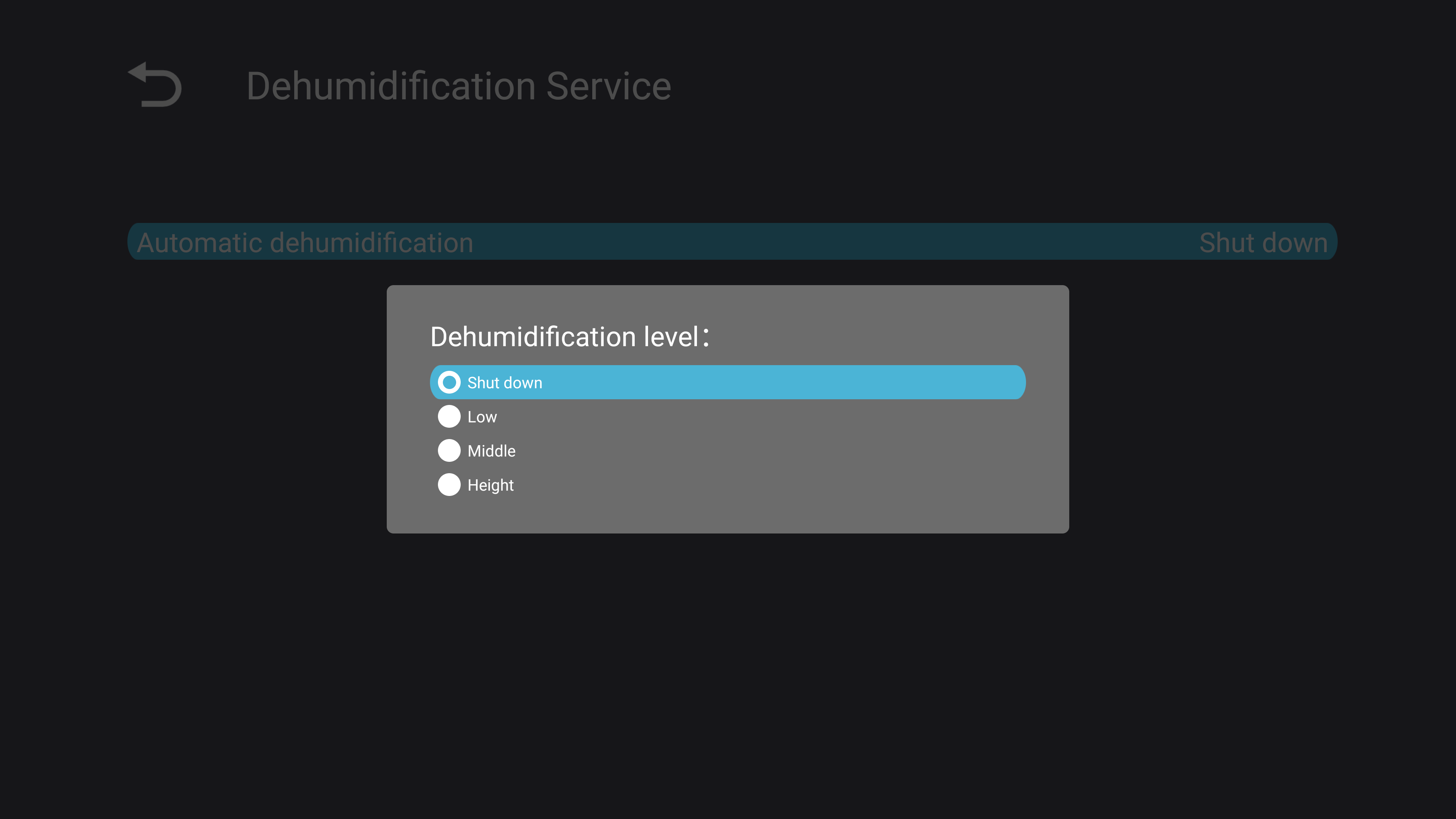
|
| Begin Dehumidification
|
Manually start the dehumidification process
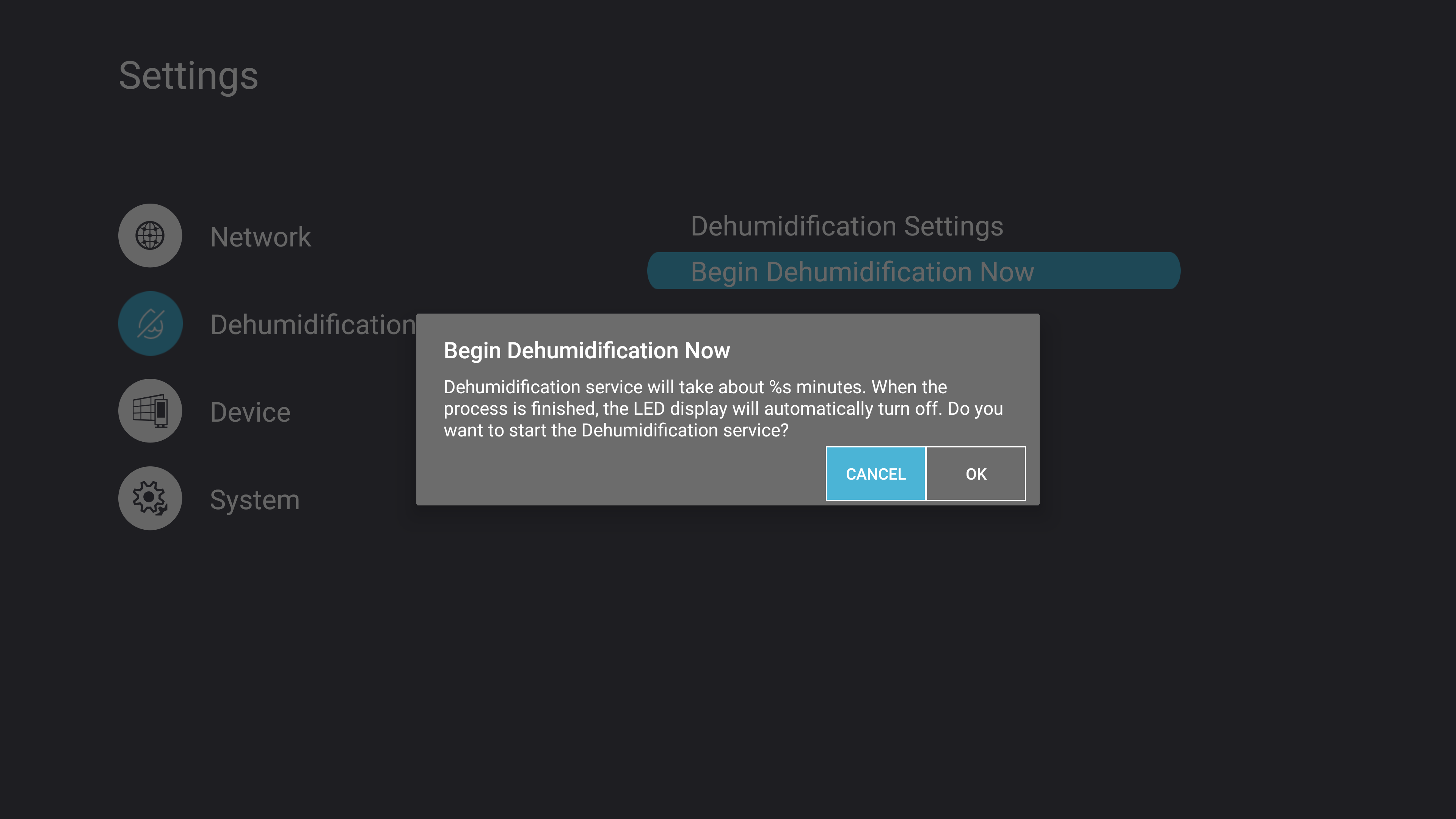
|
Device

| Sub-menu
|
Menu Option
|
| Signage Display
|

General Settings
Set the Signage Display Name and Boot Logo.
Source Settings
Set the application to open when the Custom input source is selected.
Credential Settings
View and clear credentials and install from storage.
Security
Review privacy and copyright protections, allow external USB storage and installing applications from unknown sources.
|
| System Tools
|
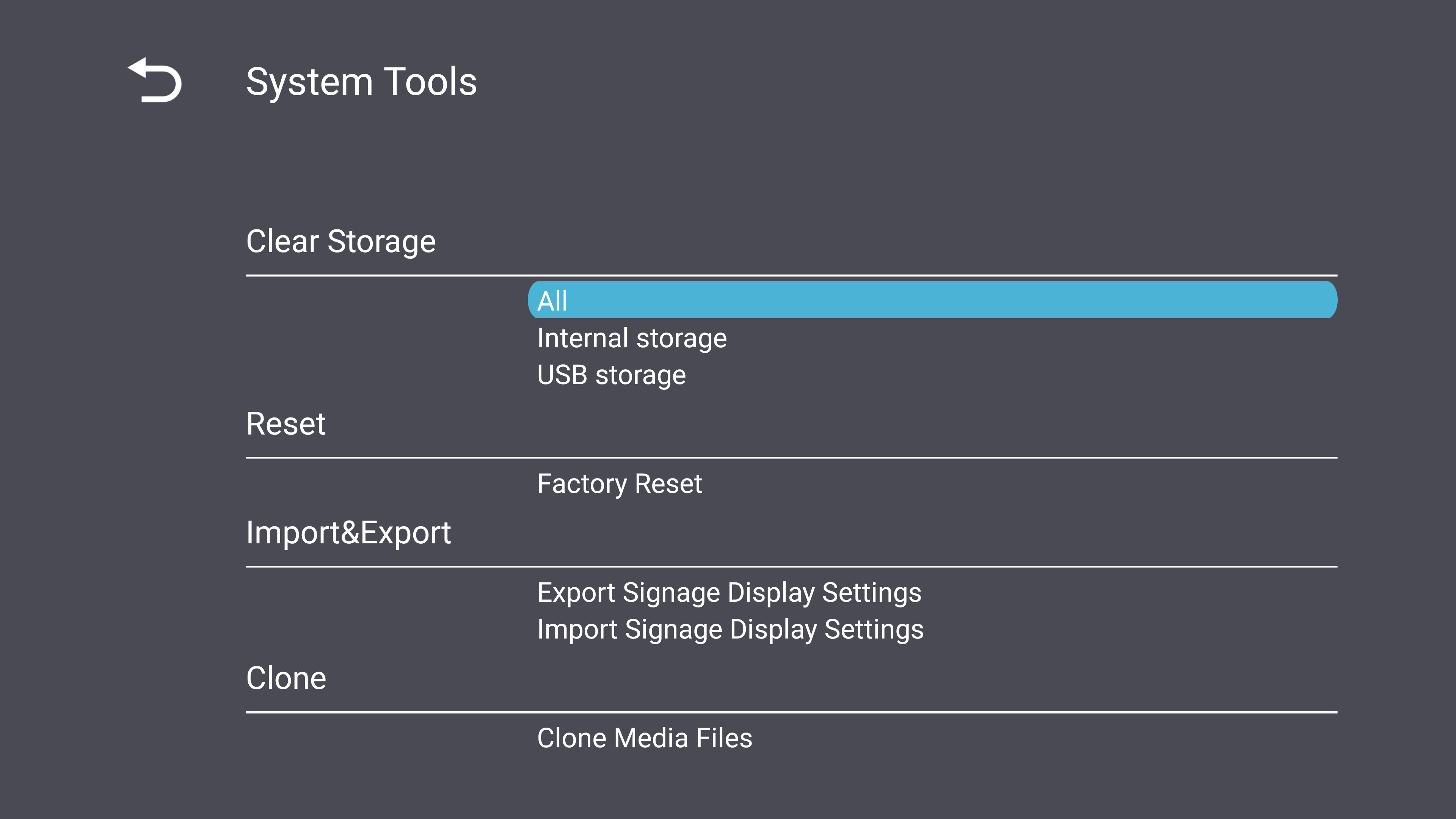
Clear Storage
Clear storage space from both internal and external storage.
Reset
Reset the display to its default factory values.
Import & Export
Import or export the display’s settings.
Clone
Copy media files from the display.
|
| Display
|
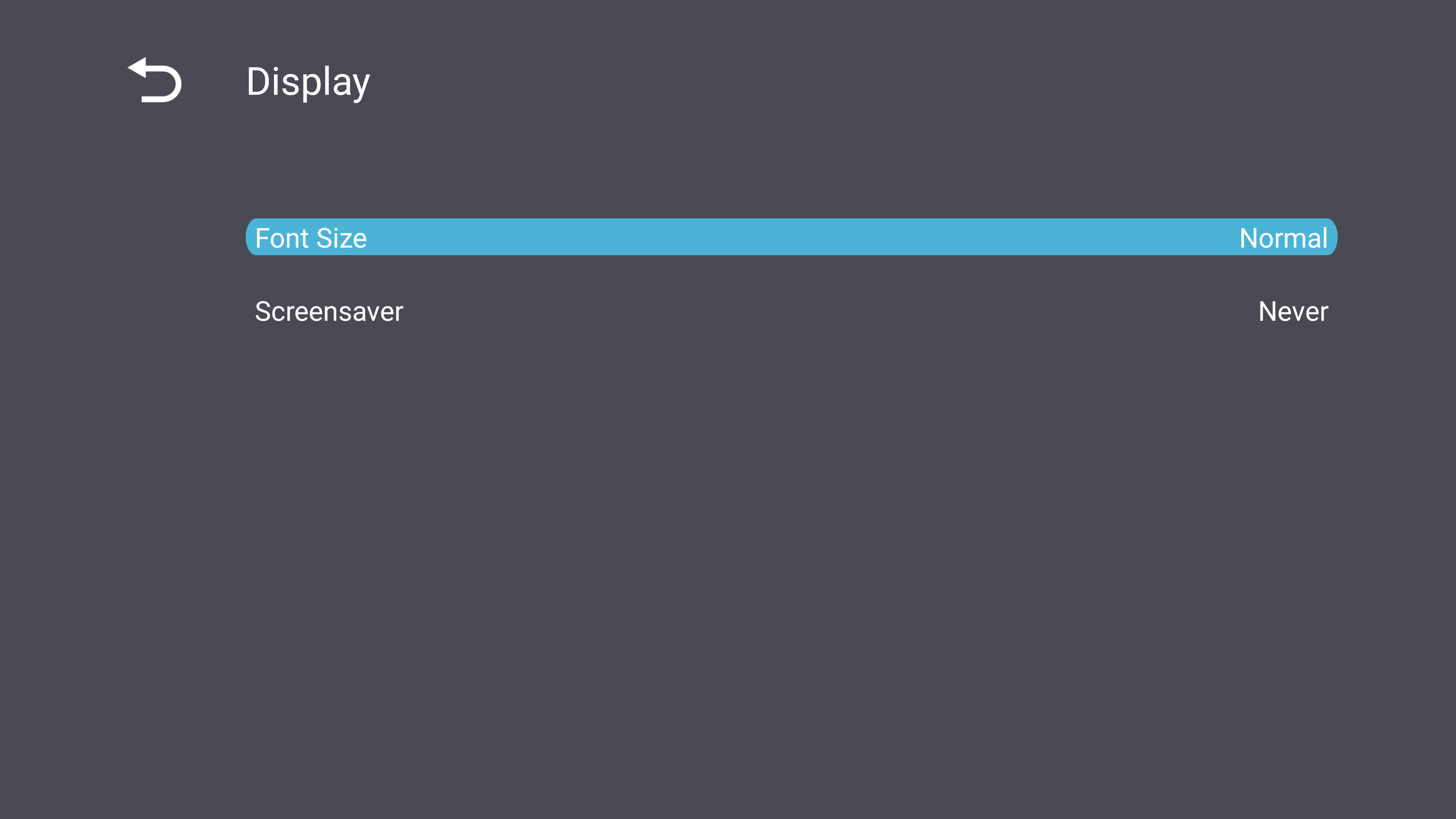
Font Size
Set the font size for the display.
Screensaver
Enable or disable a screensaver.
|
| Apps
|
View information about the display’s running, downloaded, or all applications.
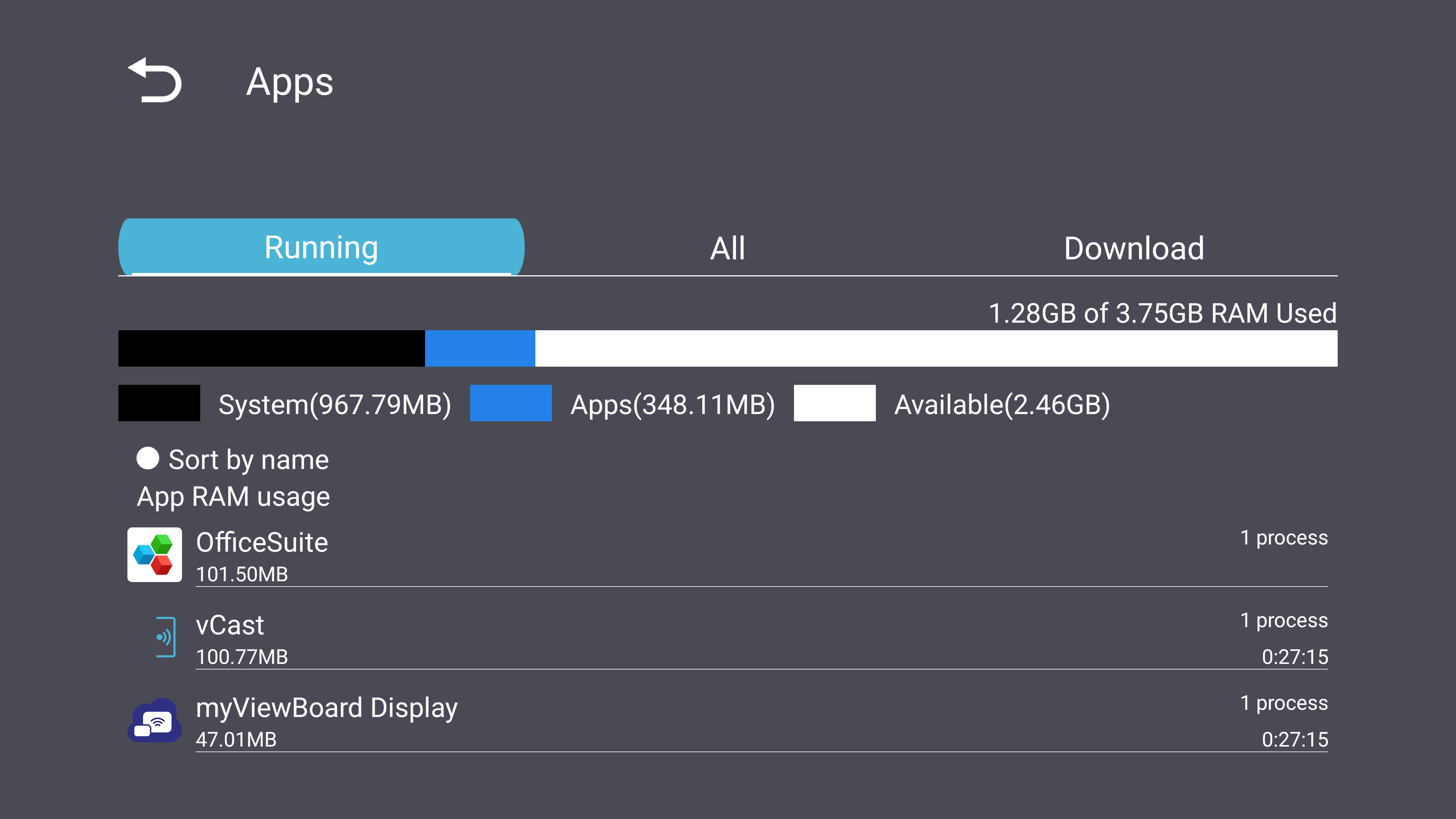
|
| Physical Keyboard
|
View and select a keyboard input method.

|
| Launcher Settings
|
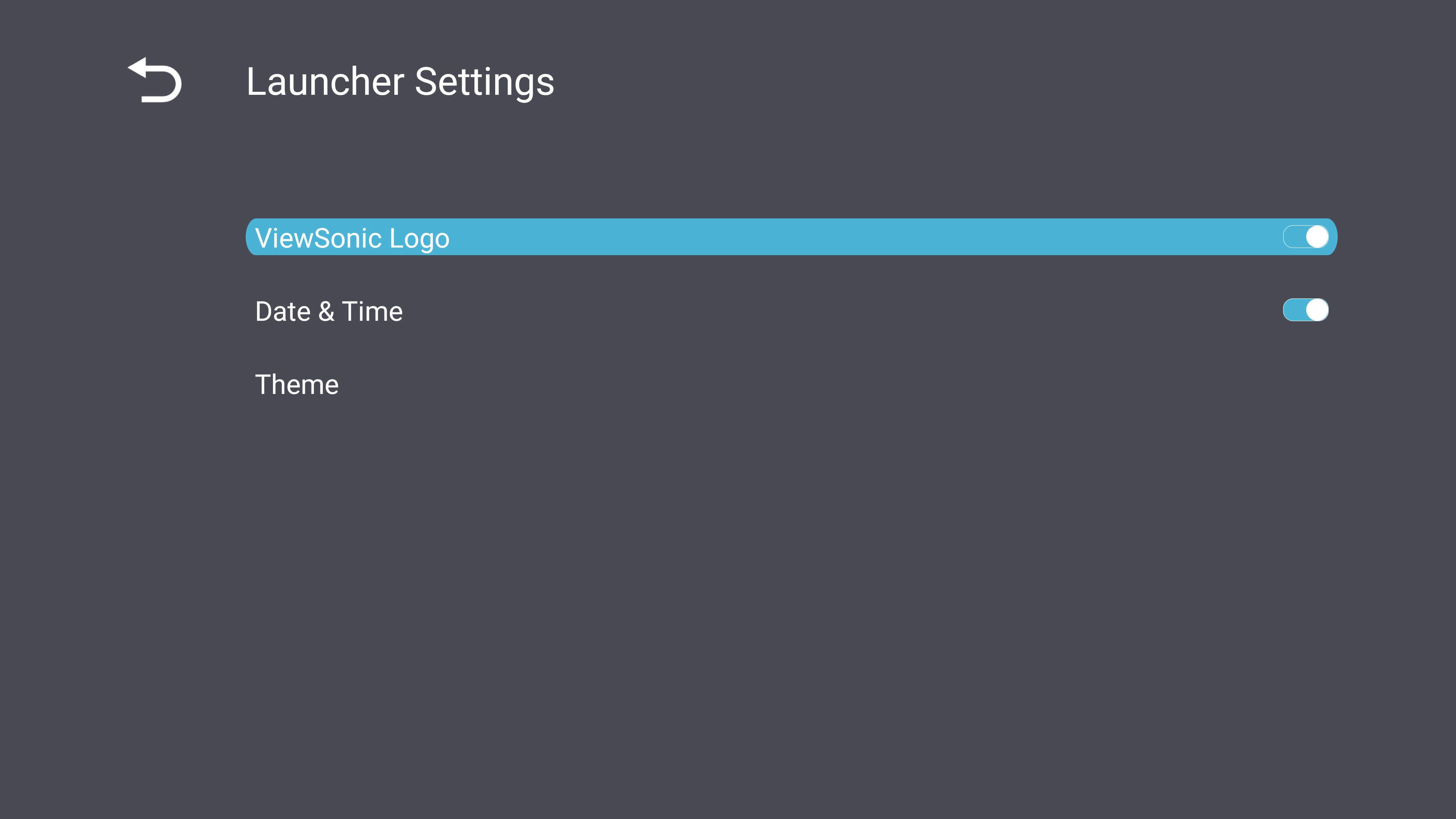
ViewSonic Logo
Display or hide the ViewSonic logo on the Home Screen.
Date & Time
Display or hide the Date & Time on the Home Screen.
Theme
Set the theme for the Home Screen.
|
| Input Method
|
View and select an input method.
|
System
| Sub-menu
|
Menu Option
|
| Date & Time
|
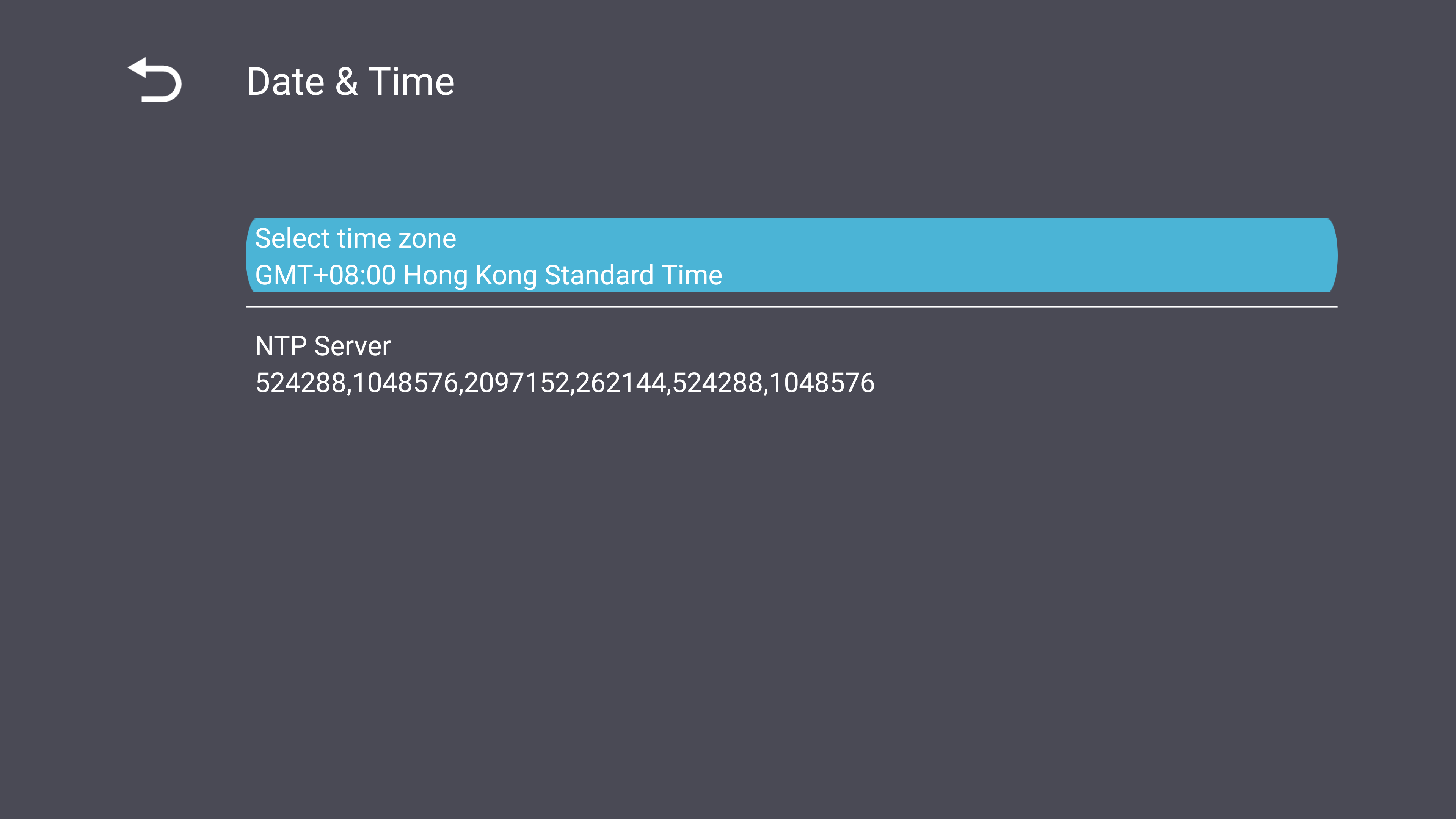
Select Time Zone
Set the display’s time zone.
NTP Server
View NTP service information.
|
| About Device
|
View information about the display and update the system locally or online.
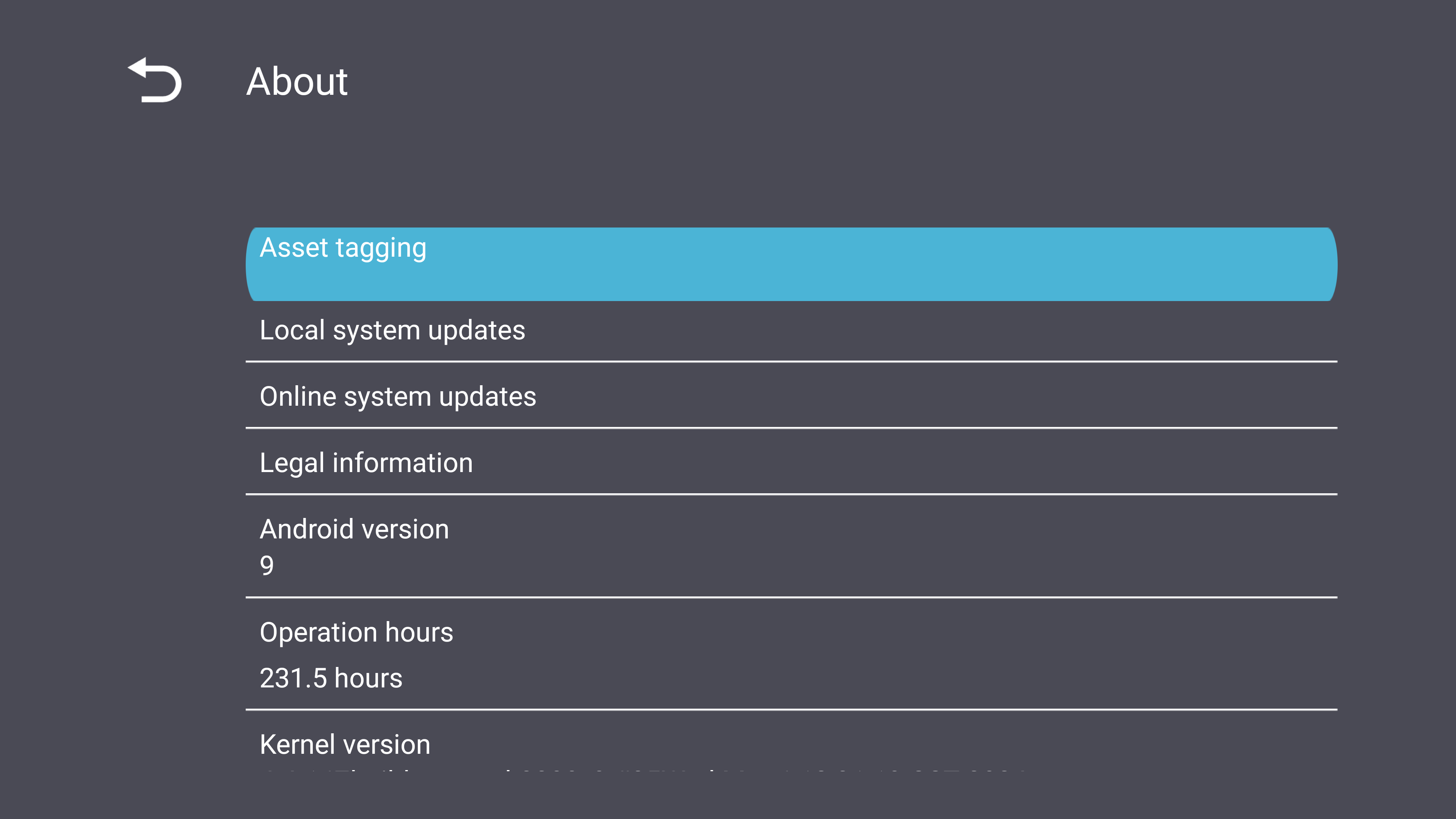
|
Use the On-Screen Display (OSD) Menu to adjust various settings.
Note: The OSD Menu is only available when there is an active input source (e.g., HDMI).
To open and operate the OSD Menu:
- Press the MENU
 button on the remote control.
button on the remote control.
- Press ▼/▲/◄/► on the remote control to select menu items or adjust values.
- Press OK to confirm your selection.
- Press the RETURN
 button to go back to the previous menu level.
button to go back to the previous menu level.
- Press the MENU
 button to exit the OSD Menu.
button to exit the OSD Menu.
| Sub-menu
|
Menu Option
|
| Brightness
|
(-/+, 0~100)
|
| Contrast
|
(-/+, 0~100)
|
| Sharpness
|
(-/+, 0~15)
|
| Tint
|
(-/+, 0~100)
|
| Color
|
(-/+, 0~100)
|
| Color Temperature
|
Warm
|
| Normal
|
| Cool
|
| User
|
| Picture Mode
|
Normal
|
| Dynamic
|
| Soft
|
| User
|
| RGB Range
|
Full Range
|
| Limited Range
|
| Auto
|
| Blue Light Filter
|
(-/+, 0~100)
|
| Gamma Set
|
Native
|
| 2.2
|
| 2.4
|
| Picture Reset
|
Cancel
|
| Reset
|
| Sub-menu
|
Menu Option
|
| Zoom Mode
|
Full
|
| Real
|
| Dynamic
|
| 21:9
|
| Screen Reset
|
Cancle
|
| Reset
|
| Sub-menu
|
Menu Option
|
| PBP Mode
|
Full Screen
|
| Dual Screen
|
| Tree-part Screen
|
| Center Screen
|
| Quad Screen
|
| PBP Source
|
|
| PBP Audio
|
| PBP Reset
|
| Sub-menu
|
Menu Option
|
| PIP Mode
|
Top Left
|
| Top Right
|
| Bottom Left
|
| Bottom Right
|
| PicMain
|
|
| PicSub
|
| PIP Audio
|
| PIP Reset
|
| Sub-menu
|
Menu Option
|
| Treble
|
(-/+, 0~24)
|
| Bass
|
(-/+, 0~24)
|
| Volume
|
(-/+, 0~100)
|
| Maximum Volume
|
(-/+, 0~100)
|
| Minimum Volume
|
(-/+, 0~99)
|
| Mute
|
Off
|
| On
|
| Volume Control
|
Speaker
|
| SPDIF
|
| Headset
|
| Audio Reset
|
Cancel
|
| Reset
|
| Sub-menu
|
Menu Option
|
| Off Time
|
Off
|
| (10 mins~240 mins)
|
| Date and Time
|
Use Network-Provided Time
|
| Set Date Format
|
| Choose Time Zone
|
| Use 24-hour Format
|
| Schedule
|
Schedule List
|
| Enable
|
| Start Time
|
| End Time
|
| Input
|
| Day of the Week
|
| Every Week
|
| Slideshow Interval
|
(1s/3s/5s/10s/15s/20s/25s/30s)
|
| OSD Turn Off
|
Off
|
| (5~120 seconds)
|
| Information OSD
|
Off
|
| (1~60 seconds)
|
| Time Reset
|
Cancel
|
| Reset
|
| Sub-menu
|
Menu Option
|
| Saving
|
Panel Saving
|
Off
|
| On
|
| Power Save
|
Sleep
|
| Hibernate
|
| Light Sensing
|
Off
|
| On
|
| Boot
|
Boot On Source
|
Last Source
|
| Input
|
| Boot On Logo
|
ViewSonic
|
| Blue
|
| Black
|
| Custom
|
| Signal
|
Auto Signal Detection
|
Off
|
| On
|
| No Signal Standby
|
(Off/0 min/5 min/15 min/30 min)
|
| Port
|
HDMI with One Wire
|
Off
|
| On
|
| HDMI Version
|
1.4
|
| 2.0
|
| Auto
|
| USB Cloning
|
Import
|
| Export
|
| USB Auto Play
|
Off
|
| On
|
| Other
|
Switch On State
|
Power Off
|
| Last Status
|
| Forced On
|
| Language
|
English
|
| French
|
| Spanish
|
| German
|
| Russian
|
| Dutch
|
| Traditional Chinese
|
| Simplified Chinese
|
| Turkish
|
| Arabic
|
| Factory Reset
|
Cancel
|
| Reset
|
| Advanced Reset
|
Cancel
|
| Reset
|
| Sub-menu
|
Menu Option
|
| Heat Status
|
xx° C / xx° F
|
| Monitor Information
|
Model Name
|
| Serial No.
|
| Operation Hours
|
| SW Version
|
Picture
- Press the MENU
 button on the remote control to display the OSD Menu.
button on the remote control to display the OSD Menu.
- Then press OK or use ▼ / ▲ / ◄ / ► on the remote control to select the Picture menu.
- Press ▼ / ▲ to select the menu option. Then press OK to display its sub-menu, or press ◄ / ► to adjust/select the setting.
Note: Some sub-menu options may have another sub-menu layer.
| Menu Option
|
Description
|
| Brightness
|
Adjust the background black levels of the screen image.
|
| Contrast
|
- Adjust the degree of difference between the lightest and darkest parts of the picture.
- Changes the amount of black and white in the image.
|
| Sharpness
|
Adjust the on-screen image’s clarity.
|
| Tint
|
Adjust the color balance of the screen image. The higher the value, the more greenish the image becomes. The lower the value, the more reddish the image becomes.
|
| Color
|
Adjust the amount of color in the on-screen image.
|
| Color Temperature
|
Set how color appears on screen using the Kelvin scale.
|
| Picture Mode
|
Select the mode that best fits the display’s environment.
|
| RGB Range
|
Select from the following RGB Ranges.
- Full Range (black and white levels are full [0~255])
- Limited Range (Black and white levels are limited [16~235])
- Auto.
|
| Blue Light Filter
|
Block high-energy blue light for a more comfortable viewing experience.
|
| Gamma Set
|
Manually adjust the brightness level of the monitor’s grayscale levels.
|
| Picture Reset
|
Reset the Picture settings to their default values.
|
Screen
- Press the MENU
 button on the remote control to display the OSD Menu.
button on the remote control to display the OSD Menu.
- Then press OK or use ▼ / ▲ / ◄ / ► on the remote control to select the Screen menu.
- Press ▼ / ▲ to select the menu option. Then press OK to display its sub-menu, or press ◄ / ► to adjust/select the setting.
Note: Some sub-menu options may have another sub-menu layer.
| Menu Option
|
Description
|
| Zoom Mode
|
Set the on-screen image’s width and height.
|
| Screen Reset
|
Reset the Screen settings to their default values.
|
Picture-by-Picture (PBP)
- Press the MENU
 button on the remote control to display the OSD Menu.
button on the remote control to display the OSD Menu.
- Then press OK or use ▼ / ▲ / ◄ / ► on the remote control to select the PBP menu.
- Press ▼ / ▲ to select the menu option. Then press OK to display its sub-menu, or press ◄ / ► to adjust/select the setting.
Note: Some sub-menu options may have another sub-menu layer.
| Menu Option
|
Description
|
| PBP Mode
|
Select the type of PBP screen:
- Full
- Dual
- Three-part
- Center
- Quad
|
| PBP Source
|
Set the video source for the PBP.
|
| PBP Audio
|
Set the audio source for the PBP.
|
| PBP Reset
|
Reset the PBP settings to their default values.
|
Picture-in-Picture (PIP)
- Press the MENU
 button on the remote control to display the OSD Menu.
button on the remote control to display the OSD Menu.
- Then press OK or use ▼ / ▲ / ◄ / ► on the remote control to select the PIP menu.
- Press ▼ / ▲ to select the menu option. Then press OK to display its sub-menu, or press ◄ / ► to adjust/select the setting.
Note: Some sub-menu options may have another sub-menu layer.
| Menu Option
|
Description
|
| PIP Mode
|
Select the location of the PIP screen:
- Top Left
- Top Right
- Bottom Left
- Bottom Right
|
| PicMain
|
Set the video input source of the main screen.
|
| PicSub
|
Set the video input source of the sub-screen.
|
| PIP Audio
|
Set the audio source for the PIP.
|
| PIP Reset
|
Reset the PIP settings to their default values.
|
Audio
- Press the MENU
 button on the remote control to display the OSD Menu.
button on the remote control to display the OSD Menu.
- Then press OK or use ▼ / ▲ / ◄ / ► on the remote control to select the Audio menu.
- Press ▼ / ▲ to select the menu option. Then press OK to display its sub-menu, or press ◄ / ► to adjust/select the setting.
Note: Some sub-menu options may have another sub-menu layer.
| Menu Option
|
Description
|
| Treble
|
Adjust the display’s treble level (higher-pitched sounds).
|
| Bass
|
Adjust the display’s bass level (lower-pitched sounds).
|
| Volume
|
Adjust the display’s sound level.
|
| Maximum Volume
|
Set a maximum sound level.
|
| Minimum Volume
|
Set a minimum sound level.
|
| Mute
|
Turn off the display’s sound.
|
| Volume Control
|
Select the audio source:
- The display’s Speaker
- SPDIF port
- Audio Out port
|
| Audio Reset
|
Reset the Audio settings to their default values.
|
Time
- Press the MENU
 button on the remote control to display the OSD Menu.
button on the remote control to display the OSD Menu.
- Then press OK or use ▼ / ▲ / ◄ / ► on the remote control to select the Time menu.
- Press ▼ / ▲ to select the menu option. Then press OK to display its sub-menu, or press ◄ / ► to adjust/select the setting.
Note: Some sub-menu options may have another sub-menu layer.
| Menu Option
|
Description
|
| Off Time
|
Set a time for the display to turn off.
|
| Date and Time
|
Set the date and time of the display.
|
| Schedule
|
Set a schedule to turn the display on and off.
|
| Slideshow Interval
|
Set the time interval to change between images for a photo slide show.
|
| OSD Turn Off
|
Set the length of time the OSD Menu remains on screen.
|
| OSD Information
|
Set the length of time that the Volume, Brightness, and Input Source menus remain on screen.
|
| Time Reset
|
Reset the Time settings to their default values.
|
| Audio Reset
|
Reset the Audio settings to their default values.
|
Advanced
- Press the MENU
 button on the remote control to display the OSD Menu.
button on the remote control to display the OSD Menu.
- Then press OK or use ▼ / ▲ / ◄ / ► on the remote control to select the Advanced menu.
- Press ▼ / ▲ to select the menu option. Then press OK to display its sub-menu, or press ◄ / ► to adjust/select the setting.
Note: Some sub-menu options may have another sub-menu layer.
| Menu Option
|
Description
|
| Saving
|
Panel Saving
Reduces the risk of image burn-in when enabled.
|
Power Save
Reduce power consumption.
| Option
|
Description
|
| Sleep
|
Power usage is 38W. LAN control can still be used in this mode
|
| Hibernate
|
Power usage is < 0.5W.
|
|
| Boot
|
Boot On Source
Select the input source to enter automatically after the display is turned on.
|
Boot On Logo
Show or hide a logo when the display is turned on.
|
| Port
|
HDMI with One Wire
Enable or disable CEC (Consumer Electronics Control).
CEC synchronizes power on/off operation via HDMI connection. That is, if a device that also supports CEC is connected to the HDMI input of the display, when the display’s power is turned off, the power of the connected device will also be turned off automatically. Conversely, when the power of the connected device is turned on, the display’s power will be turned on automatically.
|
| USB Cloning
Save the OSD Menu configuration to a USB storage device.
|
| HDMI Version
Select the HDMI version.
|
| USB Auto Play[1]
If enabled, the display will copy media files from a connected external USB storage device to the display’s internal storage and play the media files automatically.
|
| Other
|
Switch On State
Select the display status for the next time the power cord is connected to a power outlet:
- Power Off: The display will remain off.
- Last Status: The display will return to the previous power status.
- Forced On: The display will turn on.
|
Language
Set the language for the OSD Menu.
|
Factory Reset
Reset all OSD Menu settings to their default values.
|
Advanced Reset
Reset the Advanced settings to their default values.
|
Notes
- ↑ If power is lost during the file transfer, please remove the files from the internal storage and try again.
About
- Press the MENU
 button on the remote control to display the OSD Menu.
button on the remote control to display the OSD Menu.
- Then press OK or use ▼ / ▲ / ◄ / ► on the remote control to select the About menu.
- Press ▼ / ▲ to select the menu option. Then press OK to display its sub-menu, or press ◄ / ► to adjust/select the setting.
Note: Some sub-menu options may have another sub-menu layer.
| Menu Option
|
Description
|
| Heat Status
|
View the maximum temperature of the display
|
| Monitor Information
|
View information about the display such as: Model Name, Serial Number, Operation Hours, and Software Version.
|
vCast
Working with ViewSonic® Cast software (vCast, vCast Pro, and vCastSender), the vCast application will allow the display to receive laptop screens (Windows/Mac/Chrome) and mobile (iOS/Android) users’ screens, photos, videos, annotations, and camera(s) that are using the vCastSender application.
Network Information
- ViewSonic® Cast software, laptops, and mobile devices can connect to both the same subnet and cross subnet by entering the on-screen PIN code.
- Connected devices will show up under Device List on the same subnet connection.
- If the device does not show up under Device List, users will need to key-in the on-screen PIN code.
- Ports:
- TCP 56789, 25123, 8121 & 8000 (Controlling message port & client device audio transfer)
- TCP 8600 (BYOM)
- TCP 53000 (Request share screen)
- TCP 52020 (Reverse control)
- TCP 52025 (Reverse control for the ViewBoard Cast Button only)
- TCP 52030 (Status sync)
- UDP 48689, 25123 (Device searching and broadcast & client device audio transfer)
- UDP 5353 (Multicast search device protocol)
- Port: 443
- DNS: https://vcastactivate.viewsonic.com
- Server Port: TCP443
- Server FQDN Name: https://vcastupdate.viewsonic.com
Display Group Settings
To adjust the Display Group Settings, select the Display Group icon  located in the lower-right corner of the screen.
located in the lower-right corner of the screen.
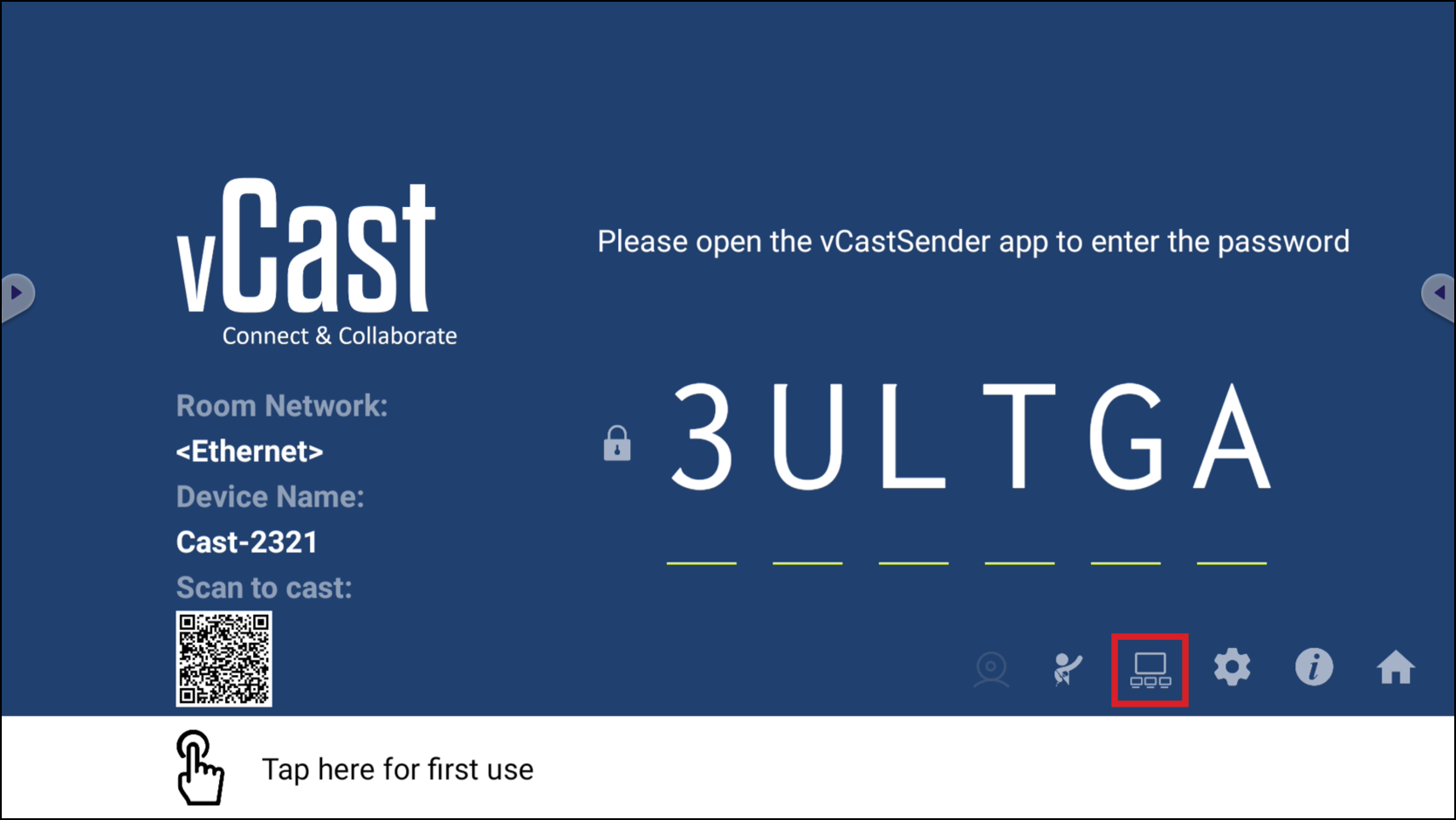
- Toggle the “Turn On/Off Display Group” ON to enable the Display Group feature.
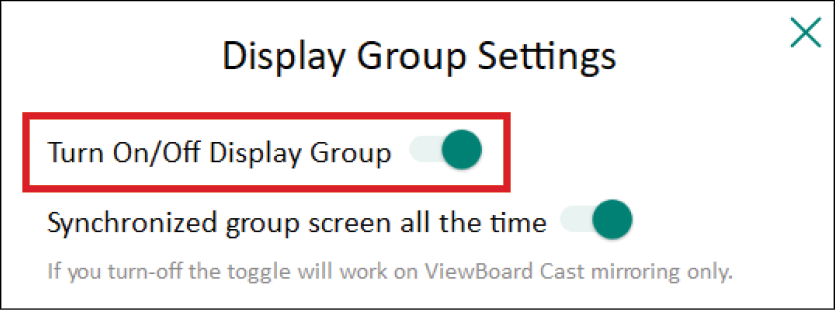
Note: Other preinstalled-vCast devices in the same network will be listed.
- Select the devices you want to join the display group and select OK to save the settings.
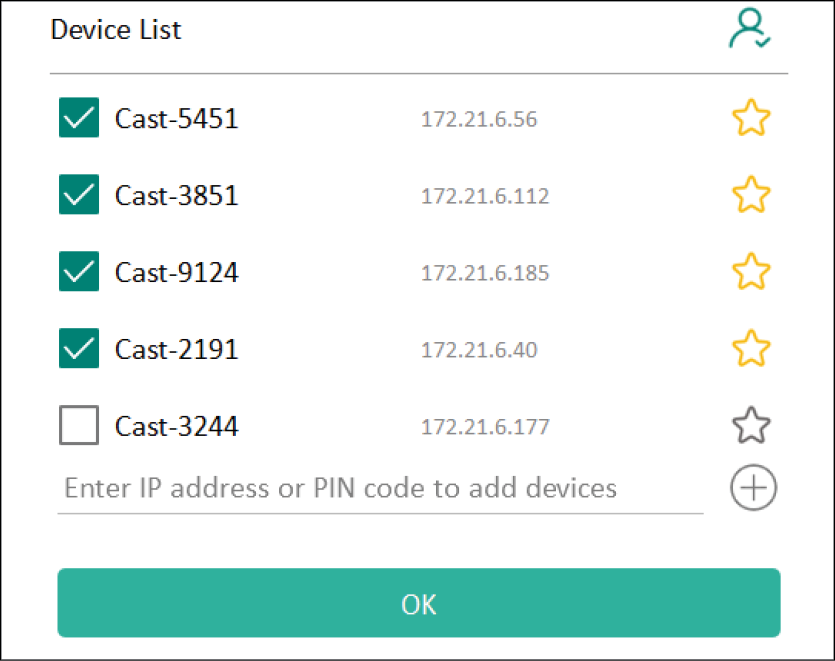
Note:
- If the devices you want to group are not listed, you can enter their respective IP address or connecting PIN code.
- The Display Group maximum device limit is six devices.
- If you frequently connect to the same device, you can select the Star icon next to the device to add it to your frequently connected devices list, “My List of Devices in Group”, for easier Display Group setup and management.
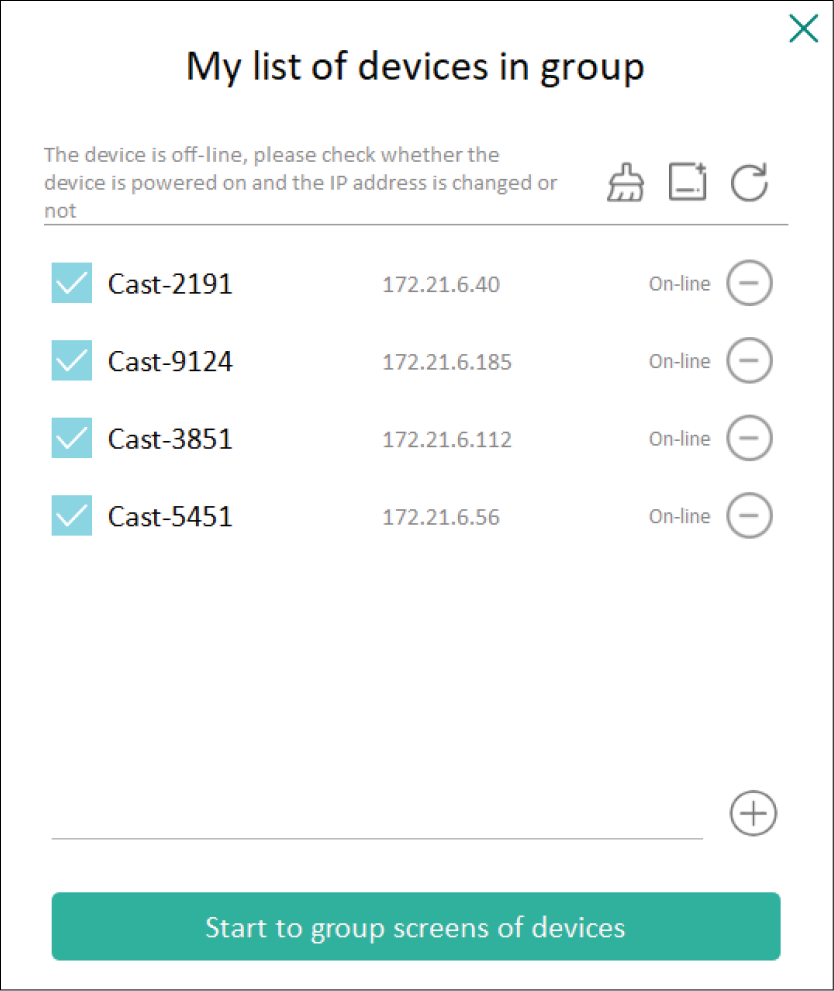
Synchronized Group Screen All the Time
When the “Synchronized group screen all the time” function is toggled ON, it will display a synchronized group screen continuously. If it is toggled OFF, it will work on vCast mirroring only.

Note: Select the devices to group first, then toggle the “Synchronized group screen all the time” function ON to avoid interruption.
Share a Screen to the Display Group (One to Many Casting)
After confirming the above settings, you can share your screen to the main display, then the grouped client devices will be synced up to your screen.
Moderator Mode
Moderator Mode allows the moderator to take control of the devices connected to the display. To enter Moderator Mode, select the Moderator Mode icon  located in the lower-right corner of the screen.
located in the lower-right corner of the screen.
When enabled, the moderator can view a list of all connected screens in the left floating window and can preview each participant’s screen and then select any of participant’s screen and cast to the display's main screen for presentation. The moderator can also control each participant’s screen, annotate on the display, and remove unwanted participants by selecting the close icon .
Broadcast
When enabled, the display's screen will be broadcasted to all of the participant’s connected screens simultaneously. The participants can only view the presentation contents until the moderator disables the Broadcast function.
Multiple Screen Sharing
By default, vCast is set to allow multiple screen sharing, but can also be set to single screen sharing. To do this, the moderator can select the Multiple Screen Sharing icon to switch to single screen sharing.
Preview Screen
By default, vCast is set to let the moderator preview the participant’s screen contents prior to sharing to the display. Selecting the Preview Screen icon, the Moderator can switch to see the participant’s name only.
Touch
By default, participants can use touch for collaboration after connecting. The moderator can enable/disable the touch function of a participant by selecting the Touch icon in their window.
Note:
- Moderator Mode is supported on all vCastSender and AirPlay devices, but mobile devices are limited to a "preview" function. Additionally, mobile Android devices cannot cast sound out.
- When you cast your Windows/Mac/Chrome screen to a display, the selected full screen unit will not be broadcasted back to your device to avoid repetitive screen casting.
- The active presenter can touch each of the participant's screens to remotely control casting devices.
- The number of multi-screen presenters on-screen depends on your Windows CPU processor performance and router specifications.
Casting from Windows, MacBook, and Chrome Devices
- Ensure the client device (e.g., laptop) is connected to the same network as the display.
Note: The network name can be found under
Room Network.
- On the client device, visit the address that is shown on the display to download and install the vCastSender application.
- After installing, launch the vCastSender application.
- To connect to the display, input the PIN code and click OK.
Note: The
PIN code can be found as highlighted below:
- Additionally, you can connect to the display by clicking Device List then the Device Name listed.
Note: The
Device Name can be found as highlighted below:
Casting from Android Devices
- Ensure the client device (e.g., Android phone or tablet) is connected to the same network as the display.
Note: The network name can be found under
Room Network.
- On the Android client device, scan the QR code shown on the display to directly download the vCastSender application, or download the application from the Google Play Store.
- After installing, launch the vCastSender application.
- To connect to the display, input the PIN code and select OK.
Note: The
PIN code can be found as highlighted below:
- You can also connect to the display by clicking Device List then the Device Name listed.
Note: The
Device Name can be found as highlighted below:
- Additionally, you can connect to the display by selecting Scan then placing the on-screen QR code into the box to automatically connect.
Casting from Apple iOS Devices
Apple AirPlay® is compatible with vCast for screen mirroring and content streaming under the same subnet environment only. An “AirPlay Password” will be generated on-screen for connection when using AirPlay to cast to a display.
- Ensure the client device (e.g., iPhone or iPad) is connected to the same network as the display.
Note: The network name can be found under
Room Network.
- On the iOS client device, directly open AirPlay and select the Device Name of the display to connect.
Note: The
Device Name can be found as highlighted below:
- Input the generated on-screen AirPlay Password on the client device to connect.
Note: In a cross subnet environment, please download and connect with the vCastSender iOS application from the the Apple App Store.
- You can also connect to the display by selecting Scan then placing the on-screen QR code into the box to automatically connect.
Connecting to a Display from Mobile Device
Once connected, select Receive. The selected display screen will appear on the mobile device with an on-screen toolbar. Users can interact with the display with annotations, file sharing, etc.
| Item
|
Description
|
|
|
Toggle
|
Hide or display the toolbar.
|
|
|
Home
|
Return to the Home interface.
|
|
|
Return
|
Return to the previous operation.
|
|
|
Folder
|
View or open the mobile device's files.
|
|
|
Share
|
Cast the mobile device's screen to the connected display.
|
|
|
Touch
|
Remotely control the connected display.
|
|
|
Annotate
|
Make annotations, and adjust the pen color.
|
|
|
Clear
|
Clear everything on screen.
|
|
|
Camera
|
Send camera images to the connected display.
|
Casting with Chromecast
vCast supports native Chromecast screen sharing via the Chrome browser casting when the Chromecast feature is enabled.
Note: Chromecast does not support password protection or multiple-screen casting.
- Ensure the client device (e.g., laptop) is connected to the same network as the display.
Note: The network name can be found under
Room Network.
- Ensure the Chromecast Enable checkbox is selected in the vCast settings.
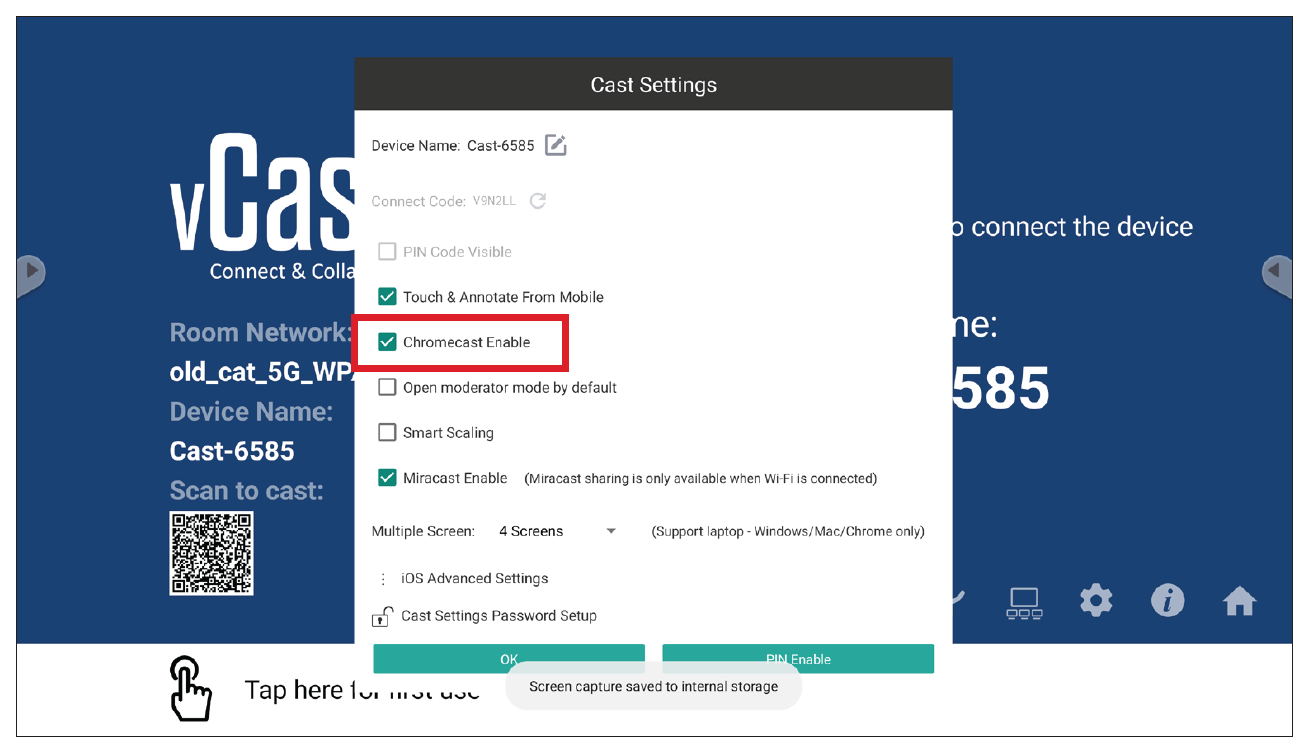
- In the Chrome browser, go to: Settings > Save and share > Cast... > Select the screen to cast to.
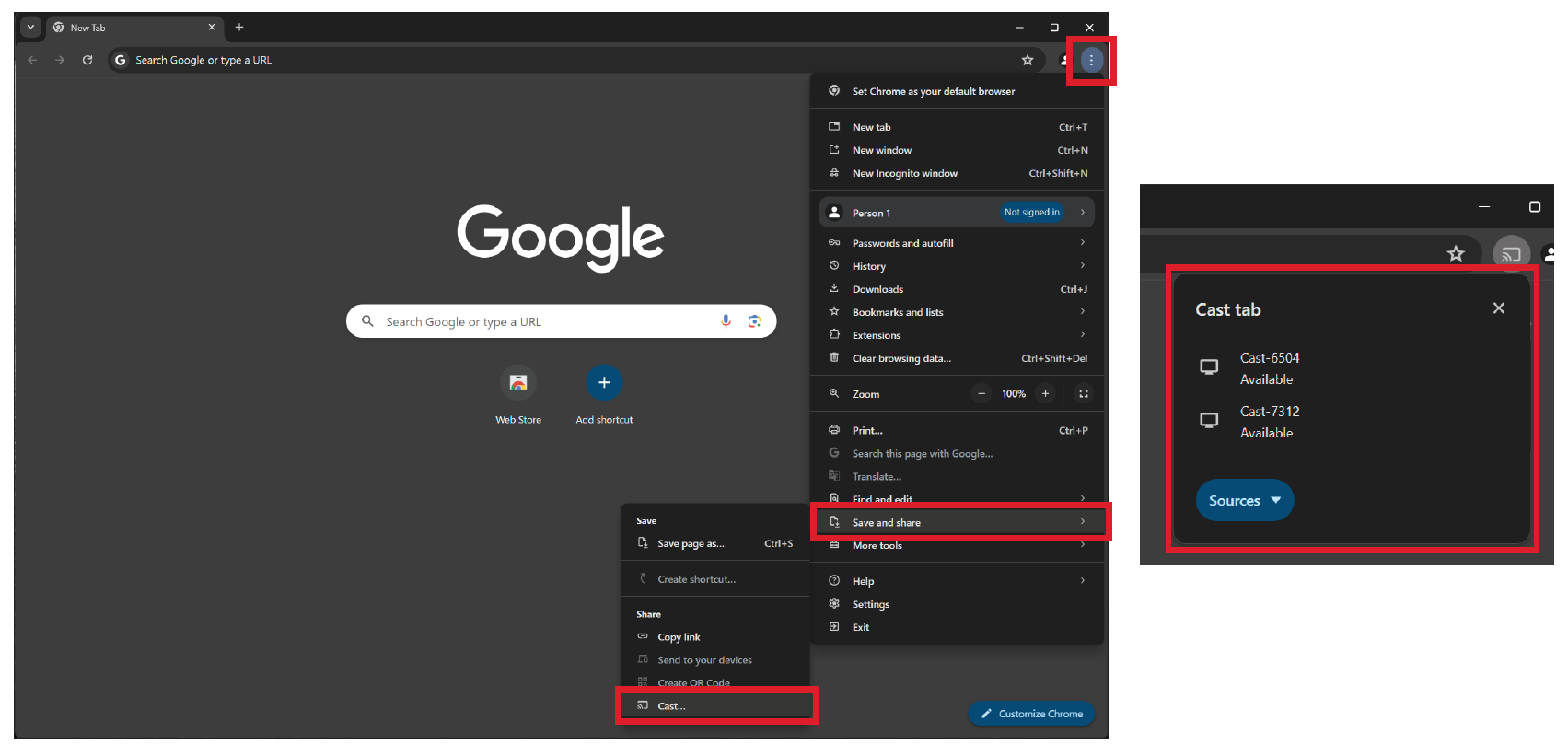
Casting with Miracast
vCast supports native Miracast to cast content from Windows and Android devices to a display when the Miracast feature is enabled.
Note:
- Miracast does not support password protection or multiple-screen casting.
- Miracast sharing is only available over Wi-Fi.
- Miracast will automatically turn off after being idle for one hour.
- Ensure the client device (e.g., laptop) is connected to the same network as the display.
Note: The network name can be found under
Room Network.
- Ensure the Miracast Enable checkbox is selected in the vCast settings.
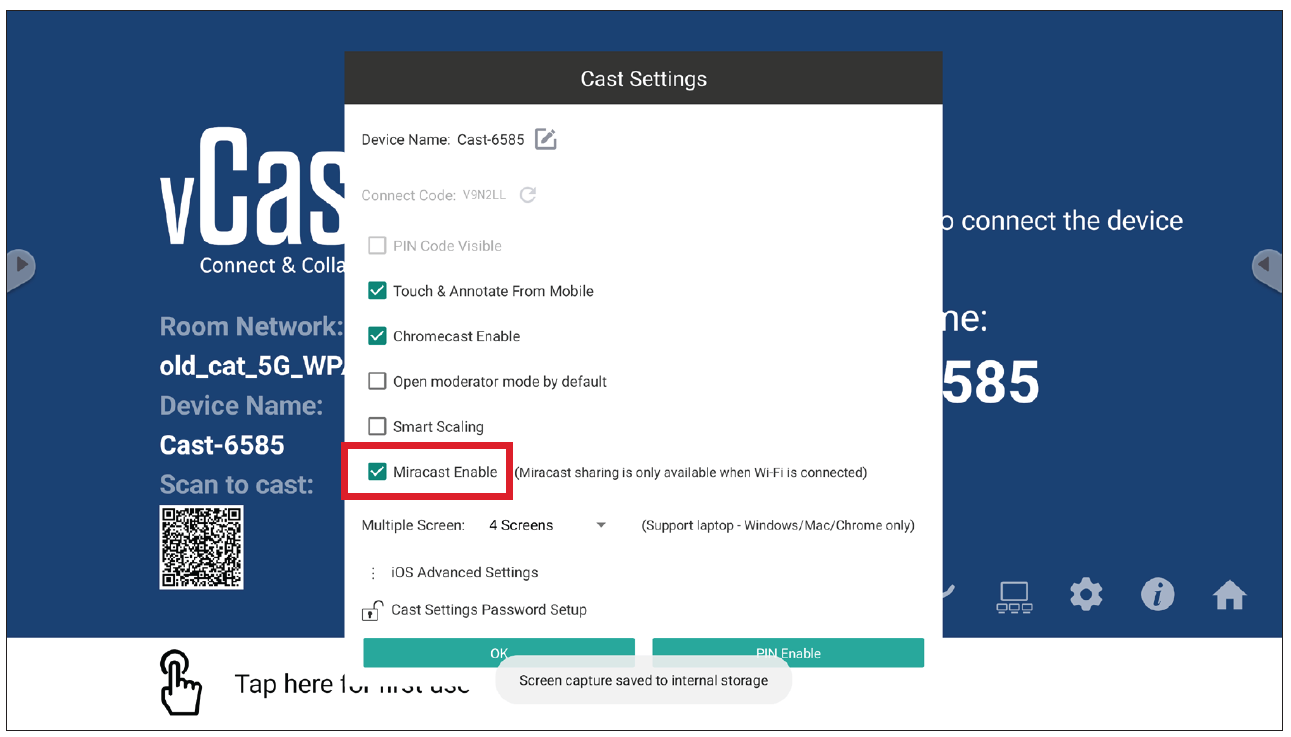
- Please follow the below steps to cast:
For Windows devices:
- On the Windows device, press Win + K and select the display to cast to.
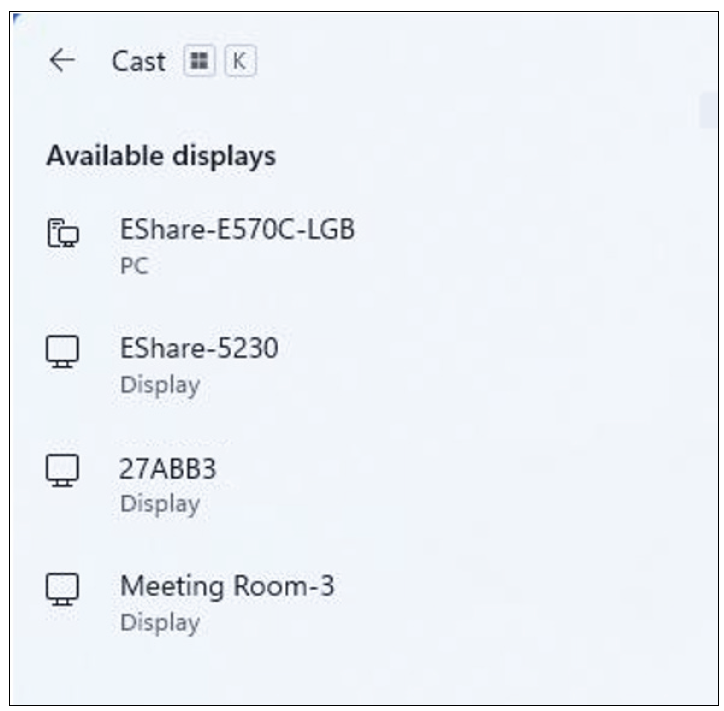
- Select the checkbox “Allow mouse, keyboard, touch, and pen input from the device” to enable the touch feedback feature.
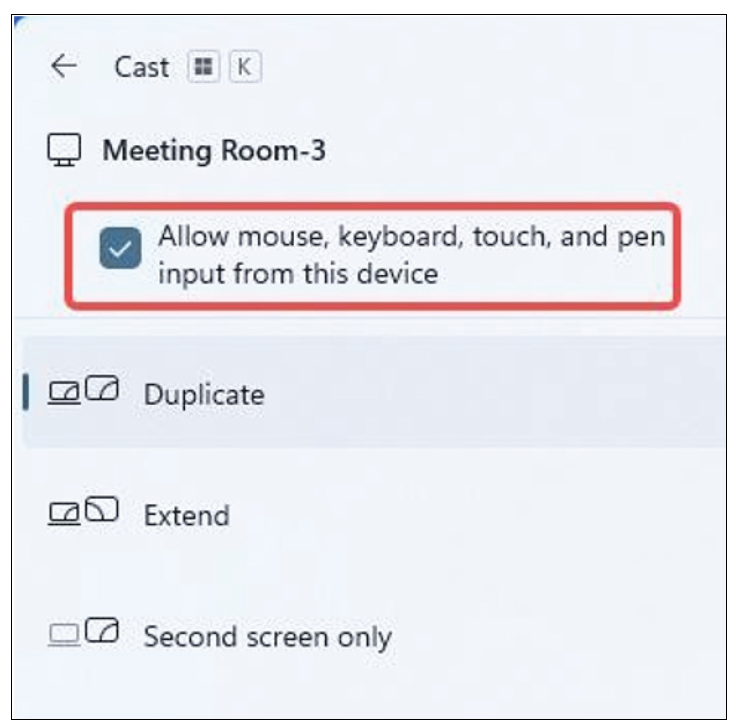
For Android devices:
On the Android device, directly select Cast/Smart View/Wireless Projection then select the display to cast to.
Other Default Applications
Browser
Web browser for surfing the internet.
Office Suite
Create, edit, and view Documents, Spreadsheets, Presentations, and PDFs.
vSweeper
Clear unnecessary data and unwanted files.
Advanced Settings can also be customized to the user's needs.
RS-232
This document describes the hardware interface and software protocols of RS-232 interface communication between the ViewSonic LED Display and computers or other control units with RS-232 protocol.
Hardware Specification
ViewSonic RS-232 serial port on the lower left side:
- Connector type: DB 9-Pin Female
- Use of straight-through parallel cable for connection
- Pin Assignment:
|
|
Pin #
|
Signal
|
Remark
|
| Female DB 9-Pin
|
1
|
NC
|
|
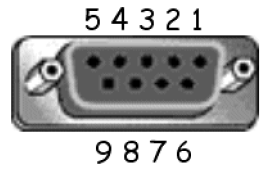
|
2
|
TXD
|
Output from Display
|
| 3
|
RXD
|
Input to Display
|
| 4
|
NC
|
|
| 5
|
GND
|
GND
|
| 6
|
NC
|
|
| 7
|
NC
|
| 8
|
NC
|
| 9
|
NC
|
| frame
|
GND
|
Communication Setting
| Baud Rate Select: |
115200bps (fixed)
|
| Data Bits: |
8 bits (fixed)
|
| Parity: |
None (fixed)
|
| Stop Bits: |
1 (fixed)
|
Note: Make sure the Control Board Switch is switched to the left for RS-232 control.
Command Table
| Function
|
Command Code
(Hex)
|
HEX
|
Data Range
|
| Power on/off(standby):STBY |
21 |
38 30 31 73 21 30 30 30 0D |
|
| Power on/off(standby):ON |
21 |
38 30 31 73 21 30 30 31 0D |
|
| Input Select:USB auto play |
22 |
38 30 31 73 22 30 30 33 0D |
|
| Input Select:HDMI1 |
22 |
38 30 31 73 22 30 30 34 0D |
|
| Input Select:HDMI2 |
22 |
38 30 31 73 22 30 31 34 0D |
|
| Input Select:HDMI3 |
22 |
38 30 31 73 22 30 32 34 0D |
|
| Input Select:HDMI4 |
22 |
38 30 31 73 22 30 33 34 0D |
|
| Brightness |
24 |
38 30 31 73 24 3X 3X 3X 0D |
000-100
|
| Brightness:Bright down (-1) |
24 |
38 30 31 73 24 39 30 30 0D |
|
| Brightness:Bright up (+1) |
24 |
38 30 31 73 24 39 30 31 0D |
|
| Power lock:Unlock |
34 |
38 30 31 73 34 30 30 30 0D |
|
| Power lock:Lock |
34 |
38 30 31 73 34 30 30 31 0D |
|
| Volume |
35 |
38 30 31 73 35 3X 3X 3X 0D |
000-100
|
| Volume:Volume down(-1) |
35 |
38 30 31 73 35 39 30 30 0D |
|
| Volume:Volume up(+1) |
35 |
38 30 31 73 35 39 30 31 0D |
|
| Mute:OFF |
36 |
38 30 31 73 36 30 30 30 0D |
|
| Mute:ON |
36 |
38 30 31 73 36 30 30 31 0D |
|
| Button lock:Unlock |
38 |
38 30 31 73 38 30 30 30 0D |
|
| Button lock:Lock |
38 |
38 30 31 73 38 30 30 31 0D |
|
| Menu lock:Unlock |
3E |
38 30 31 73 3E 30 30 30 0D |
|
| Menu lock:Lock |
3E |
38 30 31 73 3E 30 30 31 0D |
|
| Key Pad:UP |
41 |
38 30 31 73 41 30 30 30 0D |
|
| Key Pad:DOWN |
41 |
38 30 31 73 41 30 30 31 0D |
|
| Key Pad:LEFT |
41 |
38 30 31 73 41 30 30 32 0D |
|
| Key Pad:RIGHT |
41 |
38 30 31 73 41 30 30 33 0D |
|
| Key Pad:ENTER |
41 |
38 30 31 73 41 30 30 34 0D |
|
| Key Pad:INPUT |
41 |
38 30 31 73 41 30 30 35 0D |
|
| Key Pad:MENU/(EXIT) |
41 |
38 30 31 73 41 30 30 36 0D |
|
| Key Pad:EXIT |
41 |
38 30 31 73 41 30 30 37 0D |
|
| Key Pad:power on/off |
41 |
38 30 31 73 41 30 30 38 0D |
|
| Key Pad:inputlist |
41 |
38 30 31 73 41 30 30 39 0D |
|
| Key Pad:brightness |
41 |
38 30 31 73 41 30 31 30 0D |
|
| Key Pad:blank |
41 |
38 30 31 73 41 30 31 31 0D |
|
| Key Pad:home |
41 |
38 30 31 73 41 30 31 32 0D |
|
| Key Pad:volume+ |
41 |
38 30 31 73 41 30 31 33 0D |
|
| Key Pad:volume- |
41 |
38 30 31 73 41 30 31 34 0D |
|
| Key Pad:next |
41 |
38 30 31 73 41 30 31 35 0D |
|
| Key Pad:previous |
41 |
38 30 31 73 41 30 31 36 0D |
|
| Key Pad:mute |
41 |
38 30 31 73 41 30 31 37 0D |
|
| Key Pad:play |
41 |
38 30 31 73 41 30 31 38 0D |
|
| Remote Control:Disable |
42 |
38 30 31 73 42 30 30 30 0D |
|
| Remote Control:Enable |
42 |
38 30 31 73 42 30 30 31 0D |
|
| Restore default |
7E |
38 30 31 73 7E 30 30 30 0D |
|
| Input Select: Cycle |
22 |
38 30 31 73 22 30 30 5A 0D |
|
| Contrast |
23 |
38 30 31 73 23 3X 3X 3X 0D |
000-100
|
| Sharpness |
25 |
38 30 31 73 25 3X 3X 3X 0D |
000-100
|
| Color |
26 |
38 30 31 73 26 3X 3X 3X 0D |
000-100
|
| Tint |
27 |
38 30 31 73 27 3X 3X 3X 0D |
000-100
|
| Color mode:Normal |
29 |
38 30 31 73 29 30 30 30 0D
|
| Color mode:Warm |
29 |
38 30 31 73 29 30 30 31 0D
|
| Color mode:Cold |
29 |
38 30 31 73 29 30 30 32 0D
|
| Color mode:Personal |
29 |
38 30 31 73 29 30 30 33 0D
|
| Freeze:Off |
2A |
38 30 31 73 2A 30 30 30 0D
|
| Freeze:On |
2A |
38 30 31 73 2A 30 30 31 0D
|
| Bass |
2E |
38 30 31 73 2E 3X 3X 3X 0D |
000-024
|
| Treble |
2F |
38 30 31 73 2F 3X 3X 3X 0D |
000-024
|
| zoom mode:FULL(16:9) |
31 |
38 30 31 73 31 30 30 30 0D
|
|
| zoom mode:NORMAL (4:3) |
31 |
38 30 31 73 31 30 30 31 0D
|
|
| zoom mode:REAL (1:1) |
31 |
38 30 31 73 31 30 30 32 0D
|
|
| zoom mode:21:9 |
31 |
38 30 31 73 31 30 30 33 0D
|
|
| OSD language:English |
32 |
38 30 31 73 32 30 30 30 0D
|
|
| OSD language:French |
32 |
38 30 31 73 32 30 30 31 0D
|
|
| OSD language:Spanish |
32 |
38 30 31 73 32 30 30 32 0D
|
|
| OSD language:German |
32 |
38 30 31 73 32 30 30 33 0D
|
|
| OSD language:Russian |
32 |
38 30 31 73 32 30 30 34 0D
|
|
| OSD language:Dutch |
32 |
38 30 31 73 32 30 30 35 0D
|
|
| OSD language:T-Chinese |
32 |
38 30 31 73 32 30 30 36 0D
|
|
| OSD language:S-Chinese |
32 |
38 30 31 73 32 30 30 37 0D
|
|
| OSD language:Turkish |
32 |
38 30 31 73 32 30 30 38 0D
|
|
| OSD language:Arabic |
32 |
38 30 31 73 32 30 30 39 0D
|
|
| PBP-Mode:Full Screen |
39 |
38 30 31 73 39 30 30 30 0D
|
|
| PBP-Mode:Dual Screen |
39 |
38 30 31 73 39 30 30 31 0D
|
|
| PBP-Mode:Three-part Screen |
39 |
38 30 31 73 39 30 30 32 0D
|
|
| PBP-Mode:Quad Screen |
39 |
38 30 31 73 39 30 30 33 0D
|
|
| PBP-Sound select:Main |
3A |
38 30 31 73 3A 30 30 30 0D
|
|
| PBP-Sound select:Sub |
3A |
38 30 31 73 3A 30 30 31 0D
|
|
| Date: Year |
56 |
38 30 31 73 56 59 3X 3X 0D |
17-99
|
| Date: Month |
56 |
38 30 31 73 56 4D 3X 3X 0D |
01-12
|
| Date: Day |
56 |
38 30 31 73 56 44 3X 3X 0D |
01-31
|
| Time: Hour |
57 |
38 30 31 73 57 48 3X 3X 0D |
00-23
|
| Time: Min |
57 |
38 30 31 73 57 4D 3X 3X 0D |
00-59
|
| Time: Sec |
57 |
38 30 31 73 57 53 3X 3X 0D |
00-59
|
| Get-Brightness |
62 |
38 30 31 67 62 30 30 30 0D
|
|
| Get-Volume |
66 |
38 30 31 67 66 30 30 30 0D
|
|
| Get-Mute |
67 |
38 30 31 67 67 30 30 30 0D
|
|
| Get-Input select |
6A |
38 30 31 67 6A 30 30 30 0D
|
|
| Get-Power status |
6C |
38 30 31 67 6C 30 30 30 0D
|
|
| Get-Remote control |
6E |
38 30 31 67 6E 30 30 30 0D
|
|
| Get-Power lock |
6F |
38 30 31 67 6F 30 30 30 0D
|
|
| Get-Button lock |
70 |
38 30 31 67 70 30 30 30 0D
|
|
| Get-Menu lock |
71 |
38 30 31 67 71 30 30 30 0D
|
|
| Get-ACK |
7A |
38 30 31 67 7A 30 30 30 0D
|
|
| Get-Thermal |
30 |
38 30 31 67 30 30 30 30 0D
|
|
| Get-Operation hour |
31 |
38 30 31 67 31 30 30 30 0D
|
|
| Get-Device name |
34 |
38 30 31 67 34 30 30 30 0D
|
|
| Get-MAC address |
35 |
38 30 31 67 35 30 30 30 0D
|
|
| Get-IP address |
36 |
38 30 31 67 36 30 30 30 0D
|
|
| Get-Serial number |
37 |
38 30 31 67 37 30 30 30 0D
|
| Get-FW version |
38 |
38 30 31 67 38 30 30 30 0D
|
|
| Get-Contrast |
61 |
38 30 31 67 61 30 30 30 0D
|
|
| Get-Sharpness |
63 |
38 30 31 67 63 30 30 30 0D
|
|
| Get-Color |
64 |
38 30 31 67 64 30 30 30 0D
|
|
| Get-Tint |
65 |
38 30 31 67 65 30 30 30 0D
|
|
| Get Freeze |
69 |
38 30 31 67 69 30 30 30 0D
|
|
| Get-PBP mode |
74 |
38 30 31 67 74 30 30 30 0D
|
|
| Get-Date: Year |
32 |
38 30 31 67 32 59 30 30 0D
|
|
| Get-Date: Month |
32 |
38 30 31 67 32 4D 30 30 0D
|
|
| Get-Date: Day |
32 |
38 30 31 67 32 44 30 30 0D
|
|
| Get-Time: Hour |
33 |
38 30 31 67 33 48 30 30 0D
|
|
| Get-Time: Min |
33 |
38 30 31 67 33 4D 30 30 0D
|
|
| Get-Time: Sec |
33 |
38 30 31 67 33 53 30 30 0D
|
|
Get Operation Time Example
Assumed the accumulated operation time is 00,123,456 hrs.
- Send: 38 30 31 67 31 30 30 30 0D (Get Operation time)
- Reply: 32 30 31 72 31 31 32 33 34 35 36 00 00 00 00 00 00 00 00 00 00 00 00 00 00 00 00 00 00 00 00 00 0D
Technical Specifications

| Item
|
Category
|
Specifications
|
| Model
|
|
LDC031-120
|
LDC031-150
|
LDC031-180
|
LDC031-250
|
| LED Screen
|
Type
|
Direct View LED Display
|
| Size
|
78.74 cm
|
| 31"
|
| Active Size
(H x V)
|
640 x 480 mm
|
| 25.20” x 18.90”
|
| Pitch Size
|
1.25 mm
|
1.53 mm
|
1.83 mm
|
2.5 mm
|
| Resolution
|
512 x 384
|
416 x 312
|
348 x 261
|
256 x 192
|
| Refresh Rate
|
3840 Hz
|
| Contrast Ratio
|
6500:1 (Typical)
|
| Brightness
|
100-600 cd/m2 (100 levels of adjustment)
|
| LED Lifespan
|
100,000 hours
|
| Input Signal
|
|
4 x HDMI (v. 2.0; HDCP 2.2)
|
| 1 x USB Type A (2.0)
|
| 1 x USB Type A (3.0)
|
| 1 x LAN (RJ45)
|
| 1 x IR in
|
| 1 x USB Type C (data only)
|
| 1 x RS-232 (for control)
|
| 1 x RJ45 (for LAN control)
|
| 1 x Wi-Fi Input (2.4 G/5 G Hz)
|
| Output Signal
|
|
1 x HDMI Out
|
| 2 x Audio Out (1 x 3.5 mm internal; 1 x 3.5 mm external)
|
| 1 x USB Type A (Shared) [5V/2A]
|
| Speaker Output
|
|
2 x 30W
|
| RS-232
|
|
RS-232 Serial Control
|
| Power
|
Voltage
|
100V-120V/30A ~ 50/60Hz
220-240V/15A ~ 50Hz
(will vary by country)
|
| Operating Conditions
|
Altitude
|
≤ 5,000 m
|
| ≤ 16,404 ft
|
| Relative Humidity
|
10%~80% non-condensing
|
| Temperature
|
0° C to 40° C
|
| 32° F to 104° F
|
| Storage Conditions
|
Altitude
|
≤ 5,000 m
|
| ≤ 16,404 ft
|
| Relative Humidity
|
10%~85% non-condensing
|
| Temperature
|
-10° C to 60° C
|
| 14° F to 104° F
|
Physical Dimensions
(W x H x D)
|
Per Cabinet
|
640 x 480 x 31 mm
|
| 25.2” x 18.9” x 1.2”
|
| Weight
|
Per Cabinet
|
6.3 kg
|
| 13.89 lbs
|
| Power Consumption
|
On (Typical)
|
53W
|
39W
|
37W
|
29W
|
| On (Max)
|
150W
|
110W
|
105W
|
83W
|
| Off (Typical)
|
< 0.5W
|
Note: Product specifications are subject to change without notice.
LED Display Stuck Pixel Definition
| Item
|
Acceptance Criteria
|
Stuck Pixel
(whole display)
|
≤ 60 stuck pixels
|
Stuck Pixel
(as marked in green)
|
≤ 15 stuck pixels
|
Stuck Pixel
(Single Module)
|
≤ 6 stuck pixels
|
Timing Chart
HDMI (PC)
| Resolution
|
Refresh Rate (Hz)
|
| 640 x 480
|
60
|
| 800 x 600
|
60
|
| 1024 x 768
|
60
|
| 1280 x 768
|
60
|
| 1280 x 800
|
60
|
| 1280 x 960
|
60
|
| 1280 x 1021
|
60
|
| 1360 x 768
|
60
|
| 1366 x 769
|
60
|
| 1440 x 1050
|
60
|
| 1440 x 900
|
60
|
| 1600 x 1200
|
60
|
| 1680 x 1050
|
60
|
| 1920 x 1080
|
60
|
HDMI (Video)
| Video
|
Resolution
|
Refresh Rate (Hz)
|
| 480i
|
640 x 480
|
60
|
| 576p
|
720 x 576
|
50
|
| 800 x 600
|
800 x 600
|
60
|
| 1024 x 768
|
1024 x 768
|
60
|
| 720p
|
1280 x 720
|
50, 60
|
| 1080p
|
1920 x 1080
|
24, 25, 30, 50, 60
|
| 2560 x 1080
|
2560 x 1080
|
60
|
| 3440 x 1440
|
3440 x 1440
|
60
|
| 2160p
|
3840 x 2160
|
24, 25, 30, 50, 60 Hz
|
Note:
- The computer text quality is optimal in HD 1080 mode (1920 x 1080, 60Hz).
- Your computer display screen might appear different depending on the manufacturer and your operating system.
- Consult your computer’s instructional manual on how to connect to an external display.
- If a vertical and horizontal frequency-select mode exists, select 60Hz (vertical) and 67.5KHz(horizontal). In some cases, abnormal signals (such as stripes) might appear on the screen when the computer power is turned off (or if the computer is disconnected). If this is the case, press the [INPUT SOURCE] button to enter the video mode and supply an active signal.
- The display timings conform to VESA and CTA standards.
- For 4:3 content, the screen will display them in the center of the screen and maintain a 4:3 aspect ratio.
- The optimal vertical frequency for each mode is 60Hz.
- HDMI 3 does not support YUV 420.
Supported Media Formats
Multimedia Codec Formats ( Photo and Audio)
| Type
|
File Type
|
Codec
|
Ability
|
| Photo
|
.jpeg |
JFIF file format 1.02 |
- Max Resolution: 8176 x 8176
- Min Resolution: 48 x 48
|
| .jpg |
JFIF file format 1.02 |
- Max Resolution: 8176 x 8176
- Min Resolution: 48 x 48
|
| .bmp |
BMP |
- Max Resolution: 8176 x 8176
- Min Resolution: 48 x 49
|
| .gif |
GIF |
- Max Resolution: 8176 x 8176
- Min Resolution: 48 x 50
|
| .png
|
PNG
|
- Max Resolution: 8176 x 8176
- Min Resolution: 48 x 51
|
| Audio
|
.mp1/2/3 |
MPEG 1/2 Layer 1/2/3 |
- Bit rate: 8 kbps~320 kbps, CBR and VBR
- Sampling rate: 8 kHz~48 kHz
|
| .wma |
WMA version 4, 4.1, 7, 8, 9, wmapro |
- Bit rate: 8 kbps~320 kbps
- Sampling rate: 8 kHz~48 kHz
- Non-support WMA Pro, lossless and MBR
|
| .wav |
MS-ADPCM, IMA-ADPCM, PCM |
- Sampling rate: 8 kHz~48 kHz
- Support 4 bit MS-ADPCM, IMA-ADPCM
|
| .flac |
Compress Level 0~8 |
Sampling rate: 8 kHz~48 kHz
|
| .aac\.m4a |
ADIF ,ATDS Header AAC-LC and AAC-HE, AAC-ELD |
Sampling rate: 8 kHz~48 kHz
|
| .oog\.oga |
Q1~ Q10 |
Sampling rate: 8 kHz~48 kHz
|
Multimedia Codec Formats ( Video)
| Type
|
File Type
|
Codec
|
Ability
|
| Video
|
.3gp
|
MPEG4
|
- Supported Image Size: 48 x 48 pixels to 1920 x 1080 pixels
- Maximum Frame Rate: 30 fps
- Maximum Bit Rate: 38.4 Mbps
- Not supported: MS MPEG4 v1, v2, v3
- Not supported: GMC
|
| H.263
|
- Supported Image Size: SQCIF (128 x 96), QCIF (176 x 144), CIF (352 x 288), 4CIF (704 x 576)
- Maximum Frame Rate: 30 fps
- Maximum Bit Rate: 38.4 Mbps
- Not supported: H.263+
|
| H.264
|
- Supported Image Size: 48 x 48 pixels to 4096 x 2304 pixels
- Maximum Frame Rate: 2304p @ 30 fps, 1080p @ 60 fps
- Maximum Bit Rate: 100 Mbps
- Supported: Field Coding
- Supported: MBAFF
|
| .asf
|
VC-1
|
- Supported Image Size: 48 x 48 pixels to 1920 x 1080 pixels
- Maximum Frame Rate: 30 fps
- Maximum Bit Rate: 45 Mbps
|
| .avi
|
MPEG4
|
- Supported Image Size: 48 x 48 pixels to 1920 x 1080 pixels
- Maximum Frame Rate: 30 fps
- Maximum Bit Rate: 38.4 Mbps
- Not supported: MS MPEG4 v1, v2, v3
- Not supported: GMC
|
| H.264
|
- Supported Image Size: 48 x 48 pixels to 4096 x 2304 pixels
- Maximum Frame Rate: 2304p @ 30 fps, 1080p @ 60 fps
- Maximum Bit Rate: 100 Mbps
- Supported: Field Coding
- Supported: MBAFF
|
| VC-1
|
- Supported Image Size: 48 x 48 pixels to 1920 x 1080 pixels
- Maximum Frame Rate: 30 fps
- Maximum Bit Rate: 45 Mbps
|
| MJPEG
|
- Supported Image Size: 48 x 48 pixels to 1920 x 1080 pixels
- Maximum Frame Rate: 30 fps
- Maximum Bit Rate: 38.4 Mbps
|
| .dat
|
MPEG-1/2
|
- Supported Image Size: 48 x 48 pixels to 1920 x 1080 pixels
- Maximum Frame Rate: 30 fps
- Maximum Bit Rate: 80 Mbps
- Supported: Field Coding
|
| .flv
|
H.264
|
- Supported Image Size: 48 x 48 pixels to 4096 x 2304 pixels
- Maximum Frame Rate: 2304p @ 30 fps, 1080p @ 60 fps
- Maximum Bit Rate: 100 Mbps
- Supported: Field Coding
- Supported: MBAFF
|
| .mkv
|
MPEG4
|
- Supported Image Size: 48 x 48 pixels to 1920 x 1080 pixels
- Maximum Frame Rate: 30 fps
- Maximum Bit Rate: 38.4 Mbps
- Not supported: MS MPEG4 v1, v2, v3
- Not supported: GMC
|
| H.264
|
- Supported Image Size: 48 x 48 pixels to 4096 x 2304 pixels
- Maximum Frame Rate: 2304p @ 30 fps, 1080p @ 60 fps
- Maximum Bit Rate: 100 Mbps
- Supported: Field Coding
- Supported: MBAFF
|
| H.264 MVC
|
- Supported Image Size: 48 x 48 pixels to 4096 x 2304 pixels
- Maximum Frame Rate: 2304p @ 30 fps, 1080p @ 60 fps
- Maximum Bit Rate: 50 Mbps
- Supported: Stereo High Profile only
|
| H.265/HEVC
|
- Supported Image Size: 64 x 64 pixels to 4096 x 2304 pixels
- Maximum Frame Rate: 2304p @ 60 fps
- Maximum Bit Rate: 100 Mbps
- Supported: Main Profile & Main10 Profile
- Supported: Tile & SLIC
|
| VC-1
|
- Supported Image Size: 48 x 48 pixels to 1920 x 1080 pixels
- Maximum Frame Rate :30 fps
- Maximum Bit Rate: 45 Mbps
|
| VP8
|
- Supported Image Size: 48 x 48 pixels to 1920 x 1080 pixels
- Maximum Frame Rate: 30 fps
- Maximum Bit Rate: 38.4 Mbps
|
| VP9
|
- Supported Image Size: 48 x 48 pixels to 4096 x 2304 pixels
- Maximum Frame Rate: 2304p @ 60fps
- Maximum Bit Rate: 100 Mbps
|
| .mov
|
MPEG4
|
- Supported Image Size: 48 x 48 pixels to 1920 x 1080 pixels
- Maximum Frame Rate: 30 fps
- Maximum Bit Rate: 38.4 Mbps
- Not supported: MS MPEG4 v1, v2, v3
- Not supported: GMC
|
| H.264
|
- Supported Image Size: 48 x 48 pixels to 4096 x 2304 pixels
- Maximum Frame Rate: 2304p @ 30 fps, 1080p @ 60 fps
- Maximum Bit Rate: 100 Mbps
- Supported: Field Coding
- Supported: MBAFF
|
| H.265/HEVC
|
- Supported Image Size: 64 x 64 pixels to 4096 x 2304 pixels
- Maximum Frame Rate: 2304p @ 60 fps
- Maximum Bit Rate: 100 Mbps
- Supported: Main Profile & Main10 Profile
- Supported: Tile & SLIC
|
| H.265/HEVC
|
- Supported Image Size: SQCIF (128 x 96), QCIF (176 x 144), CIF (352 x 288), 4CIF (704 x 576)
- Maximum Frame Rate: 30 fps
- Maximum Bit Rate: 38.4 Mbps
- Not supported: H.263+
|
| .mp4
|
MPEG4
|
- Supported Image Size: 48 x 48 pixels to 1920 x 1080 pixels
- Maximum Frame Rate: 30 fps
- Maximum Bit Rate: 38.4 Mbps
- Not supported: MS MPEG4 v1, v2, v3
- Not supported: GMC
|
| .mp5
|
H.264
|
- Supported Image Size: 48 x 48 pixels to 4096 x 2304 pixels
- Maximum Frame Rate: 2304p @ 30 fps, 1080p @ 60 fps
- Maximum Bit Rate: 100 Mbps
- Supported: Field Coding
- Supported: MBAFF
|
| .mp6
|
H.265/HEVC
|
- Supported Image Size: 64 x 64 pixels to 4096 x 2304 pixels
- Maximum Frame Rate: 2304p @ 60 fps
- Maximum Bit Rate: 100 Mbps
- Supported: Main Profile & Main10 Profile
- Supported: Tile & SLIC
|
| .mp7
|
H.263
|
- Supported Image Size: SQCIF (128 x 96), QCIF(176 x 144), CIF (352 x 288), 4CIF (704 x 576)
- Maximum Frame Rate: 30 fps
- Maximum Bit Rate: 38.4 Mbps
- Not supported: H.263+
|
| .mpg
|
MPEG-1/2
|
- Supported Image Size: 48 x 48 pixels to 1920 x 1080 pixels
- Maximum Frame Rate: 30 fps
- Maximum Bit Rate: 80 Mbps
- Supported: Field Coding
|
| .ts
|
MPEG-1/2
|
- Supported Image Size: 48 x 48 pixels to 1920 x 1080 pixels
- Maximum Frame Rate: 30 fps
- Maximum Bit Rate: 80 Mbps
- Supported: Field Coding
|
| H.264
|
- Supported Image Size: 48 x 48 pixels to 4096 x 2304 pixels
- Maximum Frame Rate: 2304p @ 30 fps, 1080p @ 60 fps
- Maximum Bit Rate: 100 Mbps
- Supported: Field Coding
- Supported: MBAFF
|
| H.264 MVC
|
- Supported Image Size: 48 x 48 pixels to 4096 x 2304 pixels
- Maximum Frame Rate: 2304p @ 30 fps, 1080p @ 60 fps
- Maximum Bit Rate: 50 Mbps
- Supported: Stereo High Profile only
|
| H.265/HEVC
|
- Supported Image Size: 64 x 64 pixels to 4096 x 2304 pixels
- Maximum Frame Rate: 2304p @ 60 fps
- Maximum Bit Rate: 100 Mbps
- Supported: Main Profile & Main10 Profile
- Supported: Tile & SLIC
|
| VC-1
|
- Supported Image Size: 48 x 48 pixels to 1920 x 1080 pixels
- Maximum Frame Rate: 30 fps
- Maximum Bit Rate: 45 Mbps
|
| .vob
|
MPEG-1/2
|
- Supported Image Size: 48 x 48 pixels to 1920 x 1080 pixels
- Maximum Frame Rate: 30 fps
- Maximum Bit Rate: 80 Mbps
- Supported: Field Coding
|
| .webm
|
VP8
|
- Supported Image Size: 48 x 48 pixels to 1920 x 1080 pixels
- Maximum Frame Rate: 30 fps
- Maximum Bit Rate: 38.4 Mbps
|
| VP9
|
- Supported Image Size: 48 x 48 pixels to 4096 x 2304 pixels
- Maximum Frame Rate: 2304p @ 60 fps
- Maximum Bit Rate: 100 Mbps
|
| .wmv
|
VC-1
|
- Supported Image Size: 48 x 48 pixels to 1920 x 1080 pixels
- Maximum Frame Rate: 30 fps
- Maximum Bit Rate: 45 Mbps
|
System Control Box Maintenance Tool
Dimensions
Specifications
| Item
|
Description
|
| Model
|
LD-MK-004
|
| Product Dimension
|
145.1 x 125.1 x 62.3 mm
|
| 5.71” x 4.93”x 2.45”
|
| Weight
|
0.5 kg
|
| 1.10 lb
|
Compliance Information
This section addresses all connected requirements and statements regarding regulations. Confirmed corresponding applications shall refer to nameplate labels and relevant markings on the unit.
FCC Compliance Statement
This device complies with part 15 of FCC Rules. Operation is subject to the following two conditions: (1) this device may not cause harmful interference, and (2) this device must accept any interference received, including interference that may cause undesired operation. This equipment has been tested and found to comply with the limits for a Class B digital device, pursuant to part 15 of the FCC Rules.
These limits are designed to provide reasonable protection against harmful interference in a residential installation. This equipment generates, uses, and can radiate radio frequency energy, and if not installed and used in accordance with the instructions, may cause harmful interference to radio communications. However, there is no guarantee that interference will not occur in a particular installation. If this equipment does cause harmful interference to radio or television reception, which can be determined by turning the equipment off and on, the user is encouraged to try to correct the interference by one or more of the following measures:
- Reorient or relocate the receiving antenna.
- Increase the separation between the equipment and receiver.
- Connect the equipment into an outlet on a circuit different from that to which the receiver is connected.
- Consult the dealer or an experienced radio/TV technician for help.
The antenna(s) used for this transmitter must not be collocated or operating in conjunction with any other antenna or transmitter.
The device was tested and complies to measurement standards and procedures specified in FCC CFR Tile 47 Part 15 Subpart C.
FCC Radiation Exposure Statement
This equipment complies with FCC radiation exposure limits set forth for an uncontrolled environment. End users must follow the specific operating instructions for satisfying RF exposure compliance.
This transmitter must not be co-located or operating in conjunction with any other antenna or transmitter. This equipment should be installed and operated with a minimum distance of 20 centimeters between the radiator and your body.
The users manual or instruction manual for an intentional or unintentional radiator shall caution the user that changes or modifications not expressly approved by the party responsible for compliance could void the user’s authority to operate the equipment.
Warning: You are cautioned that changes or modifications not expressly approved by the party responsible for compliance could void your authority to operate the equipment.
IC Warning Statement
This device complies with Industry Canada license- exempt RSS standard(s). Operation is subject to the following two conditions: (1) this device may not cause interference, and (2) this device must accept any interference, including interference that may cause undesired operation of the device.
Le présent appareil est conforme aux CNR d’Industrie Canada applicables aux appareils radio exempts de licence. L’exploitation est autorisée aux deux conditions suivantes : ( 1 ) l’appareil ne doit pas produire de brouillage, et ( 2) l’utilisateur de l’appareil doit accepter tout brouillage radioélectrique subi, méme si le brouillage est susceptible d’en compromettre le fonctionnement.
Country Code Statement
For product available in the USA/Canada market, only channel 1~11 can be operated. Selection of other channels is not possible.
Pour les produits disponibles aux États-Unis/Canada du marché, seul le canal 1 à 11 peuvent être exploités. Sélection d’autres canaux n’est pas possible.
IC Radiation Exposure Statement
This equipment complied with IC RSS-102 radiation exposure limits set forth for an uncontrolled environment. This equipment should be installed and operated with minimum distance 20cm between the radiator & your body. The device for the band 5150-5825 MHz is only for indoor usage to reduce potential for harmful interference to co-channel mobile satellite systems.
Cet équipement est conforme aux limites d’exposition aux rayonnements IC établies pour un environnement non contrôlê. Cet équipement doit être installé et utilize avec un minimum de 20cm de distance entre la source de rayonnement et votre corps. les dispositifs fonctionnant dans la bande 5150-5825 MHz sont réservés uniquement pour une utilisation à l’intérieur afin de réduire les risques de brouillage préjudiciable aux systèmes de satellites mobiles utilisant les mêmes canaux.
CE Conformity for European Countries
|
|
The device complies with the EMC Directive 2014/30/EU, Low Voltage Directive 2014/35/EU, and Radio Equipment Directive 2014/53/EU.
|
The following information is only for EU-member states
| The mark shown to the right is in compliance with the Waste Electrical and Electronic Equipment Directive 2012/19/EU (WEEE). The mark indicates the requirement NOT to dispose of the equipment as unsorted municipal waste, but use the return and collection systems according to local law.
|
|
Declaration of RoHS2 Compliance
This product has been designed and manufactured in compliance with Directive 2011/65/EU of the European Parliament and the Council on restriction of the use of certain hazardous substances in electrical and electronic equipment (RoHS2 Directive) and is deemed to comply with the maximum concentration values issued by the European Technical Adaptation Committee (TAC) as shown below:
| Substance
|
Proposed Maximum Concentration
|
Actual Concentration
|
| Lead (Pb)
|
0.1%
|
< 0.1%
|
| Mercury (Hg)
|
0.1%
|
< 0.1%
|
| Cadmium (Cd)
|
0.01%
|
< 0.01%
|
| Hexavalent Chromium (Cr6⁺)
|
0.1%
|
< 0.1%
|
| Polybrominated biphenyls (PBB)
|
0.1%
|
< 0.1%
|
| Polybrominated diphenyl ethers (PBDE)
|
0.1%
|
< 0.1%
|
| Bis (2-ethylhexyl) phthalate (DEHP)
|
0.1%
|
< 0.1%
|
| Butyl benzyl phthalate (BBP)
|
0.1%
|
< 0.1%
|
| Dibutyl phthalate (DBP)
|
0.1%
|
< 0.1%
|
| Diisobutyl phthalate (DIBP)
|
0.1%
|
< 0.1%
|
Certain components of products as stated above are exempted under the Annex III of the RoHS2 Directives as noted below. Examples of exempted components are:
- Copper alloy containing up to 4% lead by weight.
- Lead in high melting temperature type solders (i.e. lead-based alloys containing 85% by weight or more lead).
- Electrical and electronic components containing lead in a glass or ceramic other than dielectric ceramic in capacitors, e.g. piezoelectronic devices, or in a glass or ceramic matrix compound.
- Lead in dielectric ceramic in capacitors for a rated voltage of 125V AC or 250V DC or higher.
European Union Regulatory Conformance
The equipment complies with the RF Exposure Requirement 2014/53/EU, Council Recommendation of 16 April 2014 on the limitation of exposure of the general public to electromagnetic fields (0-300 GHz). This equipment meets the following conformance standards: EN301489-1, EN301489-17, EN62368-1, EN300328.
We, hereby, declare that this Wi-Fi radio is in compliance with the essential requirements and other relevant provisions of Directive 2014/53/EU.
Indian Restriction of Hazardous Substances
Restriction on Hazardous Substances statement (India). This product complies with the “India E-waste Rule 2011” and prohibits use of lead, mercury, hexavalent chromium, polybrominated biphenyls or polybrominated diphenyl ethers in concentrations exceeding 0.1 weight % and 0.01 weight % for cadmium, except for the exemptions set in Schedule 2 of the Rule.
Product Disposal at End of Product Life
ViewSonic® respects the environment and is committed to working and living green. Thank you for being part of Smarter, Greener Computing. Please visit the ViewSonic® website to learn more.
USA & Canada
https://www.viewsonic.com/us/go-green-with-viewsonic
Europe
https://www.viewsonic.com/eu/environmental-social-governance/recycle
Taiwan
https://recycle.moenv.gov.tw
For EU users, please contact us for any safety/accident issue experienced with this product:
Copyright Information
Copyright© ViewSonic® Corporation, 2024. All rights reserved.
Macintosh and Power Macintosh are registered trademarks of Apple Inc.
Microsoft, Windows, and the Windows logo are registered trademarks of Microsoft Corporation in the United States and other countries.
ViewSonic® and the three birds logo are registered trademarks of ViewSonic® Corporation.
VESA is a registered trademark of the Video Electronics Standards Association. DPMS, DisplayPort, and DDC are trademarks of VESA.
Disclaimer: ViewSonic® Corporation shall not be liable for technical or editorial errors or omissions contained herein; nor for incidental or consequential damages resulting from furnishing this material, or the performance or use of this product.
In the interest of continuing product improvement, ViewSonic® Corporation reserves the right to change product specifications without notice. Information in this document may change without notice.
No part of this document may be copied, reproduced, or transmitted by any means, for any purpose without prior written permission from ViewSonic® Corporation.
LDC031-120_LDC031-150_LDC031-180_LDC031-250_UG_ENG_1b_20240813
Customer Service Contact Information
For technical support or product service, see the table below or contact your reseller.
Note: You will need the product’s serial number, which is located on the rear of the monitor by the I/O ports.
Asia Pacific & Africa
Americas
Europe
Limited Warranty
ViewSonic® Commercial Display
What the warranty covers:
ViewSonic® warrants its products to be free from defects in material and workmanship during the warranty period. If a product proves to be defective in material or workmanship during the warranty period, ViewSonic® will, at its sole option, and as your sole remedy, repair or replace the product with a similar product. Replacement Product or parts may include remanufactured or refurbished parts or components. The repair or replacement unit or parts or components will be covered by the balance of the time remaining on the customer’s original limited warranty and the warranty period will not be extended. ViewSonic® provides no warranty for any third-party software whether included with the product or installed by the customer, installation of any unauthorized hardware parts or components (e.g. Projector Lamps). (Please refer to: “What the warranty excludes and does not cover” section).
Who the warranty protects:
This warranty is valid only for the first consumer purchaser.
What the warranty excludes and does not cover:
- Any product on which the serial number has been defaced, modified, or removed.
- Damage, deterioration, or malfunction resulting from:
- Accident, misuse, neglect, fire, water, lightning, or other acts of nature, unauthorized product modification, or failure to follow instructions supplied with the product.
- Repair or attempted repair by anyone not authorized by ViewSonic®.
- Damage to or loss of any programs, data, or removable storage media.
- Normal wear and tear.
- Removal or installation of the product.
- Software or data loss occurring during repair or replacement.
- Any damage of the product due to shipment.
- Causes external to the product, such as electric power fluctuations or failure.
- Use of supplies or parts not meeting ViewSonic’s specifications.
- Failure of owner to perform periodic product maintenance as stated in the User Guide.
- Any other cause which does not relate to a product defect.
- Damage caused by static (non-moving) images displayed for lengthy periods of time (also referred to as image burn-in).
- Software - Any third-party software included with the product or installed by the customer.
- Hardware/Accessories/Parts/Components – Installation of any unauthorized hardware, accessories, consumable parts or components (e.g. Projector Lamps).
- Damage to, or abuse of, the coating on the surface of the display through inappropriate cleaning as described in the product User Guide.
- Removal, installation, and set-up service charges, including wall-mounting of the product.
How to get service:
- For information about receiving service under warranty, contact ViewSonic® Customer Support (Please refer to the “Customer Service” page). You will need to provide your product’s serial number.
- To obtain warranty service, you will be required to provide: (a) the original dated sales slip, (b) your name, (c) your address, (d) a description of the problem, and (e) the serial number of the product.
- Take or ship the product, freight prepaid, in the original container to an authorized ViewSonic® service center or ViewSonic®.
- For additional information or the name of the nearest ViewSonic® service center, contact ViewSonic®.
Limitation of implied warranties:
There are no warranties, express or implied, which extend beyond the description contained herein including the implied warranty of merchantability and fitness for a particular purpose.
Exclusion of damages:
ViewSonic’s liability is limited to the cost of repair or replacement of the product. ViewSonic® shall not be liable for:
- Damage to other property caused by any defects in the product, damages based upon inconvenience, loss of use of the product, loss of time, loss of profits, loss of business opportunity, loss of goodwill, interference with business relationships, or other commercial loss, even if advised of the possibility of such damages.
- Any other damages, whether incidental, consequential or otherwise.
- Any claim against the customer by any other party.
- Repair or attempted repair by anyone not authorized by ViewSonic®.
Effect of state law:
This warranty gives you specific legal rights, and you may also have other rights which vary from state to state. Some states do not allow limitations on implied warranties and/or do not allow the exclusion of incidental or consequential damages, so the above limitations and exclusions may not apply to you.
Sales outside the U.S.A. and Canada:
For warranty information and service on ViewSonic® products sold outside of the U.S.A. and Canada, contact ViewSonic® or your local ViewSonic® dealer.
The warranty period for this product in mainland China (Hong Kong, Macao, and Taiwan Excluded) is subject to the terms and conditions of the Maintenance Guarantee Card.
For users in Europe and Russia, full details of warranty provided can be found at: http://www.viewsonic.com/eu/ under “Support/Warranty Information”.
Mexico Limited Warranty
ViewSonic® Commercial Display
What the warranty covers:
ViewSonic® warrants its products to be free from defects in material and workmanship, under normal use, during the warranty period. If a product proves to be defective in material or workmanship during the warranty period, ViewSonic® will, at its sole option, repair or replace the product with a like product. Replacement product or parts may include remanufactured or refurbished parts or components & accessories.
Who the warranty protects:
This warranty is valid only for the first consumer purchaser.
What the warranty excludes and does not cover:
- Any product on which the serial number has been defaced, modified or removed.
- Damage, deterioration, or malfunction resulting from:
- Accident, misuse, neglect, fire, water, lightning, or other acts of nature, unauthorized product modification, unauthorized attempted repair, or failure to follow instructions supplied with the product.
- Causes external to the product, such as electrical power fluctuations or failure.
- Use of supplies or parts not meeting ViewSonic®’s specifications.
- Normal wear and tear.
- Any other cause which does not relate to a product defect.
- Any product exhibiting a condition commonly known as “image burn-in” which results when a static image is displayed on the product for an extended period of time.
- Removal, installation, insurance, and set-up service charges.
How to get service:
- For information about receiving service under warranty, contact ViewSonic® Customer Support (Please refer to the “Customer Service” page). You will need to provide your product’s serial number, so please record the product information in the space provided below on your purchase for your future use. Please retain your receipt of proof of purchase to support your warranty claim.
- To obtain warranty service, you will be required to provide: (a) the original dated sales slip, (b) your name, (c) your address, (d) a description of the problem, and (e) the serial number of the product.
- Take or ship the product, freight prepaid, in the original container to an authorized ViewSonic® service center.
- Round trip transportation costs for in-warranty products will be paid by ViewSonic®.
Limitation of implied warranties:
There are no warranties, express or implied, which extend beyond the description contained herein including the implied warranty of merchantability and fitness for a particular purpose.
Exclusion of damages:
ViewSonic®’s liability is limited to the cost of repair or replacement of the product. ViewSonic® shall not be liable for:
- Damage to other property caused by any defects in the product, damages based upon inconvenience, loss of use of the product, loss of time, loss of profits, loss of business opportunity, loss of goodwill, interference with business relationships, or other commercial loss, even if advised of the possibility of such damages.
- Any other damages, whether incidental, consequential or otherwise.
- Any claim against the customer by any other party.
- Repair or attempted repair by anyone not authorized by ViewSonic®.
| Contact Information for Sales & Authorized Service (Centro Autorizado de Servicio) within Mexico:
|
|
Name, address, of manufacturer and importers:
México, Av. de la Palma #8 Piso 2 Despacho 203, Corporativo Interpalmas,
Col. San Fernando Huixquilucan, Estado de México
Tel: (55) 3605-1099 http://www.viewsonic.com/la/soporte/index.htm
|
| NÚMERO GRATIS DE ASISTENCIA TÉCNICA PARA TODO MÉXICO: 001.866.823.2004
|
|
Hermosillo:
Distribuciones y Servicios Computacionales SA de CV.
Calle Juarez 284 local 2
Col. Bugambilias C.P: 83140
Tel: 01-66-22-14-9005
E-Mail: disc2@hmo.megared.net.mx
|
Villahermosa:
Compumantenimietnos Garantizados, S.A. de C.V.
AV. GREGORIO MENDEZ #1504
COL, FLORIDA C.P. 86040
Tel: 01 (993) 3 52 00 47 / 3522074 / 3 52 20 09
E-Mail: compumantenimientos@prodigy.net.mx
|
|
Puebla, Pue. (Matriz):
RENTA Y DATOS, S.A. DE C.V. Domicilio:
29 SUR 721 COL. LA PAZ
72160 PUEBLA, PUE.
Tel: 01(52).222.891.55.77 CON 10 LINEAS
E-Mail: datos@puebla.megared.net.mx
|
Veracruz, Ver.:
CONEXION Y DESARROLLO, S.A DE C.V. Av.
Americas # 419
ENTRE PINZÓN Y ALVARADO
Fracc. Reforma C.P. 91919
Tel: 01-22-91-00-31-67
E-Mail: gacosta@qplus.com.mx
|
|
Chihuahua:
Soluciones Globales en Computación
C. Magisterio # 3321 Col. Magisterial
Chihuahua, Chih.
Tel: 4136954
E-Mail: Cefeo@soluglobales.com
|
Cuernavaca:
Compusupport de Cuernavaca SA de CV
Francisco Leyva # 178 Col. Miguel Hidalgo
C.P. 62040, Cuernavaca Morelos
Tel: 01 777 3180579 / 01 777 3124014
E-Mail: aquevedo@compusupportcva.com
|
|
Distrito Federal:
QPLUS, S.A. de C.V.
Av. Coyoacán 931
Col. Del Valle 03100, México, D.F.
Tel: 01(52)55-50-00-27-35
E-Mail : gacosta@qplus.com.mx
|
Guadalajara, Jal.:
SERVICRECE, S.A. de C.V.
Av. Niños Héroes # 2281
Col. Arcos Sur, Sector Juárez
44170, Guadalajara, Jalisco
Tel: 01(52)33-36-15-15-43
E-Mail: mmiranda@servicrece.com
|
|
Guerrero Acapulco:
GS Computación (Grupo Sesicomp)
Progreso #6-A, Colo Centro
39300 Acapulco, Guerrero
Tel: 744-48-32627
|
Monterrey:
Global Product Services
Mar Caribe # 1987, Esquina con Golfo Pérsico
Fracc. Bernardo Reyes, CP 64280
Monterrey N.L. México
Tel: 8129-5103
E-Mail: aydeem@gps1.com.mx
|
|
MERIDA:
ELECTROSER
Av Reforma No. 403Gx39 y 41
Mérida, Yucatán, México CP97000
Tel: (52) 999-925-1916
E-Mail: rrrb@sureste.com
|
Oaxaca, Oax.:
CENTRO DE DISTRIBUCION Y
SERVICIO, S.A. de C.V.
Murguía # 708 P.A., Col. Centro, 68000, Oaxaca
Tel: 01(52)95-15-15-22-22
Fax: 01(52)95-15-13-67-00
E-Mail. gpotai2001@hotmail.com
|
|
Tijuana:
STD
Av Ferrocarril Sonora #3780 L-C
Col 20 de Noviembr
Tijuana, Mexico
|
FOR USA SUPPORT:
ViewSonic® Corporation
381 Brea Canyon Road, Walnut, CA. 91789 USA
Tel: 800-688-6688
http://www.viewsonic.com
|
Using the Direct View LED Display Safely
Please read the following Safety Precautions before you start using the device.
- Keep this user guide in a safe place for later reference.
- Read all warnings and follow all instructions.
- Ensure there is no direct airflow from air conditioning blowing on the display.
- Do not use the device near water. To reduce the risk of fire or electric shock, do not expose the device to moisture.
- Avoid exposing the device to direct sunlight or other sources of sustained heat.
- Do not install near any heat sources such as radiators, heat registers, stoves, or other devices (including amplifiers) that may increase the temperature of the device to dangerous levels.
- When moving the device, be careful not to drop or bump the device on anything.
- Do not place the device on an uneven or unstable surface. The device may fall over resulting in an injury or a malfunction.
- Do not place any heavy objects on the device or connection cables.
- If smoke, an abnormal noise, or a strange odor is present, immediately turn the device off and call your dealer or ViewSonic®. It is dangerous to continue using the device.
- Do not attempt to circumvent the safety provisions of the polarized or grounding-type plug. A polarized plug has two blades with one wider than the other. A grounding-type plug has two blades and a third grounding prong. The wide blade and the third prong are provided for your safety. If the plug does not fit into your outlet, obtain an adapter and do not attempt to force the plug into the outlet.
- When connecting to a power outlet, DO NOT remove the grounding prong. Please ensure grounding prongs are NEVER REMOVED.
|
- Protect the power cord from being treaded upon or pinched, particularly at the plug, and at the point where it emerges from the equipment. Ensure that the power outlet is located near the equipment so that it is easily accessible.
- Only use attachments/accessories specified by the manufacturer.
- When a cart is used, use with caution when moving the cart/equipment combination to avoid injury from tipping over.
- Disconnect the power plug from the AC outlet if the device is not being used for a long period of time.
- Place the device in a well-ventilated area.
- Do not cover the surface of the display with any material.
- Do not block the air circulation around the display.
- Keep flammable materials away from the display.
- Refer all servicing to qualified service personnel. Service will be required when the unit has been damaged in any way, such as:
- if the power supply cord or plug is damaged;
- if liquid is spilled onto or objects fall in the unit;
- if the unit is exposed to moisture;
- if the unit does not operate normally or has been dropped.
- Do not assemble the display by yourself.
- This panel is an advanced product that contains millions of pixels. You may occasionally see pixel spots when viewing the screen. Since these deactivated pixels are not a defect, the performance and reliability of the product is not affected.
|
Troubleshooting Common Problems
General
Why isn't the remote control working?
Solution 1 ► Check whether something is obstructing the display’s remote control receiver.
Solution 2 ► Check whether the battery polarities in the remote control are installed correctly.
Solution 3 ► Check whether the batteries need to be replaced.
What should I do if the device just turns off unexpectedly?
Solution 1 ► Check whether Sleep mode is enabled.
Solution 2 ► Check if there is a power outage in your area.
Solution 3 ► Turn on the display, provide an active signal, and see if the problem is with the signal or external control system.
What should I do if the power indicator is off and there is no response?
Solution 1 ► Ensure the power cable is connected and not loose.
Solution 2 ► Check that the power outlet is functioning properly and meets the required electrical requirement.
Why does the display not recognize the USB storage device?
Solution 1 ► Ensure the drive is either formatted for FAT32 or NTFS.
Solution 2 ► If the USB storage device needs external power, connect its power adapter to an electrical outlet.
Video Not Working Properly
Why is there no picure or sound?
Solution 1 ► Check the Power status.
Solution 2 ► Check the signal cable.
Solution 3 ► Use the remote control to ensure the input source setting is the same as the connected device.
What should I do if the picture is unclear or cuts in and out?
Solution 1 ► Check the signal cable.
Solution 2 ► Check if other electronics or different signal types are interrupting the signal.
Solution 3 ► An optional active video cable or optional video extender is required for a long distance source.
What should I do if the picture quality is poor?
Solution 1 ► Adjust chroma and/or brightness settings in the menu.
Solution 2 ► Check the signal cable.
Solution 3 ► Use the display’s native resolution for the source.
Audio Not Working Properly
Why is there no sound?
Solution 1 ► Press the Mute/Unmute button.
Solution 2 ► Adjust the volume.
Solution 3 ► Check the audio cable connection (if used).
Solution 4 ► If using a computer digital video with embedded audio, ensure the computer speakers are set to external speakers.
What should I do if sound is only coming from one speaker?
Solution 1 ► Adjust the sound balance in the menu.
Solution 2 ► Check the left and right sound control panel settings of the computer or media player source.
Solution 3 ► Check the audio cable connection (if used).
Solution 4 ► Ensure the content has two audio channels and not mono.
Maintaining the LED Display
General Precautions
- The LED lights used in the modules are susceptible to ESD (Electrostatic discharge). To prevent damage to the LED lights, do not touch them with bare hands or with conductive materials when handling.
- It is recommended to regularly inspect all installed components.
- Do not bring objects close to the ventilation holes of the display. Burns or personal injuries may occur if any body parts are brought too close.
- Be sure to power off and disconnect all cables before moving the display. Moving the display with its cables attached may damage the cables and thus cause fire or electric shock.
- Power off and disconnect the power plug from the wall outlet as a safety precaution before performing any type of cleaning or maintenance.
Initial Operation
- If a new screen has been stowed for less than three (3) months, it can be used at normal brightness during its first use.
- If a new screen has been stowed for more than three (3) months, the brightness should be set at 30% for its first use and allowed to operate for two (2) hours continuously. After two (2) hours of use, power off for 30 minutes. The new screen is now ready for normal brightness usage.
Front Panel Cleaning Instructions
- Use cool, compressed air to remove dust when the power is off. If the dust cannot be removed, the LED module should be replaced.
- Do not scratch and do not put pressure on the panel surface with fingers or any abrasive object.
- Do not use volatile substances such as sprays, solvents, or thinners.
Cabinet Cleaning Instructions
- Do not allow water or detergent to come into contact with the surface of the display. If water or moisture gets inside the unit, a system malfunction or electrical shock may occur.
- Do not scratch and do not put pressure on the cabinet with any abrasive objects of any kind.
- Do not use volatile substances such as sprays, solvents, or thinners on the cabinet.
- Do not place anything made from rubber or PVC near the cabinet for any extended periods of time.
Regular Use
- It is recommended to turn on the display at least once a month for more than eight (8) hours. During a wet and rainy season, it is recommended to turn on the display at least once a week.
- Avoid using full white, full red, full blue, or full green content for an extended period to avoid excessive power usage thus affecting the LED lifespan.


